A sad old git with nothing better to do
Last active 3 hours ago
Don't wanna be here? Send us removal request.
Text
My Bloody Valentine
O2 Institute, Birmingham Friday 22nd June 2018
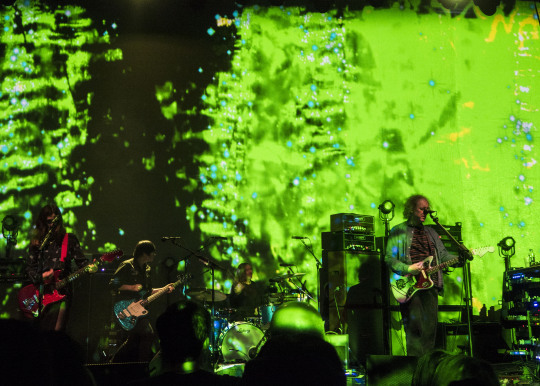
Kevin Shields is not a man in a hurry. With the special guests advertised on the tickets failing to materialise, the venue tweeted that the headline had a lot to get through and suggested that we arrive at 8:00pm. Most heeded this advice and on a hot summers evening, the hall was already full by this time, bodies uncomfortably close adding to the oppressive heat so that beads of sweat could be seen on those near the stage. Then we waited .... and waited, conversations that had earlier shown an enthusiastic level of participation had dried up leaving faces gazing hopefully at the stage with just the faint sound of the background music to keep their interest. Four spotlights were lined up across the back of the stage, their brightness hypnotic in the gloom, giving some distraction from the roadies who having apparently completed their duties, would soon be back repeating the task to the exacting standard required. Pieces of paper were frequently exchanged, one suspects they held the setlist but once taped in place, another would soon appear, even at this late stage, the order being changed until it was just right. Then, Kevin Shields has never been a man in a hurry. Over the course of three decades, the band he put together to realise his vision have managed to complete just three albums and a handful of EPs and singles. This included a gap of nearly a quarter of a century between albums numbers 2 and 3 during which others built entire careers, governments would rise and fall, planes didn’t fall from the sky in the new millennium and even the never ending sale at Allied Carpets came to an end when the company went into administration. Once contemporaries of Nirvana and The Stone Roses, they would find their latest opus alongside Katy Perry and Miley Cyrus; not that this passage of time can be heard. The sound is of its own, existing in an unchanging world that only incidentally infiltrates our own to leave its apocalyptic imprint. It is as if a chord struck in the early nineties was left to reverberate over the years until being picked up again many years later.
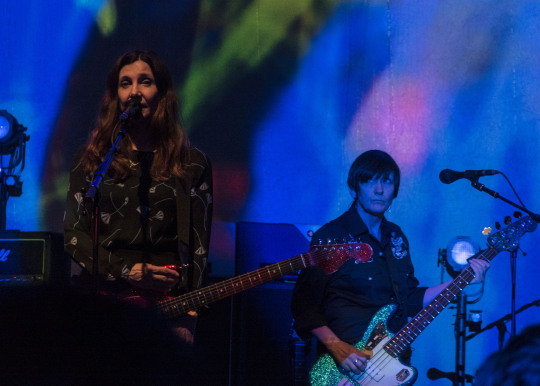
The level of productivity is pure slacker but is mostly based on Shields’ unrelenting perfectionism. Whilst the 1991 album “Loveless” is now, contrary to its title, widely loved, it was not by the record label who, frustrated by delays and production costs, dropped the band following its release. Its creator, however, still seems to very much regard it as a work in progress and its rerelease was delayed by four years as he continued to tinker until he found that elusive sound that only he could understand. Marking their first appearance in five years, this concert shows the same painstaking attention to detail and despite seemingly having been prepared, there are a number of interruptions when Shields feels that the sound isn’t what it should be. Inevitably when the number starts again the difference is imperceptible to everyone else and whilst Shields himself seems to hear it, you feel that it is still not quite right. Then this was really what this show was about as the following day will see them at The Festival Hall as part of the Robert Smith curated Meltdown and this is the hastily arranged warm-up. Rather than an overwhelming desire to play in Brum, the Institute was no doubt chosen as it was a convenient venue that had a gap in its schedule but when I received an email about three weeks before announcing the concert, I knew I had to take advantage of what was a rare opportunity to experience the MBV. Convenient it may have been but the Institute has its own sonic vagaries that seemed to cause Shields so much frustration, even during the parts that were allowed to run normally, he would often be engaged in animated discussion with the technicians or stand with his ear pressed against the stack of Marshall amps in attempt to isolate that elusive moment of sonic perfection.
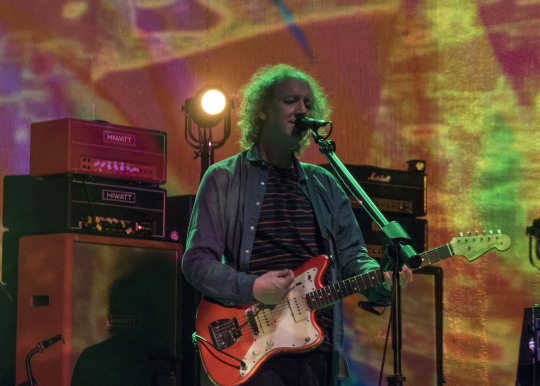
Loud, it was loud. Having passed through security and having our tickets scanned we are handed a small packet that contains two foam ear plugs and once inside one of the security team walks around advising us that we should wear them. We decide that, at our age, we no longer have to prove our mettle and put them in but the orange foam can be seen in the ears of even the younger members of the audience, that is aside from those experienced in the MBV who have brought their own. This may all sound a bit “elf and safety gone mad” were it not that we saw The Jesus and Mary Chain at the same venue last year where no one felt the need to provide us with foam ear buds not to mention Shields stint with “Xtrmntr” era Primal Scream which has to be the concert that caused the most long term damage to my hearing. Rather than noise level regulations, then, it is the band themselves who insist on the ear protection and it certainly helps to introduce a level of apprehension as you contemplate the battering your senses are about to receive and wonder whether you will leave the same person as you were when you went in. At the start of “Cigarettes In Your Bed”, Shields exchanges his Fender Jaguar for an acoustic guitar, usually an indication of calmer waters and a bit of deeply introspective folk. Instead it triggers another brutal assault, the vibrations of the strings carried through an array of effects pedals and a stack of speakers until it emerges shaped and distorted into the maelstrom. This does, however, serve to show that there is more to MBV than just sheer volume, the sound is distinct, it gives a different feel showing the texture and nuance that helps to justify the laborious methods through which it is produced and the volume at which it is played.
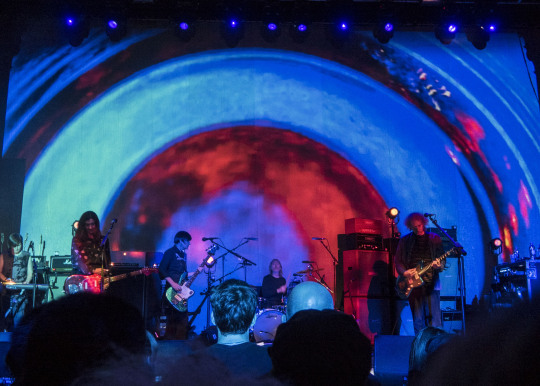
Two microphones are set across the front of the stage behind which Shields and fellow guitarist and singer Bilinda Butcher add their voices to the mix. MBV, however, are not really about words and the levels of the vocals are set so low in the mix that they feel like a ghostly voice that has appeared from another dimension. It is the feel of the music that is important, how the guitar assault plays on our emotions: I’m sure someone has deciphered the words but knowing them certainly won’t enhance, and maybe even detract, from this. Butcher stands close, mouth pressed against the microphone and only changing her position once to add some keyboards. Behind her, an array of speakers in front of which Debbie Googe adds the rumbling bass, the depth of the which sounds surprising given that she seems to play most of it on the higher frets. Drummer Colm Ó Cíosóig occupies the gap between the speakers leaving the other side of the stage entirely for Shields’ slow wanderings and the pedals, effects and other gizmos he uses to coax the strange sounds out of the six strings across which his fingers move. A fifth member of the band is hidden away in the corner, occasionally adding the repetitive signatures that identify the numbers or a burst of additional guitar. Whilst the space he is given represents Shields creative input, MBV are very much a band. Ó Cíosóig and Googe are a formidable rhythm section; despite its apparent disregard of many conventions, the music is structured around a regular, if changing, beat that Ó Cíosóig uses his sticks to count in, something that seems surprisingly rock ’n’ roll. With her demure expression and dressed in a smart blouse, long skirt and heels, Butcher could have be heading out for an intimate meal before taking a wrong turn and finding herself here. Her sweet voice manages to sound both equally incongruous and just right whilst her playing is an integral part of the twin assault of the two guitars.
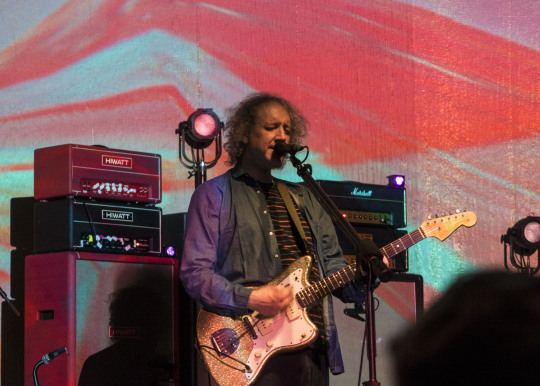
A burst of feedback and the screeching “I Only Said” signals that this assault has begun and that we are at the point of no return. Patterns play out of the screen behind, projected from the balcony so that the colours fill the whole room whilst the faces of the musicians remain obscured in shadow. In a way this seems appropriate as the sound does seem a little muddy, the playing is wonderful, particularly Googe’s bass and the fills provided by Ó Cíosóig but overall it doesn’t quite capture the magic of the recording. “When You Sleep”, another from “Loveless”, follows but again, by now to Shields’ obvious frustration, doesn’t quite hit the spot. Two thumping drum beats start “New You” and eventually things begin to click with a wonderful lumbering baseline from Googe securing the carefully constructed textures that are starting to emerge. The technical problems weren’t completely over but after a few false starts, things did pick up and where they didn’t, Shields accepted that he had to live with them. The sound problems persist through the favourite “Only Shallow” but when it does gel to we get the overwhelming thrill that we were expecting. The multi layered “To Here Knows When”, played almost solo by Shields, was far noisier than its recorded version and the surprisingly bright melody of “What You Want” managed to make itself heard amongst the thrashing feedback of the chords. “Slow” found a thumping solid beat and a deep grungy bass and the urgent repeated hook of “Soon” made it a brilliantly infectious highlight. “Wonder 2” saw Ó Cíosóig abandon his drum kit to add yet another guitar to the white noise that drowned out the programmed beats before returning for the thrashing “Feed Me With Your Kiss”. The thrilling finale of “You Made Me Realise” was immense, once upon a time it was 3 minute, fairly conventional, aside from a few seconds of noise, song very much of its time. Since it has grown to the immense, tumultuous storm that it now is; the conclusion that MBV fans call the holocaust. Ó Cíosóig pounds at his drums, Googe’s bass is felt rather than heard and the searing feedback of the guitars is relentless is its terror.
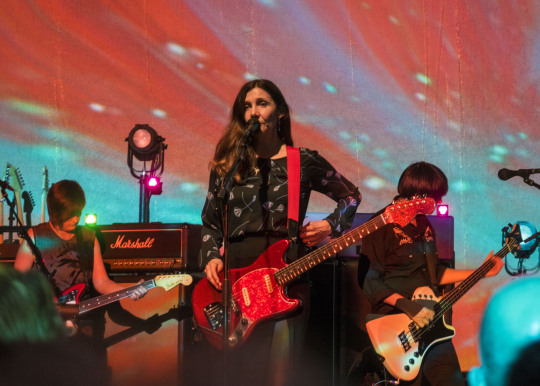
By now we had made our way to the back of the hall in order to make sure we would get to the station in time to catch the last train. Leaving, I remove the foam from my ears and we are soon able to hold a conversation without having to overcome any ringing. The protection they offered was probably minimal and they are given out more for effect but they did at least seem to cut out the noisier aspects of the holocaust. After five years away there was always likely to be a rehearsal element and the false starts and technical problems did make for a show that at times seemed shambolic but in a way it was ever thus. Despite all that, it was enthralling, bizarre and quite unlike anything else you will hear. The perfection of the sound in Shields head is something he will never be able to achieve but his quest is fascinating and occasionally we get to hear it. It could be a while before we get another opportunity.
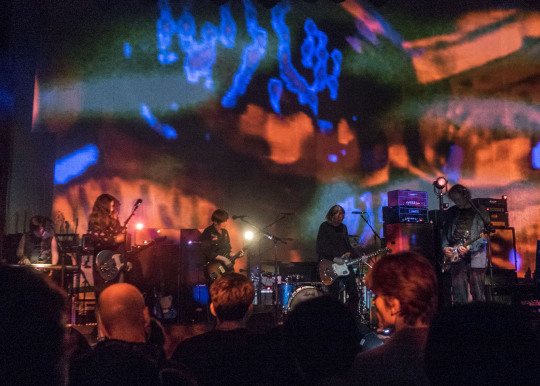
1 note
·
View note
Text
Paul Heaton & Jacqui Abbot/Billy Bragg
Westonbirt Arboretum, Gloucestershire Friday 15th July 2018
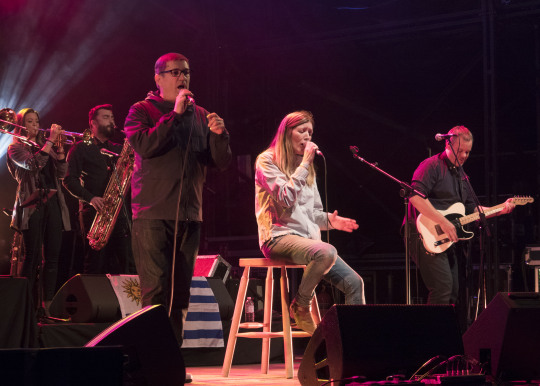
Towards the top of the long steep hill, the road takes a sharp left turn where through a gap in the hedge we can look back at the lowlands we have left behind. The Severn glistens in the summer sun, swelled by the water that has drained into it to leave its mark on the landscape that it has shaped. Alongside it, a mosaic of green fields lie on the flood plain and beyond these rise the hills of the border region, lands that carry the memory of the brutality on which nations are built. Reaching the top, the road slowly descends, we have climbed the escarpment that forms its western edge and are now driving through the Cotswolds, the iconic English landscape of rolling hills formed by the distinctive yellow jurassic limestone on which it is built and chocolate box villages. In the fields, the lush summer grass has been collected into huge bales, wrapped up in green plastic and piled up in the corner and in the distance the needle of a church steeple can be seen against the blue sky. A perfect summers evening, everything should be right with the world: then a sharp reminder that even here, it may not be. As I take in the scene around me, I notice the angular shape of three swifts, the scythe of their wings working independently as they follow the flight of the insects on which they feed. This shouldn’t be unusual, the aerial ballet of swifts and their eerie cries should be familiar in the summer skies but these are the first I have seen this year. Cold weather in April and the loss of suitable nesting sites may have played their part but the main problem is that this pleasant green landscape around us is devoid of insects, inconvenient hindrances that have to be eradicated as the efficiencies of the production line are applied to agriculture. The scene may seem reassuringly familiar but it is one in which it is becoming increasingly hard for the natural world to find a niche. I already tell others about how I used to be able to sit in the back garden and listen to a cuckoo, something that is now only a distant memory. Maybe it wont be long before we all we have are memories of other summer visitors who made their epic journeys from Africa to raise their young amongst us.
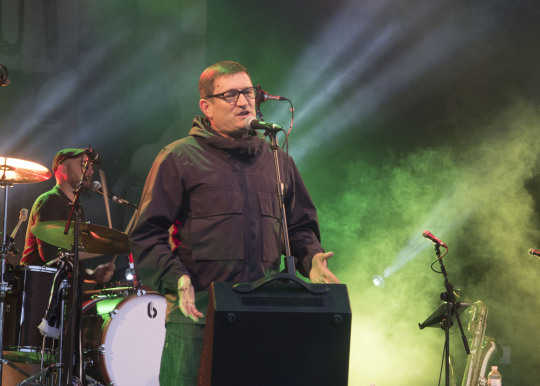
Swifts, swallows, house martins: summer visitors more at home in the air than they are on land and all sadly becoming absent from our skies. And with a link so tenuous it is worthy of a cringe, it also takes us to the reason why we are making this journey through what is arguably the most green and pleasant part of this green and pleasant land. In the early 80s, a young man who liked to refer to himself as P D Heaton was dividing his time between writing songs and making a round trip of over 700miles from his home in Surrey every other weekend to watch Sheffield United. Relocating to Hull, he felt his work needed an audience and with a friend, Stan Cullimore, he began to busk around the shopping centres of the city. It may well be there that the first performance “Happy Hour” was greeted with indifference or irritation as shoppers desperately tried to avoid the eye contact that would oblige them to drop a few coins in a hat. The duo also recorded a demo tape, a copy off which, Heaton tells us tonight, they sent to Billy Bragg who, despite a reputation that now sees him introduced as the hardest working man in the business, found time to give it a listen and bring it to the attention of his record label. This interest required a rhythm section to fill out the sound, cue the arrival of the the future Fatboy Slim, and a name, which of course was The Housemartins. Bragg undoubtedly received such tapes by the sack full, most of which would offer little other than rudimentary punk thrashing and sixth form political slogans which meant that the sunny melodies, witty lyrics and Heaton’s clear high pitched voice would have immediately stood out. The lyrics, which cleverly and mostly discretely referenced marxism with a little Christianity thrown in, would have immediately captured Bragg’s interest but just to make sure, they included the song “Flag Day”; a wake up call where the feel good act of charity is used to avoid any real change in a society that can tolerate such high levels of inequality. It is a theme that is still very much on Heaton’s mind when tonight, he asks how many of the crowd will return the next day to see Gary Barlow. Few are but the mention of his name is enough to provoke a rant about his tax affairs and how in a few months time he will be appearing on “Children in Need” encouraging youngsters to empty their pockets to support a hospital that “wouldn’t have to close if he paid his fucking taxes”.
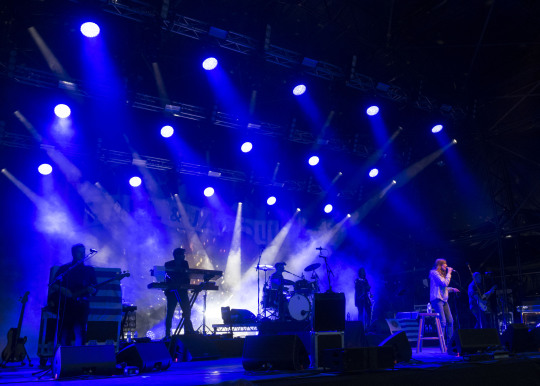
Like The Smiths, The Housemartins eschewed the styles of the time to produce bright, guitar based pop that that often disguised a serious message. Also like the The Smiths, they were not built to last and after a few singles, a couple of albums and a Christmas number 1, they disbanded, although unlike their Manc contemporaries they apparently remain on good terms. Heaton reflects on these early days during this 90 minute sell out show at Westonbirt Arboretum, in addition to noting the support Bragg gave them as they were getting started, he also reminisces about their first appearance on “Top of the Pops” where, convinced that theirs would only be a temporary stay at the top, they pestered their fellow acts for autographs. A couple of his early songs also find their way into the set, the exhilaration of “Five Get Over Excited” disguises the sinister lyrics, “Feigning concern, a conservative pastime” seems particularly apposite now, as does the flock mentality in “Sheep” in an era fuelled by a growth of rampant nationalism. The songs are mostly left to speak for themselves but Heaton does set the context of “Caravan of Love”, the final encore, explaining how he still remains proud of this acapella version of the Isley’s song and how its message of hope is one that still resonates. The encores also include a wonderfully exuberant run through “Happy Hour”, complete with giant balloons that roadies had to continually bat back into the audience so that the song could continue unhindered. Again the bright pop of the music hides that the song isn’t really about what you think it is about; a brilliant take down of 80s yuppie culture that could equally apply to millennial hipsters; “I think I might be happy if I wasn’t out with them”.
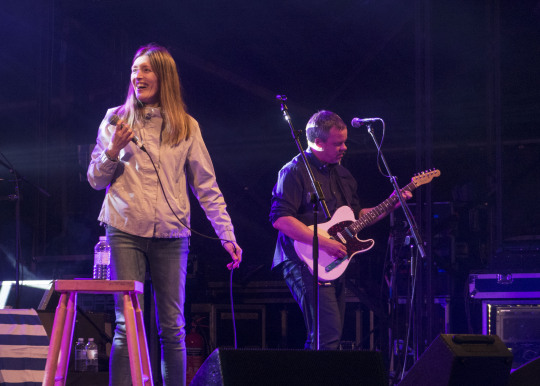
The Housemartins, for those of us who are of an age to appreciate the context, were important in showing that music could be much more than the programmed beats of Stock, Aitken and Waterman; something that dominated the charts then and the start of using technology to produce formulaic songs cynically built around familiar melodies and hooks. They are not, however, the main reason that so many have made their way to this Forestry Commission gig in rural Gloucestershire. Thanking the audience for their support, Heaton notes that of all the gigs on this forest tour, not only was this the first to sell-out but also that more tickets were released which were also quickly snapped up. This most conservative region of the country may not seem the natural setting for pop that makes little attempt to disguise its left wing inspiration, the car park is in the vast expanse of the grounds to the Westonbirt School hammering home the privilege against which much of the music is set, but comments by Heaton or Bragg on issues around Brexit, Trump, climate change, unions or inequality drew nothing but cheers from the crowd. Heaton does explain how in their gig at Thetford Forest, a fight had broken out between two people who had different views on Brexit, unfortunately, he notes, “the pro guy was ours”, but everyone in Gloucestershire was either on message or if not they kept their opinions to themselves. This popularity, even amongst those who do not share his politics, is because he would soon eclipse his early achievements by forming The Beautiful South from the remnants of The Housemartins. Still built around his distinctive voice and showing the same social and political context, the sound was, however, very different. The lyrics became more nuanced, often delivered in bittersweet tales that, despite being laced with irony, still managed to sound wistfully romantic. We cared about the subjects of these songs because their stories were told so clearly and the bright catchy melodies and beautifully inventive arrangements set them off perfectly. It proved to be hugely successful, their compilation “Carry On Up The Charts” gave him another Christmas Number 1 and they were soon to be found on the arena circuit. It is what has given those gathered here tonight a chance to relive their youth and half the set is made up of songs from the South.
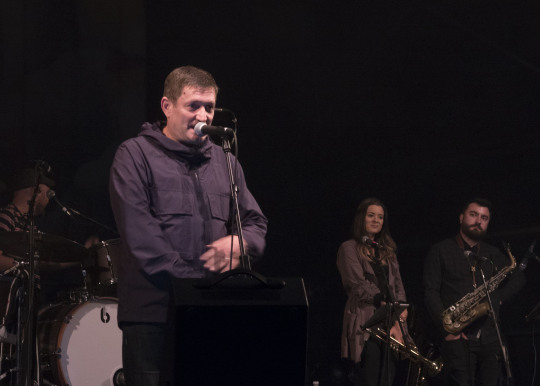
“I’ll Sail This Ship Alone” is a reminder of just how well the songs can place themselves in the mind and how now they can stir such warm memories. Built around a mournful piano accompaniment, it is essentially a break up song where the hurt is carried through the sublime melody. Yet there is also defiance, this is not the end of the world, they will survive, they can be alone. The clarity and pitch of Heaton’s voice adds the melancholy that this gives the song its heart and, despite its size, the audience are quiet and appreciative allowing the words to drift out into the clear evening sky. The set is filled with many equally poignant moments, “One Last Love Song”, “Old Red Eyes in Back” and “Song for Whoever” all leave their emotional mark and even more upbeat songs such as “Good as Gold (Stupid as Mud)” and “You Keep It All In” carry an underlying sadness. The contribution of Irish singer, Briana Corrigan, to the South’s earliest songs persuaded them to promote her to a full band member, thus providing a female lead in the domestic dramas they were playing out. When she left in 1994, partly as a result of some of Heaton’s less than sensitive lyrics, she was replaced with a supermarket stacker from St Helens called Jacqui Abbott, thus starting a partnership that is still going strong tonight. Abbott covers Corrigan’s vocals well on “A Little Time” and “You Keep It All In” but her voice, fuller and with a more resonant lower range than Corrigan’s, gives the songs a slightly different feel. Despite suffering from a bad back, her movement is severely restricted throughout and she has to sit during the middle of the set, she is still wonderful on the two songs she originated, “Rotterdam” and the delightfully naughty “Don’t Marry Her”, Heaton checks before she sings this whether we are alright with the “explicit version”.
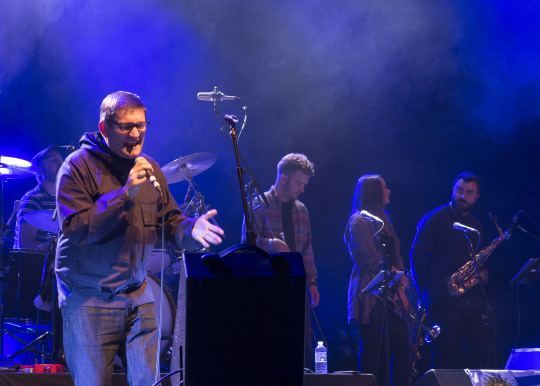
With Abbott leaving the band in 2000, The Beautiful South continued for a few more years producing two more albums that showed that Heaton could still craft catchy and quirky songs, of which “Manchester”, a sodden tribute to his adopted home, is performed tonight. A conversation on Facebook, however, brought him back in touch with Abbott and a collaboration that is now into its fifth year and has produced three albums. Starting with “I Don’t See Them”, they play with the introduction allowing Heaton to act as the preacher building up the responses from the crowd. The band are quickly into their stride, tight and precise, the song driven along by the thumping beats that give the rhythm. The humour of “DIY” is fun, gently mocking men of a certain age who spend their weekends at B&Q, providing a companion to Billy Bragg’s “Handyman Blues” that he had performed earlier. Their most recent album, “Crooked Calypso” showed that Heaton retains the ability to write droll pithy lyrics that cover obesity, “Fat Man”, race and religion, “The Lord is a White Con” and inequality, “People Like Us”. Its not all about social injustice, however, with “I Gotta Praise” being a heart wrenching love song worthy of the South. They even managed to introduce a new song, a reflection on the music of artists such as Marvin Gaye that helped the young Heaton to form his own musical ideas.
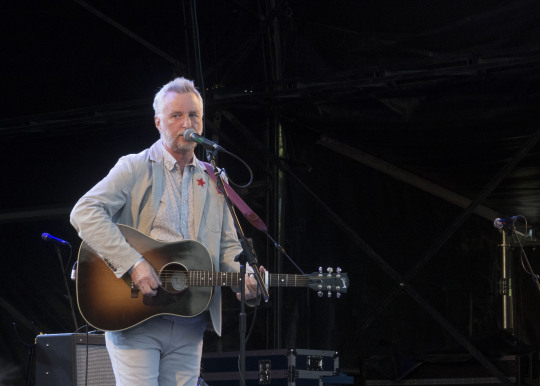
With so many gathered, the potential threat means that even in a remote location, there is still a high level of security to enter the site. This means that many are still queuing outside when Billy Bragg takes to the stage but the show must go on. Rather than a support act, he is probably more of a joint headline and a large group of fans have collected around the stage to give him an enthusiastic reception. Occasionally accompanied by the atmospheric slide provided by CJ Hillman, he is on fiery form, channelling his anger into songs that tackle environmental issues, “King Tide and The Sunny Day Flood”, immigration “Why We Build the Wall”, workers rights, “There is Power in a Union” and a state of the nation updating of Dylan’s “The Times They Are a Changing”. In between, he continues his role as the curator of Woody Guthrie’s legacy with interpretations of “I Ain’t Got No Home” and “She Came Along to Me” and there are plenty of favourites, “Levi Stubbs Tears”, “The Milkman of Human Kindness” and, of course, “A New England” complete with the Kirsty McColl verse. Introducing him at Latitude a few years ago, the announcer said that no festival is complete without Billy Bragg being on the bill and it is difficult to think of a park or field he hasn’t at some time played. Then he seemed a little restrained, toning down the politics and mainly focusing his songs that dealt with relationships. It would be nice to say that seeing him return to his impassioned best was something to treasure were it not for that the circumstances that have fuelled his anger are so desperate.
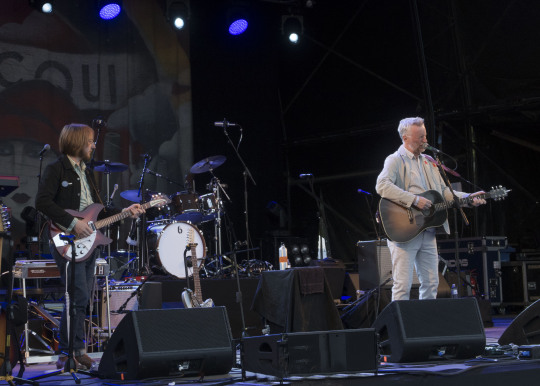
There are many so many reasons to treasure a show as good as this, the inventive songs, the exquisite playing, the humour and the engaging personalities of the performers, but another is that it is difficult to think of younger performers who in future will, through their music, provide a commentary for the times in which we live. The other Forestry commission gigs this year include Gary Barlow, Paloma Faith and George Ezra who whilst they mostly make perfectly pleasant music, show little inclination to ask questions about the nature of the society in which we live; aside, of course, from Barlow’s tax status. Then, it is difficult to think of a young Bragg or Heaton being able to make their way in the music business today which seems to be ever more built around safety and predictability. There are no doubt those who try but to take their message beyond a dedicated few, they need the support that they are unlikely to get. Thus, as he has been doing for years, it is left to artists such as Billy Bragg to highlight to injustices heaped on the Windrush generation or the children taken from their parents at the US border. Music and the arts are central to our culture, both reflecting and shaping the world in which we live and in its way this tradition is as English as the Cotswold setting. And that is why we should be grateful that those we have seen tonight continue, as Heaton puts it, to be a thorn in the side of the Tories. Long may it continue.

0 notes
Text
The Rolling Stones
The Ricoh Arena, Coventry Saturday 2nd June 2018
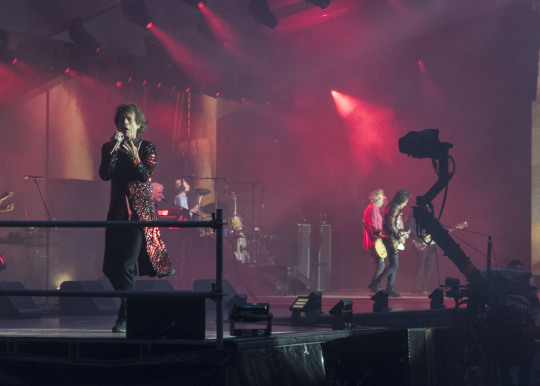
It was the lime green suit I remember. Amongst the black leather, denim, kaftans and hippy chic it stood out, which was what the flamboyant character wearing it had wanted. Whilst most had dressed anonymously and practically, for his day out he was going to be seen. He didn’t need to be so extravagant, however, as he was always going to stand out; vast the crowd was but it was not only the brightness of his threads that made him noticed. Whilst those around him in the crowd, those on the stage, those behind the scenes putting it together, in fact pretty well everyone else was white, the man in the green suit was black. Perhaps in anticipating this, he decided that as he carefully put on the suit, tucked in the shirt, sharpened the creases in the trousers and adjusted the lapels of the jacket, to also put a gun into his inside pocket; after all even those still living in the summer of love weren’t averse to a little racism but as it turned out there would be far more sinister forces at work that day. As the sun went down and with the surprisingly small stage barely lit by the lights that had been put up around it, he managed to make his way to the front of the crowd where he makes his first appearance, dancing and looking up towards the figures a few feet above him. When he appears again a few seconds later we see him being stabbed and by the time we see him for a third time being loaded onto a helicopter to take him away, he is dead. We don’t know exactly what happened but as the grainy footage is replayed in slow motion we see him reach into his inside pocket and start to take out the gun he had brought with him. As the blonde girl he is with tries to stop him, the Hells Angel standing just behind him brings down the knife in his hand so that the blade sinks into his neck. The stabbing continues as he falls to the ground where he is lost amongst the leather clad Angels who have come to join the fray. He manages to cling onto life for a few moments after he is dragged clear but the severity of his injuries means that his role in the film was to provide its chilling and violent conclusion.
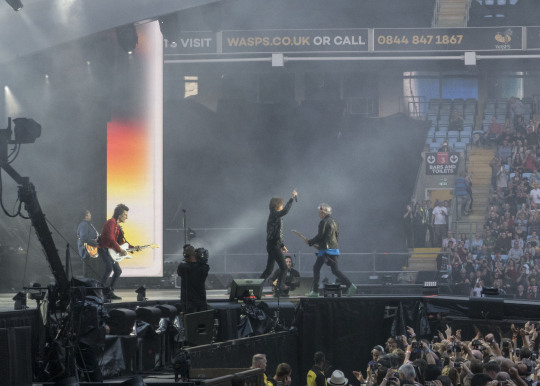
I first watched this scene projected onto the largest of the then three screens at the Classic cinema in Quinton. As a child, it was somewhere I would visit almost every week; a regular family outing that was usually on a Thursday. It was a typical suburban picture house; it opened just before the war and the art deco design was very much in keeping with those times. I first remember it as the Essoldo; just one single auditorium where my parents always seemed to manage to get seats in the middle of the first two rows of the circle where we could gaze directly at the huge screen in front of us. It was here that I first saw most of the classic Disney cartoons, rereleased just as a new generation of youngsters were able to be ensnared by the mouse, and where the sight of Jenny Agutter removing her red bloomers to stop the approaching train stirred something that I didn’t quite yet understand. Changing its name to the Classic, it ran a Saturday morning film show for children called Louis Lion’s Classic Junior Club where alongside the cartoons that we were really there to see, they also showed some of the Children’s Film Foundation movies that appeared on Screen Test. We queued to see “Diamonds are Forever” and “Live and Let Die” but little other than Bond could fill all those seats and it would soon be divided into three smaller screens. The largest of these was still capable of giving the scale and spectacle of the Star Destroyer as it closed in on the tiny craft in its path and the stunning graphics of the opening credits to “Superman”. By now, however, I was becoming increasingly intrigued by those films that were rated for an age that I hadn’t yet reached and as they never seemed to bother asking for proof of age, The Classic gave me an opportunity to feast on this forbidden fruit. We gorged on the horror of “The Exorcist”, the violence and seediness of “Taxi Driver” and the overwhelming terror of “Apocalypse Now”, films that we would leave reciting those memorable lines: “you looking at me”, “I love the smell of napalm in the morning” and “your mother sucks cocks in hell”. Whether this premature exposure to the disturbing themes of these pictures had any long term effect on me it is probably for others to say. They were all, however, notable films but not all of this furtive behaviour was for high art; we were adolescent lads and one of our first forays into the pleasures of adult cinema was to see something much more carnal; “Emmanuelle”. The approach to the box office was worked out with military precision; rather than arriving as a group we decided we would have a better chance if we bought the tickets individually and being the tallest I was sent in first. With the transaction completed, others would get theirs, the order being decided on how old we felt each person looked. In the end we all managed to get in but making our way up the stairs we ran into another problem when we found ourselves face to face with the mother of one of our friends. Nothing was said but it didn’t have to be; “wait until your parents hear of this” was left in the air as the unspoken threat which meant we never mentioned this encounter. It never occurred to us that she would be the one who was most embarrassed about this; we were the target audience for soft porn like this but what was she doing there.
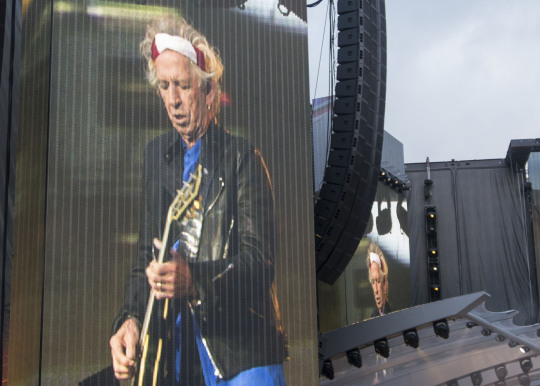
As the decade wore on and audiences declined, other attempts were made to draw people in, one of which was a post pub screening of films with a more selective appeal on a Friday evening. This probably sounds as if it was another attempt to draw in adolescent boys and lonely men who like to start their weekend with a drunken wank but it is unlikely that this would have attracted the size of audience they wanted. Record companies and studios had been pushing musicians into films for as long as the moving images had been recorded and whoever the manager of the cinema was at the time decided that this Friday night slot was a good opportunity to showcase some of these. The queues that formed outside well before the start time showed that it was an inspired move and whilst at other times of the day you would often find yourself alone, for these screenings the auditorium was invariably packed. It was in there that I first saw “The Song Remains the Same”, “Tommy”, and the unlikely brilliance of Slade in “Flame” where the black country pop yobs pull off a film as dark as “Performance”. The film, however, that I remember most clearly is “Gimme Shelter”, a record of The Stones 1969 tour of America. Following the drug busts and an ill judged attempt at their own summer of love psychedelia, “Jumpin’ Jack Flash”, had put them back on track and clips from the shows at Madison Square Gardens show that they had become a formidable live act. The film, however, needed a grand finale and the real focus is the ominous build up to what was planned to be the west coast Woodstock that would provide this. It was anticipated that the event would be huge, it is estimated that over 300,000 attended, but the planning, bogged down by an unhealthy mix of laid back hippy attitudes and greed, was never up to something of this scale. With Jagger announcing the date of the festival at the New York shows, there was still no location as the negotiations for the original choice in Sonoma had broken down when the owners demanded a share of the film’s profits. With a few days notice, an asphalt track with no toilets and littered with the rusting hulks of abandoned vehicles from demolition derbies was chosen; its name, Altamont, soon coming to represent the death of 60s idealism. With a stage that was just four feet high and lighting that had to run off the site’s limited electrical supply, it is doubtful that most of the audience would have seen or heard much of what was happening on it leaving them to get crazed up on alcohol and the plentiful supply of bad psychedelic drugs. A single rope was the only barrier between the stage and the audience leaving the safety of the performers in the hands of the Bay Area Hells Angels who had been drafted in to provide security. With their Harleys lined up across the front of the stage as a bulwark, their only response to the repeated stage invasions was to use the pool cues they had bought with them to batter the crowd; when Marty Balin of Jefferson Airplane tried to intervene he also received a beating.
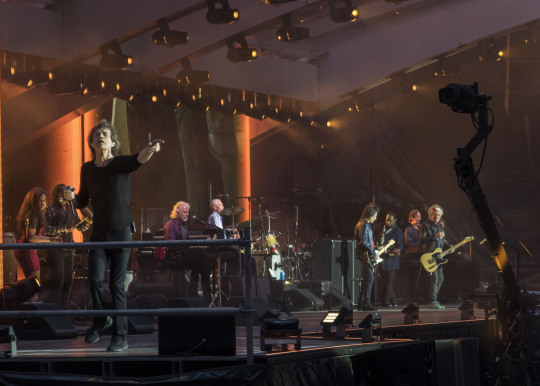
By the time The Stones take to the stage, the consumption of alcohol and drugs without any food or water and the periodic beatings have left the crowd in an ugly mood. The song that most seemed to embody this atmosphere and the outbreaks of violence that resulted was “Sympathy for the Devil” and they do have to abandon the performance of this as the cue wielding Angels make another foray into the crowd when they see some are sitting on their hogs. The dark mythology of the song, however, has it that it also provided the soundtrack to the fatal stabbing although this occurred later during “Under My Thumb”. The myth would prove to be stronger and the song helped to build an aura around the band where they became not just naughty boys with a passion for mars bars and strong drugs but dark satanic lords in league with Lucifer himself; this was in no doubt helped by them citing its bad karma as a reason to leave it out of their set for over seven years after Altamont. Occurring at the end of the film, there was a foreboding inevitability about the killing but what made it so shocking was that it was something I watched in a place that was about presenting illusions, fantasies that capture the imagination allowing us to escape for a couple of hours from the random complexity of everyday life. Even the murderous intent of Travis Bickle or the shadowy world of Colonel Kurtz were a product of the imagination of the director and created by actors. Here, however, the film shows someone losing his life in front of us, a real life and death story intruding into this artificial world.
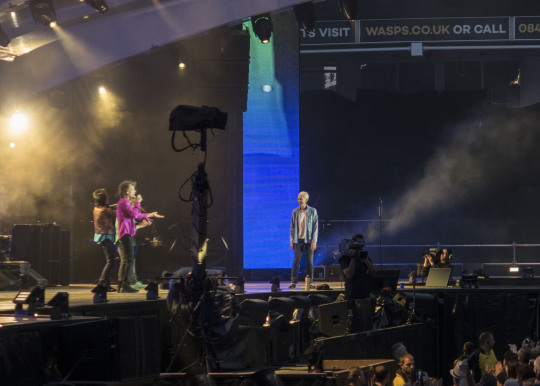
Nearly fifty years after these events Charlie Watts starts the menacing samba rhythm that opens the portal into the dark heart of The Stones, “please allow me to introduce myself”. Here, however, the mass of humanity is divided into sections, as well as those occupying the stands, the pitch area is fenced off into into three so that those getting closest to the stage have had to shell out an eye watering amount for their advantage. Yellow shirted security patrols both inside and outside the arena, as far as I could see none were brandishing a pool cue and the thorough searches made it impossible to bring in even a small umbrella let alone the gun Meredith Hunter had taken along. The stage rose to a height of at least four times the flimsy surface on which they performed at Altamont meaning that invading it was well beyond the ageing limbs and joints of most of the audience. It was as well ordered and safe as it can be but as the barriers and armed police around the site show, the coming together of so many people means that the risks cannot be completely eliminated. At this distance from the turbulence of the time in which it was created, “Sympathy for the Devil” could be a museum piece, lovingly recreated but lacking any of the dangerous context it once had. And yet those tribal rhythms and spooky “whoo whoos” are still unsettling, even after all this time it can’t quite break free from the myth. Jagger, who had recently returned to the stage after a mini break during Keef’s two songs, played his part, dressed in a long red frock coat and manically contorting his limbs into shapes that no one of his age should be able to pull off to ensure that the sinister intent in the lyrics is still there. It was a spectacular and quite breathtaking moment, adding a freshness to this fifty year old song that made it sound just as relevant to our own turbulent era.
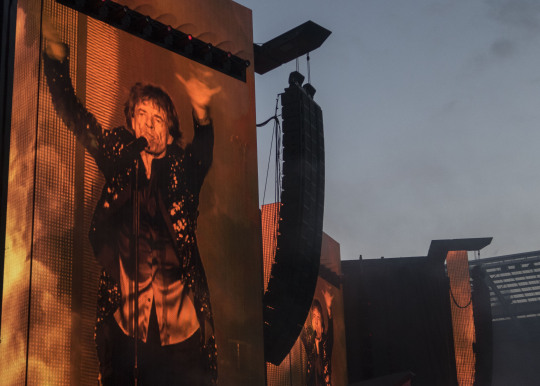
The Stones spent most of the 60s in the shadow of The Beatles but with the Fabs disintegrating at about the time “Sympathy for the Devil” appeared they seized their opportunity with a ferocious burst of creativity that saw them produce four astonishing albums and establish themselves as the foremost live act. It is the period from which much of their current set is taken starting, after the briefest of introductions, with the punchy distortions of “Street Fighting Man”, Richards immediately taking the riff along the catwalk into the audience while his partner prowls the stage behind him. With “Tumbling Dice”, however, any notion that Jagger was pacing himself was quickly dispelled by a sprint to the end of the catwalk without having to pause his vocals to take a breath. The country tinged “Dead Flowers” saw Jagger pick up an acoustic guitar for a rare moment of calm in his hyperactive storm but he quickly discards this to resume his prowling for “You Can’t Always Get What You Want”, the two backing singers perfectly capturing the eerie harmonies. Richards adds a fragile charm to his two songs, “Silver and Gold” and “Happy” whilst Jagger uses “Honky Tonk Woman” to introduce the band and an opportunity to help Charlie Watts celebrate his 77th birthday. A Keef riff is often what launches a Stones song but even for the master, there are few that are as thrilling as the one that opens “Jumpin Jack Flash”, the exhilarating rush of which brought us onto the home straight. Of course, this being The Stones, there were a few reminders of just what another country the past is and whilst some of there more misogamist moments were left out, there was no place for “Under My Thumb”, there was still “Brown Sugar”, a slave owner with a penchant for young black girls and “Midnight Rambler”, a rapist celebrated as a counter culture outlaw. Despite its questionable content, however, the latter was an unexpected highlight, an extended blues workout that managed to be looser and more absorbing than the recorded version. The images of what looked like a women’s march that accompanied a beautifully haunting “Gimme Shelter” may well have been an attempt to own up to and atone for their past and the song also gave vocalist Sasha Allen an opportunity to head out along the catwalk and show how well she could piece away.
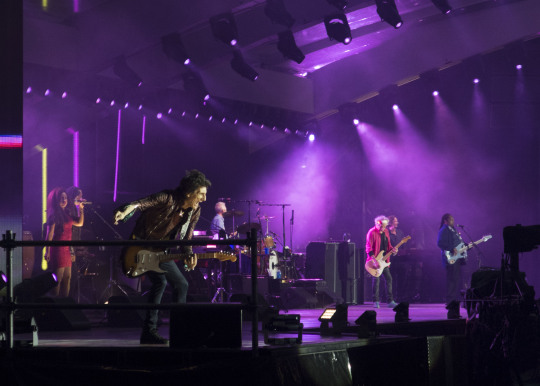
Business, professionalism, music half a century old; it could have been something programmed into a computer and played by holograms. That it isn’t and it still works so spectacularly well is because at its heart are the extraordinary characters who produced it. During “Tumbling Dice” Ronnie Wood makes his way over to the side of the stage where we are sitting, unfortunately at the same time as Jagger decided to make the same move. Seeing his path was blocked, Jagger pushes him out of the way, nothing will stop him making a move he has already started. It was a small incident that showed two things: first despite all the programming and planning, there was still a looseness and spontaneity about the show, there were no markings on the stage and two performers could end up in the same place because that is what happens. Secondly it also emphasised that there is still a strict hierarchy, Wood has been a Stone since 1975, many years longer than his predecessors Brian Jones and Mick Taylor combined, and the fluency of his guitar is integral to the sound, even on the songs made before he joined. He remains, however, the new boy, the one who can be pushed around, the one who could look up at the huge screens during one of his blistering solos to see the image of Keith Richards quietly strumming away. Even he, however, must recognise that it is those with whom he shares the stage who are mainly responsible for the longevity of the band. The irresistible showmanship of Mick Jagger and the miracle of human endurance that is Keith Richards, both have tried to go it alone to limited success, together, however, they are invincible. Seeing them live, however, brings home that the Glimmer Twins are only part of the story, there is another without whom the band would not exist. They carried on without Brian Jones and the person they brought into replace him, the departure of Bill Wyman caused barely a shrug but take Charlie Watts away and the whole edifice would collapse. With other drummers having to put down their sticks for good, at 77 Watts is still there on a raised platform at the back of the stage where he quietly watches everything that he is holding together. Despite the decades of going to concerts, the closest I had come to seeing the Stones was in a cinema in Quinton late one Friday night, I had even managed to convince myself that they were past it but they were never going to cross themselves off the bucket list and announcing this show at The Ricoh, one of the most intimate stadium venues, meant there was no longer any reason not to see them. Yes it was expensive, yes it was big and corporate, yes the quality of the show you saw depended very on how much you could spend but this was The Stones and as they once sang, “this could be the last time”.
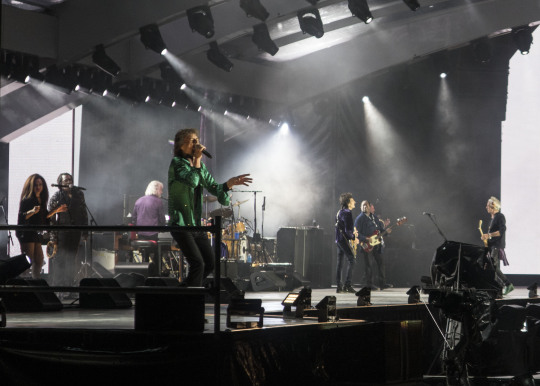
0 notes
Text
Joan as Police Woman
Stoller Hall, Manchester Tuesday 24th February 2018
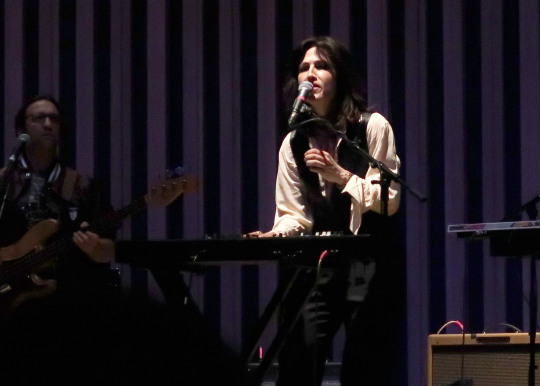
February 2011. Cyclone Yasi battered the coast of Queensland, Julian Assange was facing allegations of rape that would see him spend most of the following years holed up in the Ecuadorian embassy, “The King’s Speech” won the Academy Award for best picture, the last surviving World War 1 veteran died in West Virginia and the BBC had to apologise for comments made about Mexicans during “Top Gear”. That tragedy was always ready to strike was seen when an earthquake in New Zealand killed over 100 people but the events with with the most lasting consequences were to be seen in North Africa and the Middle East. The Arab Spring protests in Cairo that were soon to bring an end to the Mubarak administration had spread to other countries, often provoking a vicious response from the Government. The Libyan air force launched airstrikes on crowds of protesters leading to the UN imposing sanctions on Gaddafi and a no fly zone being declared over the country. The uprising spread to other states including Syria where dissidents called for a “day of anger” against the Assad regime. Despite the brutality in Libya, it was still possible to have some optimism about how these events would unfold, a movement of ordinary people calling for democracy, open Government and an end to being subject to the whims of dictators.
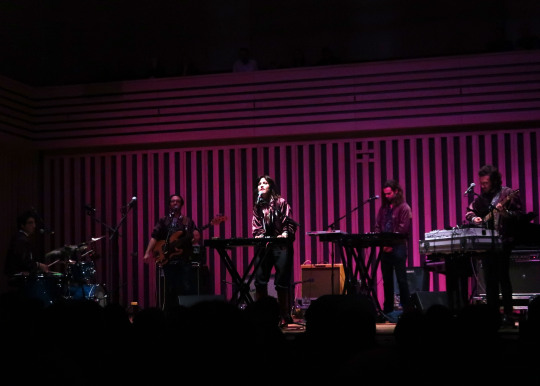
It was also in February 2011 that I last saw Joan as Police Woman. I had already seen her twice before, the first time following the release of her second album, “To Survive” and the second where she performed cover versions of songs by, amongst others, Jimi Hendrix, Britney Spears, Public Enemy and Nina Simone. On both of these occasions, I was accompanied by my wife but after booking tickets for a third concert, I was informed that she unavailable that night and I needed to find someone else to go with. This was most likely due to a work commitment but something of a Joan overload may also have contributed to her decision. Where my wife was unable to or didn’t want to go to a gig, my next concert buddy was my niece who had already developed a wide ranging and extensive knowledge and interest in music; years before when she was very young, she had arrived at our house whilst I was playing “Rocket to Russia” and immediately began head banging to “Rockaway Beach” which made me very proud. We had already seen Bob Dylan and John Grant together but as the JaPW was on her eighteenth birthday, I assumed that she would have better things to do than spend the evening with an audience most of whom would be pushing fifty. Incredibly she didn’t and as the gig was at the Glee Club, which had an over 18 policy, she would have been the youngest person in the audience, most likely by about twenty years. Thankfully Joan didn’t disappoint with a set mostly drawn from her third album, “The Deep Field” and Grace was able to leave with a JaPW t-shirt, one in which she is rather provocatively reclining on a chair with a gun resting in her lap; being an uncle means that parental censorship can be ignored.
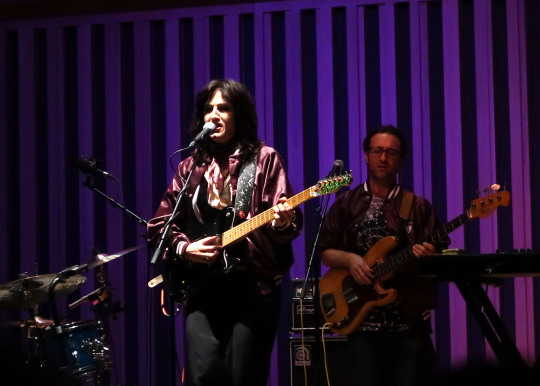
Seven years later: those southern hemisphere disasters have been filed away along with all those other acts of God that suddenly leave families bereaved, Assange is still in the Ecuadorian embassy and seems a rather seedy individual instead of the champion of free speech that he liked to portray himself as then, Clarkson’s thoughtless and confrontational manner brought his time at the Beeb to an end and he has taken his casual racism to Amazon and “The Shape of Water” has been named as best picture. The optimism of the Arab Spring has long since evaporated, leaving instead the war in Syria that has so far claimed hundreds of thousands of lives and displaced millions. Whilst the image of a dead child being washed up on a Turkish beech and the chilling use of chemical weapons have occasionally brought home the horrors occurring on the eastern shores of the Mediterranean, the conflict is now largely background noise and their was precious little compassion for the refugees arriving at the borders of Europe in an attempt to escape the slaughter. Instead, there has been a resurgence of populist right wing politics that offer apparently simple solutions to these complex problems largely based on building walls to keep the others out. On the fiftieth anniversary of Enoch Powell’s “Rivers of Blood” speech and the 25th of the murder of Stephen Lawrence, it seems as if the dragons that we long since thought were slain are very much alive and there are plenty who even try to deny that the horrors of the twentieth century ever happened.
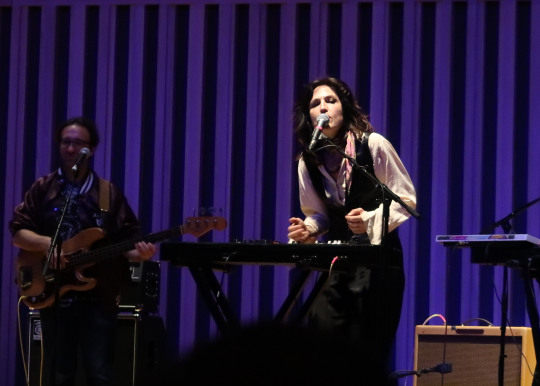
Seven years later is also when my niece and I are having some family time seeing JaPW, although as she is the one who is now economically active, I am the elderly relative who is being treated to a day out. It has been a typical Manchester day, raining from the moment I arrived and a penetrating wind that made it feel colder than it was. With my clothes soaked through, wandering around the city centre soon loses its appeal and I decide instead to spend most of the afternoon sitting in a cafe sipping Earl Grey. I am the only person in there and I soon get the feeling that the two girls behind the counter wish I would bugger off so that they can continue their conversation without having to be sensitive to the customer in their presence. We meet up for some Tex Mex and happy hour cocktails a little later, although mine was on draught and arrives in a pint glass, before making our way to The Stoller Hall and our appointment with Joanie. Built as a medium sized concert hall for Chethams School of Music, it is an appropriate venue for the classically trained multi-instrumentalist we are here to see. Like the students we see wandering around as we wait for the concert, Joan Wasser learnt the piano and violin as a child which led to her being awarded a place at the College of Fine Arts at Boston University, her prodigious talent meant that she gained entrance a year early. She soon, however, grew disillusioned with the classical world and started adding violin and keyboards to the backing bands for a range of diverse artists including Anthony and the Johnsons, Rufus Wainwright and Lou Reed. Her most personal collaboration, however, was with Jeff Buckley which led to a relationship that lasted until his tragically early death in 1997. Struggling to deal with her grief, she continued working as a backing musician but started to take a more prominent role in both writing and performing, recording the album “Debt and Departure” with Black Beetle, a band made up mostly of Buckley’s backing musicians. It was apparently Lou Reed who, in what must be the only occasion that he ever showed an interest in any musician other than himself, encouraged her to set out on her own and taking her name from the Angie Dickenson TV series, her debut album, “Real Life”, appeared in 2007.
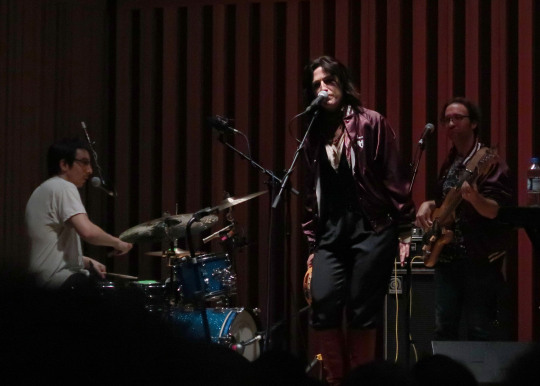
Whilst largely critically acclaimed, her music appeals to a select audience and her previous tours have been to small venues such as the Glee Club. This has meant that she mostly provided the accompaniment herself, bringing just one other musician with her to add rhythm or, on one occasion, having the backing tracks recorded on cassettes, now that really is old school. In the years since we last spent some time together, however, her popularity has grown to the extent that she has moved into bigger venues and as a result she now has a full band with her. The sounds are still very much based on what can be produced from the keyboards which she plays along with two others but there is a rhythm section to provide the beats that were once contained within a rectangular piece of plastic. With her jet black hair and the carefully assembled costumes, she and the band all arrive on stage wearing lilac tour jackets, she remains a sultry and brooding stage presence but inevitably she does look a little older than last time. In terms of the music, however, she could be picking up from where we left off, her last two albums, “The Classic” and an uneven collaboration with Benjamin Lazar Davies called “Let It Be You”, are ignored completely and aside from her most recent release, “Damned Devotion” which could be her best, the rest of the set is drawn from the songs that she performed at the Glee Club.
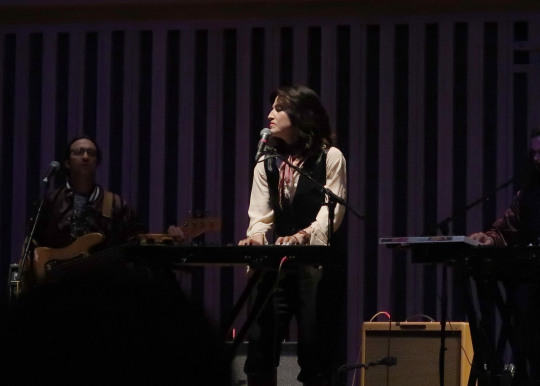
Despite the enhanced firepower, however, it is a subdued and delicate start to the concert. “Wonderful” is a smooth velvet opener, Wasser’s vocals drawing her voice into the back of her mouth capturing her fragility as she struggles to regain her piece of mind. The slight percussion finds spaces in the melody rather than driving it forward as ghostly chords hang in the air. “Warning Bell” is similarly sparse, a break up song where she wishes for finality of a tolling bell to announce the end of a relationship; “If there was a warning bell, I'd know; But all I hear is music soft and low”. With a steady 4/4 rhythm, “Tell Me” is catchier and the first song to incorporate the full sound of the band; Wasser herself picks up a guitar whilst counter melodies and falsetto harmonies delicately weave their way around the vocals. It is a fine example of her strengths; calm and wistful melodies in a beautifully arranged musical setting where voices and instruments combine perfectly, the hours spent studying orchestration were not wasted. The two older songs that follow were pared back even from the minimalist recorded versions, “Eternal Flame” and particularly “Honour Wishes” were simply breathtaking, the haunting and tight harmonies in the latter providing a really quite special moment.
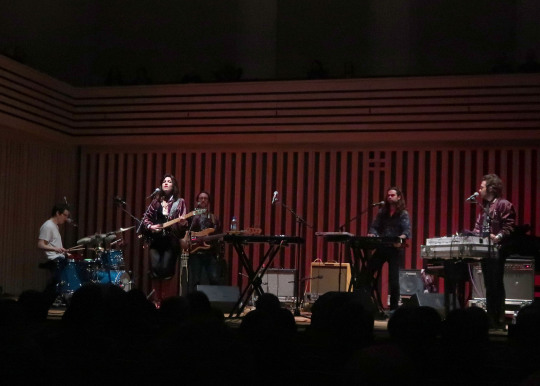
With “Honour Wishes” paring things back as far as they could go, the sound builds as she uses the rest of the set to showcase the remaining songs from the “Damned Devotion” album. Like with “Tell Me”, drums and bass outline the rhythm, although the intricacy of playing took this well beyond just laying down a beat, while the keyboards and occasional guitar filled out the arrangements and whilst it never became loud, the songs gained a harder edge compared to the restrained opening. Whilst her music has always been fascinating, words have not always been her strong point and underdeveloped and sometimes clumsy metaphors have often provided the weakest points in her albums. This is something, however, that she seems to have mastered with “Damned Devotion” where perfectly constructed lyrics work alongside the exquisite music to capture moments of raw emotional honesty. “What Was it Like” is a touching tribute to her late father which she introduces by explaining how he never passed judgement on others, noting that he would say; “I could never see what passing judgment; On anybody else would ever do for me”. The most poignant line, however, is when she notes how he always supported her musical development; “My dance recitals, they were never concise; You never missed one, you were always there for me”. His selfless devotion, together with her feelings following the death of Buckley, has provided an impossible standard against which she has found others to be wanting. The ideal of finding someone with whom she can share her life remains but this is tempered by the experience that anyone she allows in will inevitably fall short of this. A breakdown in communication is a constant, “Talk About it Later” follows the earlier songs in the set in looking at the barriers we set up to keep others out of our deepest feelings. A deep descending bass makes itself felt through “Rely On”, “Valid Jagger” and “Damned Devotion”, each dealing with the complexities of her own emotions and her interpretation of those of others. With its funky collage of high pitched vocals, frantic percussion and chopped up synthesised brass, “Steed (For Jean Genet)” is just plain filthy. The highlight, however, is “The Silence”, a darkly brooding piece, again dealing with communication but this time taking it from the personal to the political, ending with the repeated chant; “My body, my choice; Her body, her choice” that provides a chilling conclusion to the set. Alongside her most recent work she includes two from “The Deep Field”, “Human Condition” and her first encore “The Magic” that both seem a little more optimistic that her recent songs and rounds things off with an almost unrecognisable cover of “Kiss”, pared back to the point that it barely existed whilst still capturing the essence of the song.
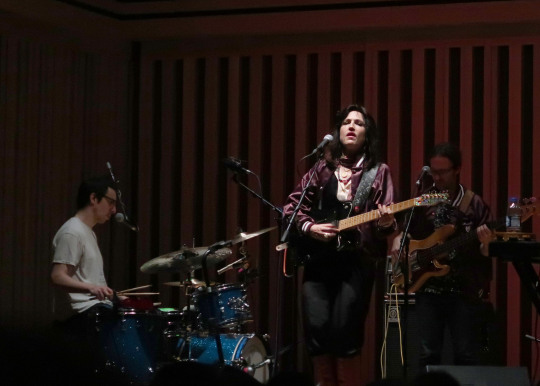
After the show and despite my age I am not above playing the fanboy and I join the queue to buy a copy of the album and get it signed whilst also asking Grace to take a photo, something I hope didn’t cause her too much embarrassment. The dark themes in much of her work made it a deeply emotional concert but also very uplifting. For years her reputation has exceeded the sales of her music and concert tickets but despite this she has been able to develop her music and a few more, at least, are now beginning to appreciate her talent. Into her late forties now, in a business as unforgiving as music she could now be considered a veteran but always being on the periphery has allowed her music to develop and she is still capable of surprising even her long standing supporters. There may not have been the intimacy that there was seven years ago but in every other respect this was a show from an artist at their absolute peak. A brilliant, moving and exciting gig which just leaves the question of who will be paying next time.
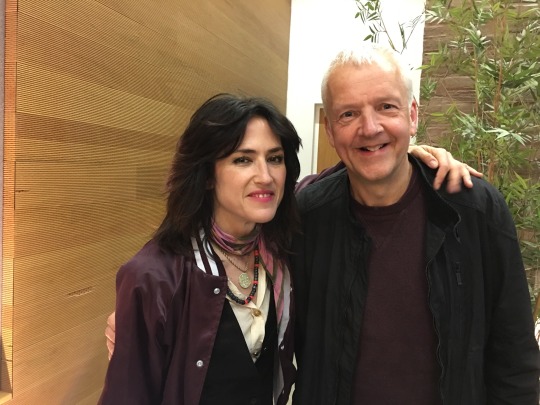
4 notes
·
View notes
Text
The Arcade Fire
Genting Arena, Birmingham
Sunday 15th April 2018
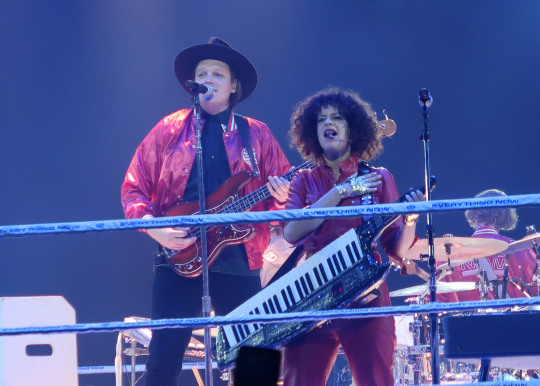
“They build it up just to burn it back down”. The large frame of Edwin Farnham Butler III is hunched over a small keyboard placed on the rotating central part of the stage as he delivers the words into the microphone in front of him. A quiet moment of reflection during the sensory overload that is The Arcade Fire’s return to this arena on the outskirts of Birmingham after a gap of nearly eight years. In the meantime they have conquered all before them, playing to audiences numbering tens of thousands in vast open air shows and headlining almost every large summer festival across the world. The words are from the song “Rococo” and as it was taken from their third album, “The Suburbs”, the one they were touring on their last visit, it was then a regular in their set. Its subdued tone and the cynicism in its lyrics, however, made it a awkward festival song and it rarely makes an appearance now, just twice before on the tour that began in the autumn of last year. The song uses the ornate, highly decorative but ultimately insubstantial art movement of the 18th century as a take down of the vapid, insipid hipster culture where modern kids are “Using great big words that they don't understand”. Whilst Butler’s words were directed those who in a desperate attempt to stay at the forefront of popular culture will discard music almost as soon as they have picked it up, it is tempting to also see it as a dig at those shapers of opinion who having loved them were starting to pick at every fault they could find; the knives that were already being sharpened then have found their target as the popularity of the band has soared.
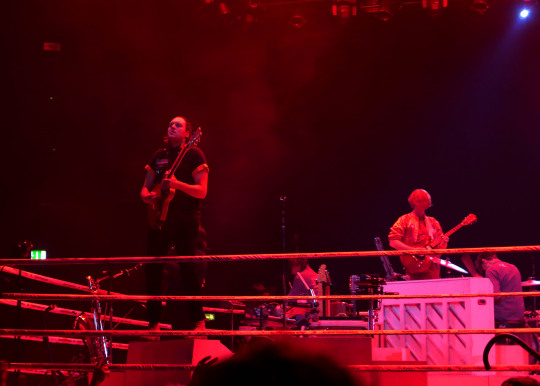
Back in the middle of the noughties they announced themselves with “Funeral”, right up alongside “Marquee Moon”, “Are You Experienced” and “Unknown Pleasures” as being one of the great debut albums. As the title suggests, death formed its dominant theme; still in their early twenties, the grief experienced as ageing relatives passed away was all the more painful as it was being felt for the first time. Whilst sickness and death may form the backdrop, however, there was also a strong sense of rebirth and renewal, seen at its most powerful in “Wake Up” where Butler urges; "Children, wake up … before they turn the summer into dust”; a reminder that glory will only go to those who dare to seize it. The complexity of its emotions, the transition through life, death and rebirth and the staggering anthemic momentum of the music led to five star reviews and an almost universal top placing in the album of the year polls. With the follow up, “Neon Bible”, three years later, the mood had started to shift and with each subsequent album they have found it increasingly difficult to elicit the praise that was heaped on “Funeral”. Inevitably their most recent, “Everything Now” has received the most polarised reviews, some noting that it sees them at their most accessible whilst others saw a dark and joyless album where the social commentary lacked the insight they had shown on their debut. Needless to say it featured in few end of year polls. The naysayers have a point, there are moments on “Everything Now” where you have to question how a band capable of producing that glorious debut could have sunk so low. The clumsy synths of “Peter Pan” would easily be the worst thing they have ever recorded were it not followed by “Chemistry” which manages too be both cloying and corny without showing any irony or humour making it significantly worse; fortunately neither are played tonight. Then if all albums were judged on their weakest moments few would achieve greatness and even at their most transitional, there are still songs of majestic brilliance which, mostly, are the ones we hear tonight.
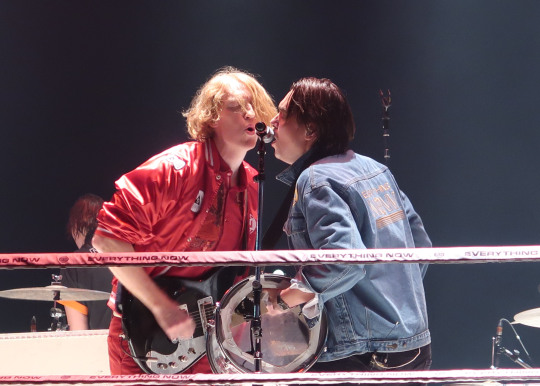
Perhaps, the critics had been too successful in identifying the next big thing and as the band outgrew their indulgence, they began to resent the success that they had helped to bring about. The band were undoubtedly highly ambitious, eagerly moving on from clubs to concert halls, arenas and beyond, writing anthems to draw in these big crowds and producing ever more spectacular shows. It no longer felt as intimate and like many before, they found that those who had championed them at first turned increasingly hostile, “they build it up just to burn it back down”. The mixed reviews for “Everything Now” are right to identify its flaws but as they began the tour to promote it, the live reviews followed a similar pattern, a reluctance to identify the strengths and an over emphasis on any perceived weaknesses. There may have been some early tour teething troubles and the corporate concept initially used certainly distracted from the music but regardless of the the opinion as to their merits in the studio, there can be no doubt that The Arcade Fire are a formidable live act. Anything that fails to acknowledge that and the enthusiasm that they can generate in their audience makes it look as it the writer is out to be negative just because they can.

Formidable they are. From the the moment the faceless cowboy projection announces that they are about to arrive the build up is relentless in its intensity, heightening the anticipation and generating fervour in the crowd. The strains of “A Fifth of Beethoven”, a nod to the disco mood of their recent work, merge into the introduction to “Everything Now” as the announcer covers their awards and achievements in the style of a heavyweight champion. The boxing analogy is carried into the staging, performed in the round with roadies holding the ropes up as the performers enter the ring. Then seamlessly they pick up from recorded introduction for a spectacular “Everything Now”; each member of the band facing out from a different side of the stage, the drummer rotating around the middle; they were everywhere, Butler’s younger brother Will even abandoning his musical duties altogether to run laps around the stage. The song stands out on the album showcasing what they are good at; a simple hook to draw you in, a bright intoxicating melody, banks of strings and piano, ghostly backing vocals and a epic scale; live it was immense. It was a masterclass in how to start a concert and as the thumping introduction to “Rebellion (Lies)” was followed by the disco groove of “Here Comes the Night Time” the only doubt was whether they could maintain such a ferocious pace and supreme quality for the next two hours.

They could, of course. There were a few quieter moments, the relatively sparse “Electric Blue” where Regine Chassagne’s falsetto soars into the stratosphere, the repetitive and moody “Neon Bible” and the aforementioned “Rococo”, and these helped to highlight just how climatic the peaks are when the full force of the band is unleashed. The driving beat of “No Cars Go” hits its groove perfectly and the doomed romance of “Put Your Money on Me” is suitably brooding and even starts with Win and Regine having a smooch. The nine piece band regularly swap instruments so “Neighbourhood #1 (Tunnels)” sees drummer Jeremy Gara taking a break from his rotations as Chassagne takes the opportunity to pound out the rhythm. He returns to share duties on the folky swing of “The Suburbs” which segues wonderfully into the urgent overwhelming surge of “Ready to Start” before giving way once again to the Regine’s eerie falsetto in “Sprawl II (Mountains Beyond Mountains)”. Light scattered from the opposing glitter balls on either side of the stage, an appropriate setting for the glam disco beat of “Reflektor” and the perfectly crafted “Afterlife” which followed. Even when it seems as if everything has already been thrown in they still manage to find something extra for the darkly flamboyant “Neighbourhood #3 (Power Out)” before they eventually make their way out through the audience, shaking hands and posing for selfies as they leave. They are soon back to show that they can do restrained and sensitive with the sombre “We Don’t Deserve Love”, the delicate counter melody provided by striking empty wine and vodka bottles. As the refrain of “Everything Now” bookends the show, the Preservation Hall Jazz Band, who had earlier played a superb support slot, return to add to a colossal rendition of “Wake Up”. With the chanted refrain echoing around the hall, the band leave as they had arrived, running the gauntlet of eager fans hoping to shake hands, grab selfies or just touch the conquering heroes. Even with the audience starting to move towards the exits, they still hadn’t completely made their escape.
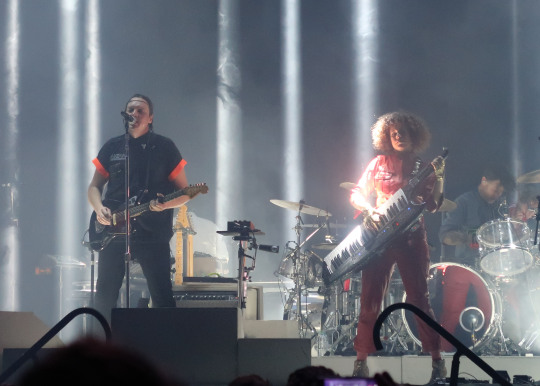
As an introduction to “No Cars Go”, Butler notes how the song was crafted during their early days in Montreal where they performed it to just a handful of people. Over the years it has grown into the immense anthem that it now is, a perfect example of how their sound has developed to fit the scale of their live show. In that time it has been there as they have become one of the best live acts around, masters, as they showed tonight, of arenas but also able to expand their sound to vast open air venues. It would be easy for them to rest on their repertoire but whilst much of what they played tonight was recorded at least a decade ago, they are still able to add new twists and turns as well as seeking to push their boundaries in their new music. It may be the case that not everything they try comes off and the mixed critical reception to “Everything Now” may encourage them to be a little more ruthless with their creativity when the results are below the standards they have set. In avoiding the clunkers and toning down the mock corporate concept that proved such a turn off during the early days of the tour, they have shown that this self analysis has already started leaving nothing to distract from what was an incredible gig. Stunning, mesmerising and uplifting, the champ pulled himself off the ropes and delivered the knockout punch.
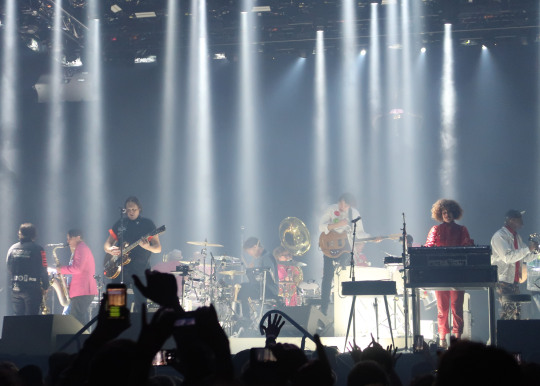
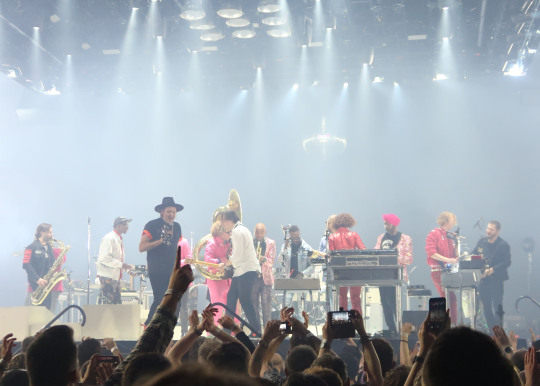
0 notes
Text
Susanne Sundfør
Glee Club, Birmingham
Wednesday 14th March 2018

The stage had been erected along one side of the main square in the northern Spanish city of A Coruna. It was still early afternoon but clouds obscured the summer sun and a light drizzle filled the air. A barrier sealed off the area around the stage but neither this, nor the weather, deterred a group of about fifty who had gathered as close as they could to secure the best place for the show that they would still have to wait several hours to see. Their patience was soon rewarded, however, as various members of the band started to saunter out onto the stage, pick up their instruments and begin their soundcheck. Every bang of a drum, strummed chord or snatch of a melody was greeted with loud cheers from this dedicated group, carried over the gap from where they were held so that the musicians smiled and waved in response. A group of backing singers sang into hand held mics but the star himself did not appear, a stand-in took his place so that his entrance later would retain its spectacle. And spectacle it was, as darkness descended, the crowd had grown to fill the square and bright lights picked out the figures as those backing singers now added their voices in tightly choreographed moves always close to the main man. Even though we couldn’t even begin to guess what his songs were about, there was no doubting his stage presence as he reached out to the furthest parts of the vast crowd. They responded to every verse, every chorus, every movement with wild cheers; sang along to every song and took selfies to remind themselves and others that they were there. Whoever this guy was, in one Spanish city at least, he was huge.
Who he was: before wandering into the square that afternoon, I wouldn’t have had a clue and despite being carried along by the enthusiasm of those around me and the show itself, seven months later I can no longer recall his name. The few parts of his biography that remain tell me that although based in Spain, he was originally from Argentina and that his long career had occasionally brought him into contact with artists I have some familiarity with. Outside of that, however, he had written songs, recorded albums and toured without making the slightest ripple outside of those who share the same first language. With a huge potential global audience of Spanish speakers, it may appear that this would be enough but periodic albums where he sings in English suggest that he has tried to broaden this appeal. That these have been met with indifference is a sign of how difficult it is to translate success from one audience to another and as an artist well into his forties, it seems as if he will have to remain content with the passionate Spanish fans who filled the square in A Coruna.

Susan Sundfør is very popular in Norway. Classically trained, she has a keen ear for a range of musical styles that she puts together to produce a sound that is very much her own. Her albums show shifts in form and style to produce wonderfully varied music with just her extraordinary voice to show that they all originated from the same source. Despite continually wrong footing her audience, she has had four number 1 albums in her homeland and has a loyal and devoted following. Like many from the northernmost parts of Europe, she writes and records in English which means that, unlike our Spanish friend, she doesn’t have to balance interesting native speakers with broadening her appeal. Her previous album, “Ten Love Songs” looked as if it would provide the breakthrough; an unexpected leap from her folksy routes, it was her disco album; electronic beats, layers of synths and joyous uplifting melodies that helped to disguise the failed relationships and emotional turmoil found in the words. It was certainly interesting and at times exhilarating but possibly a little knowing in its adoption of the bittersweet norms of Scandi pop. In writing all the songs, playing most of the music and producing the album, Sundfør piled the pressure on herself and at a time she should have been taking the music out to the audience she sought, suffered a nervous breakdown. Whilst this could be seen as a missed opportunity, she could at least draw on the depths into which she fell to make another musical leap to produce the stark and brooding “Music for People in Trouble”, most of which she will perform tonight.
As she tells us, this is her first visit to Birmingham which means that I am probably alone amongst those at the Glee Club in that I have seen her before. This was about three years ago at Latitude, one of the few UK shows she did to promote “Ten Love Songs” and dressed in bright colours and with glitter on her cheeks, she was very much the glam pop princess. In contrast, tonight sees her all in black, an oversize pinstripe jacket covers her dress and she will occasionally wrap herself up by folding her arms and pulling the lapels across her chest; a little insecurity perhaps finding its way into the confidence with which she presents herself. So assured is her English, there is just the slightest hint of an accent, it is a surprise when she slips into her first language to explain some slight adjustments she wants in the sound. She feels the songs can speak for themselves and rather than explain their origin, between them she lightens the mood by reflecting on their recent travels and asking for advice on what to do during the morning they are to spend in Birmingham. When no one in the audience can come up with anything she chides us that we should show more pride in where we live. She does, however, pick up a little Brummie and repeats the words “alroight bab” after they were suggested as an example of the local dialect. Well into her tour now, the atmosphere is relaxed and easy going drawing us in to the sparse and sometimes harrowing songs she is here to perform.

The tone is set with the opener, “Mantra”. Seated, Sundfør accompanies herself on an acoustic guitar, often picking out just single note rather than putting them together to form a chord. Alongside the fearsome power and startling range of her voice, this minimal setting works to such a haunting effect that there is a moment of silence as the last few notes reverberate around the room where the audience take a moment to fully process what they have just heard. Throughout this, the two musicians with whom she shares the stage stare at the keyboards in front of them before adding a few embellishments towards the end. The set rarely strays from this understated sound and as Sundfør seems more than capable of adding the guitar or piano accompaniments, it is tempting to wonder whether she really needed anyone on the stage with her. They do, however, allow her to occasionally add her vocals without also having to accompany herself and provide strings or solos on the flute or bass clarinet as a counter to the devastating vocals. “Mantra” slowly reveals itself, sounding almost optimistic at the start where it is possible to bask in a bright summer’s evening as she sings; “I’m as lucky as the moon: On a starry night in June”. The shift in attention from the imposing disk of the moon to the heavens beyond, however, releases the self doubt that is the main feature of her recent work; “I’m as empty as the Earth; An insignificant birth”.
Whilst gorgeous melodies and lush orchestrations of “Ten Love Songs” helped to disguise the pain in the words, and also invited comparisons with Abba, now, with a greater prominence given to her voice, there is little to sugar coat the message. This painful soul searching is reminiscent of John Grant, a comparison given greater sway as he adds his vocals to the final track on “Music for People in Trouble”. Like Grant, much of Sundfor’s self worth is determined by the actions of others towards her and when they let her down, as inevitably they will, she directs the pain inwards and towards her own frailties. “Undercover” takes a cynical view of the motives of the other; “Don’t trust the ones who love you; Cause if you love them back; They’ll always disappoint you; It’s just a matter of fact” into a fantasy where; “We could live our dreams; we'd sail on golden wings”; the piano accompaniment moving from the minor chords of the reality to the uplifting melody of the fantasy. In just three verses, the slow and haunting “Good Luck, Bad Luck” brutally dissects the superficiality of a former lover; “Freeloader wisdom from the books he never read”. Coming from her excursions into the world’s trouble spots, during her recent sabbatical she visited North Korea and the Amazon rainforest, “The Sound of War” is a stirring description of the bleak landscape left after the killing has finished. Similar in tone to PJ Harvey’s “The Hope Demolition Project”, Sundfør’s clear and ghostly voice perfectly captures the horror of the scene. Possibly the starkest expression of the place in which she finds herself is the crushing “No One Believes in Love Anymore”, performed as the first of two encores. Against the backdrop of a delightful melody, played to stunning effect on the flute, Sundfør finally confronts her inner demons which, in turn, by the end of the song allows her to find some hope as she returns to the moonlit scene of the opening song; “Looking up at the Moon, up at the Moon; We’ll all get there soon, looking up at the Moon”. The theme is developed further in the up tempo “Reincarnation” where she finds the sprit within herself to move on.

“Ten Love Songs” is not ignored completely but the two songs that she draws on, “Silencer” and the final encore “Trust Me”, are those that can be stripped back to the same stark setting. “Trust Me” in particular emerges all the better without the waves of synthesised strings in the background. Her earlier work, however, is a better fit and “Can You Feel the Thunder” and “White Foxes” need little reimagining to find a home. It is one of her earliest songs, however, in “Walls” that has been rearranged most brutally. Accompanying herself at the piano, she has stripped away the rather predictable chords changes and flourishes she originally used to create something far more interesting.
Sometimes musicians need a sudden shift to help define their career and Sundfør has already been through many. The synthesised Abba pop of “Ten Love Songs” was fun but she possibly felt that the spectacle was a distraction fro the songwriting and in taking it all back to its basics, the focus is very much on the songs. They are more than capable of holding the interest without all the embellishments and show a raw emotional heart that can be quite painful. Despite the dark nature of much of the music, the uplifting melodies and her own humour helped to make for an inspiring evening. Tweeting after the concert, one person noted that the music would not seem out of place at Symphony Hall and whilst it is possible to see what he is getting at, it would then have lost much of both its intensity and intimacy, something that helped to make the evening so special. The breakthrough to play a venue that size is probably still some way off although the nearly full Glee Club showed that, unlike our Spanish friend, she is developing a large audience outside her homeland. It will be interesting to see whether her next step will be back to easily accessible pop or something as raw and emotional as where she currently finds herself.
0 notes
Text
Rickie Lee Jones
Assembly, Leamington Spa
Tuesday 27th February 2018
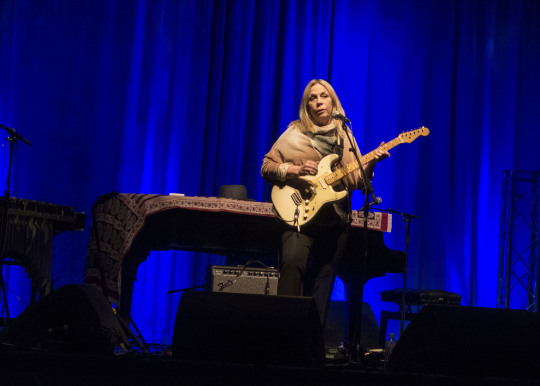
Thursday 6th September 1979. For many years this would have been the time I returned to school following the summer break but a few weeks before I had received a slip of paper through the post informing me that I had gained the grades I needed to secure my place at Nottingham University. My life was about to change but that wasn’t until the end of the month, in the meantime I had a few weeks to enjoy the break and prepare for a new beginning. The previous year Thursday afternoon had involved a long session of pure maths, struggling with differentiation and integration, matrices and transformations and the staggering complexity of a right angle triangle. Symbols, numbers, both real and imaginary, and obscure equations had taken the subject into the realms of the abstract and left me increasingly bewildered as to how it related to the world around me. Thursday afternoon maths would soon to reappear, in a lecture that began…. BEGAN!!! at 5:15, but for now I could saunter along the road that takes me to the No 9 bus terminus in Quinton without a care in the world. Whether it was football, music or the pubs and clubs of the city, the No 9 was our portal to the world, the route along the Hagley Road took us from comfortable detached suburbia to the city centre and beyond, a service it provided throughout the night. Growing up on the edge of the city certainly had its advantages.
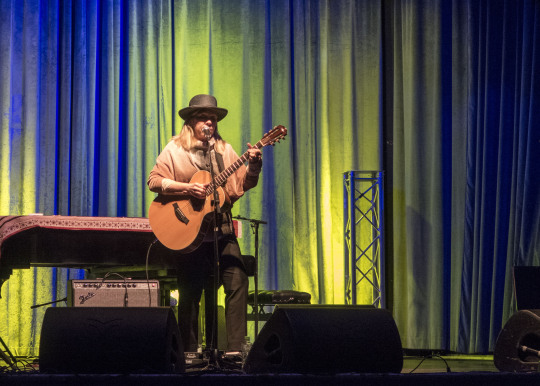
Normally, waiting for the bus I would be accompanied by others, either the most unthreatening crew of football fans imaginable or a few friends sharing a late night out, but on this occasion I was alone. This was not unusual, most of the time I went to concerts I went alone as few, if any, shared my eclectic taste in music. Despite an obsession with collecting records that had started seven or eight years previously, I was still something of a novice in live music; it wasn’t until I went to University that I started to attend gigs regularly. Whilst my friends had parents who took them to see Bowie, T Rex and Pink Floyd, that was never something mine were interested in and it was only when I was able to make my own way and fund them myself that I started to go, mostly to the Odeon in New Street where I had already seen Status Quo, Genesis, Wishbone Ash and Gary Numan. This is not a list that gave me many credibility points later, a deficit made up a little by my only visit to Barbarella’s to see Blondie, an experience that scarred me for many years to come. As an aside, I only ever went to two concerts with both of my parents, one was Cliff Richard, we were kids at the time and needed some guidance, the other was Ella Fitzgerald and in terms of kudos it is difficult to think of a greater contrast.
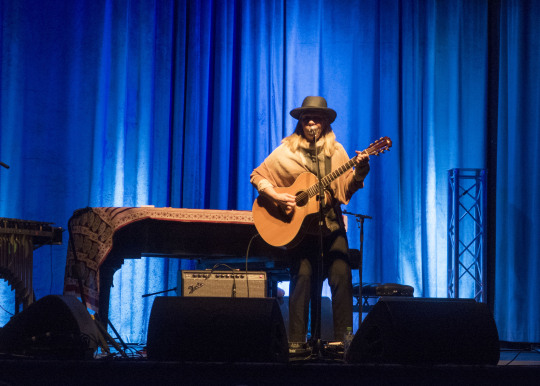
That Thursday evening I was heading once again to the Odeon, this time to see Rickie Lee Jones. Quite what it was that persuaded me to forsake the lad rock of most of my previous gigs for Jones’ smooth woozy jazz intonations I cannot say but more than likely it was mostly to do with the success of the single “Chuck E’s in Love”; a song that had forced its way into my mind and challenged me to see music as something more than hairy blokes with guitars. Despite my naivety, even I was beginning to see that neither Rick Parfitt nor Phil Collins nor, despite how hard he tried bless him, Gary Numan were really cool. Rickie Lee Jones, however, was; the red beret, that covers her head as she lights a cheroot on the cover of her first album and which she wore that evening, told us that we were in the presence of, to take the title one of her songs, the Queen of “Coolsville”, the bohemian poster girl telling stories of seedy but exciting characters unencumbered by the trials of making sense of differential calculus. It would be nice if I could complete this story by saying that it was a transformational experience, that I was so moved by a performance of such intensity that I walked out vowing never to listen to “Supper’s Ready” again. Sadly, that wasn’t the case. Firstly, as a support act, she had decided to bring with her a comedian about which the kindest thing to say was that his humour didn’t cross the Atlantic; more likely, however, was that he just wasn’t funny. Jones herself was not a happy bunny and complained relentlessly during the set that barely made it to the hour mark. She did do most of her eponymous debut album but having done that she either ran out of material or decided that she couldn’t be arsed and when the auditorium lights came on the audience stared vacantly at each other trying to find the words to express just how much they felt they had been short changed. It would be nearly forty years before we would share a room again.
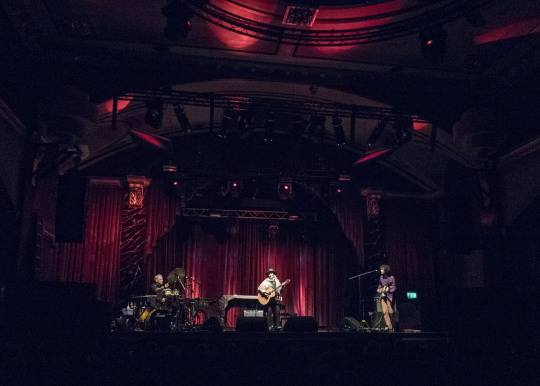
Subsequent events, however, suggest that there have been a little more to this than just artistic petulance with Jones being more than an observer of the dysfunctional lives of the Venice beach characters that inhabited her songs. She may have fused intricate storytelling with jazz rhythms and chord progressions but her lifestyle became pure rock ’n’ roll; drink, drugs and self indulgence. Despite this, her skills as a songwriter remained intact and the albums that followed, “Pirates” and “The Magazine”, stand in comparison with the delicate beauty of that debut; her set is still mainly made up of songs from this period. I still feel a little trepidation, however, in renewing our acquaintance as her reputation as an erratic live performer remains and as I arrived at The Assembly on a bitterly cold evening the doubts began to intensify. The email that arrived about a week before had told us that rather than the 7:30pm time that was advertised, the doors would now open at 7:00pm and suggested that we arrive there early. I did, about ten minutes before the time stated, and a small queue had already formed of those making sure they were able to secure the best of the unreserved seats. The anticipated short wait, however, became longer as did the queue until eventually a rather harassed man, who I presume was the manager, appeared to say yes he appreciated that we were suffering from the early stages of hypothermia but unfortunately they weren’t ready and they couldn’t let us in. He then promptly disappeared and left his colleague, a girl who looked as if she had only recently entered her twenties, to deal with the increasingly hostile people shivering outside. The “they” was obviously meant as an attempt to deflect this frustration on to the artist and the fastidious soundcheck going on inside, an easy target given the temperamental reputation that Jones carries with her. At about 7:30, however, a group of four stockily built men made their way to the front of the queue and took up their positions on the door. It appeared that whilst the punters had been informed of the earlier start, no one had thought to mention it to the security detail.
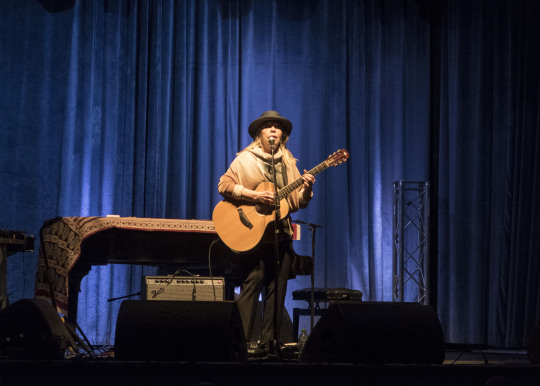
Having done most of the waiting outside, it wasn’t long before the two musicians who form the backing band were onstage laying down some intricate jazzy tones by way of an introduction. The precision of the playing was immaculate and formed a sparse but beautifully layered backdrop to the songs throughout. The wonderfully varied percussion used an array of hand held shakers, cymbals and a vibraphone to hold together the complex timing of Jones’ story-songs whilst at other times laying down a solid 4/4 beat. Around this, the guitar would add brilliantly nuanced flourishes recalling the street sounds that formed the setting for the stories being told. As they had done forty years ago, the songs from the debut album still form most of the salient moments in the set, so familiar now that the few notes that form the introduction are enough to draw hollers of approval from an audience well versed in her work. A few strummed chords are all that is needed to announce the opener “Weasel And The White Boys Cool”, extended into a long jazzy ramble showing that whilst she was happy to play the songs we wanted to hear, she would do so at her own pace. “Young Blood” had a laid back funky feel whilst the yearning in “The Last Chance Texaco” would melt even the hardest of hearts. It is unusual for a female songwriter to find a metaphor for a broken heart in a malfunctioning automobile but Jones pulls it off spectacularly, even transforming her voice into the desolate howl of a passing car at the end of the song. In introducing “Chuck E’s in Love” she explains how an old school friend called Julie had introduced her to the chords around which her most familiar song is built, as she says; “thanks Julie”. The set concludes with her tender reflection on childhood, "On Saturday Afternoons In 1963” where she is able to capture how fresh and exciting the world appears to a child before routine and familiarity dull our experience. With its haunting melody and Jones hushed singing, it is a beautifully emotional moment which she obviously feels she is unable to top as even forty years later she still doesn’t do encores.
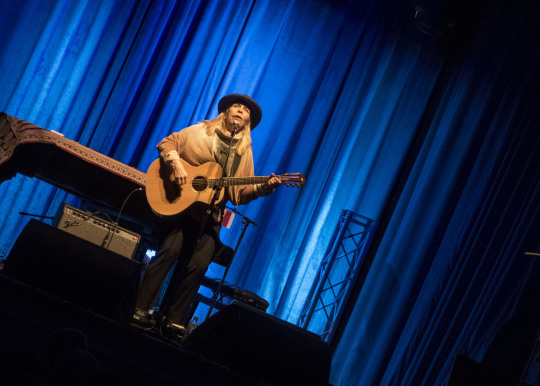
Her inner child is evident in her strange girl/woman voice that makes astonishing jumps between registers, surely an influence on both Martha Wainwright and Cerys Matthews, but often this is set in a stark contrast to the deep pain and hard knocks found in many of her songs. She moves from acoustic to electric guitar, explaining her satisfaction at using the latter for rhythm rather than as a lead or for effect, before quietly moving to the piano towards the end. “Living It Up” is another wander amongst the bums and losers of Venice Beach, Eddie , Cunt-finger Louie, and a girl named Zero all drawn to a strange place where everyone seems to be “Living it Up”. “Pirates (So Long, Lonely Avenue)” is her breaking away from the familiar faces and routines; “Well, goodbye boys; Oh my buddy boys; Oh my sad-eyed Sinatras”; a recognition that the things are moving on and that staying around would diminish her. Written in the aftermath of her break up with Tom Waits it is clear eyed in its understanding that it is not just the relationship that is over but also that way of life. Both songs are taken her second album “Pirates” from which she also draws “We Belong Together”, like the others populated by flawed and dangerous characters who in some macabre ritual will always be drawn to one another. The depth in the storytelling so early in her career is astonishing and whilst she remains a songwriter of incredible insight, her more recent music doesn’t quite capture the same raw intensity. “Circle in the Sand” and “Haunted” were both immaculately arranged and played but still weren’t quite as moving.
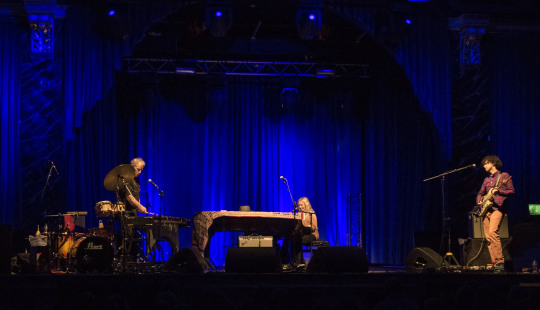
The evocative melodies and delicate musical settings has always added a poignancy to even the darkest of Jones’ songs but with the passage of time, their emotional impact has been greatly enhanced. At the time, the characters and scenes she depicted were those that she saw around her but now they are like postcards from a past that has long ceased to exist; the Eddie’s, Johnny’s, Zero’s and even cunt-finger Louie having long since succumbed to the dysfunction of their lifestyle; the one that Jones herself was able to escape. As I listen to songs that have been with me for the best part of my adult life, I reflect on how my own world has changed since I sat in the stalls at the Birmingham Odeon, those friends at the time, most of whom I no longer see, and those in my life now who I hadn’t met, or who may not have even been born, then. In particular, I think of those eccentric characters who could, and possible should, have formed the subject of my own stories to preserve their life in the way that those who strolled around the streets of south LA have been preserved. Then it was probably not the will be the talent that prevented me from doing this. Jones remains a somewhat tetchy live performer who lacks the easy rapport to seem quite fully at ease in front of an audience but her writing and the intensity of her performance bring to life the songs that retain their power even when their subjects are no longer around. A performance like this all those years ago really would have singled the end for “Supper’s Ready” - “Then again years may go by: Years may go by.”
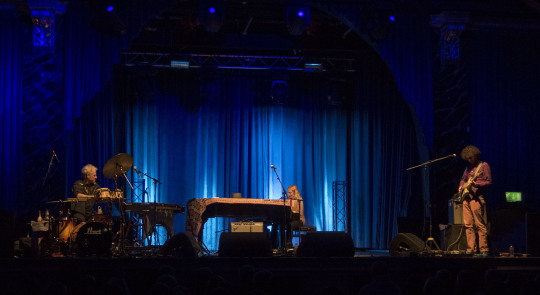
0 notes
Text
Kendrick Lamar
Genting Arena, Birmingham Friday 9th February 2018

“Something is happening but you don’t know what it is.....” Last spring I was sitting in the Motorpoint Arena in Nottingham taking advantage of what I suspected would be my last opportunity to see Bob Dylan. The “sand and glue” voice was not the natural instrument with which to approach the great American songbook but in recent years this is where the former folk rock rebel has found his home. It shouldn’t work but Dylan’s interpretations of these songs were strangely moving and in making no attempt to disguise the ravages that age has had on that voice, he was able to convey a depth in the sadness of “Autumn Leaves” that few others have found. The fire that once fuelled his music has not, however, been completely extinguished and as he tackled his own songs, he was able to reconnect with the anger that had inspired the writing of them. Whether it was bitter recriminations that followed his divorce from Sara Lowndes in “Tangled Up and Blue”, the bleak rumination on death in “Beyond Here Lies Nothing” or the stark emptiness of his twilight years in “Lovesick”, he approached these songs with a bitter intensity that for many years his live performances have lacked. He was, however, at his most venomous in the encore, following the protest anthem “Blowin’ in the Wind” with “Ballad of a Thin Man”, his savage assault on those who his own popularity had drawn to the movement but who wore it as fashion, to be lightly discarded when something more interesting, and possibly easier and shallower, came along. You see and hear the words and you can sing along but they leave no trace, no memory, no anger at the searing injustices that they portray. Then, with even the cheapest tickets costing over £50, those who are able to shell out to see a performer who makes no pretence that he will guarantee a good show, will have made their own compromises, the ideals of youth cast aside in pursuit of a career, to have a roof over their head, to provide for family. We are all Mr Jones, perhaps we never knew, perhaps we once did but in the struggle to simply survive we have forgotten but however we arrived there, the words hit home, “you don’t know what it is”.
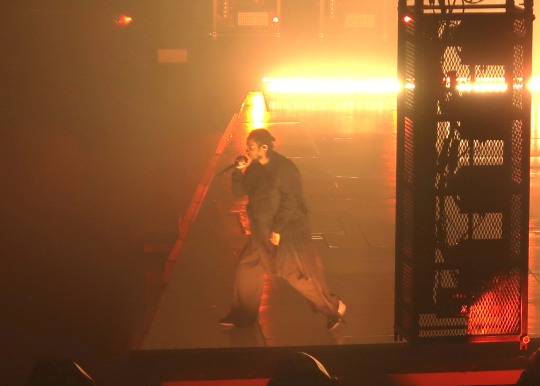
Like Dylan, Kendrick Lamar’s music reflects the turbulence of the era in which it has been created to the extent that he has come to be seen as the spokesperson for his generation. Barack Obama named his song, "How Much a Dollar Cost” as his favourite of 2015 whilst another, “Alright” has become the anthem of the Black Lives Matter movement, this despite his own controversial statements following the killing of Michael Brown. Also like Dylan he assumes characters too tell his stories, now seen in the form of short films featuring Kung Fu Kenny that serve as a motif running through the show. Martial arts are also apparent in his lose fitting black costume and the choreographed sword moves from the female dancer, the only other person with whom he occasionally shares the stage. It could be clumsy, indulgent, ridiculous even, but so assured is Lamar’s touch at the moment that it works spectacularly, subtle, not taking itself too seriously and displaying an often overlooked sense of humour. Instead of pristine digital recordings, these films have the slightly blurred look of VHS and the vibrant colour intensity of 70s kung fu films. Rather than some, admittedly rather tenuous comparisons, however, it is Dylan’s words that hit home almost from the moment I step of the train at Birmingham International. Despite having recently entered his 30s himself, Lamar’s audience is young, scarily young in many cases. Walking to the arena and in the queue to get in I scan those around me, desperately searching for others of a similar vintage with grey hair, aching joints and weak bladders. My spirits lift a little when I see another craggy face staring back at me until I realise that he is there to give me a quick search. Just as I had resigned myself to being the oldest person amongst the 15,000 or so there, I see another kindred soul in the queue to buy a t-shirt. Admittedly he was there with his kids but I am so relieved I feel like running over and giving him a big hug.
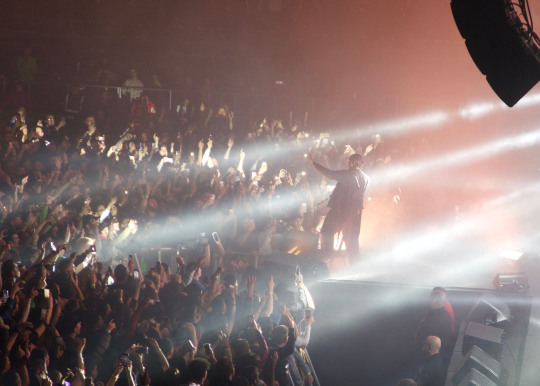
“I know there are those here who have been with me from the start”. Undoubtedly there are but certainly not everyone who cheered, many of whom would still have been grappling with the literacy hour at primary school when Lamar last arrived in Birmingham in 2013. Regardless of how long they have been on board, however, they are well schooled in all things K-Dot, word perfect in even the SchoolBoy Q collaboration “Collared Greens” and the awkward rapid burst of “untitled 07”. The obscurities mastered, the test posed by career highlights such as the exuberant “King Kunta”, with its George Clinton chants of “we’ve got the funk”’ and “Swimming Pools (Drank)”, the responses “Pour up (Drank); Head Shot (Drank)……” perfectly timed, were passed comfortably, The music has been fully absorbed, repeatedly listened to until not just the words, but the phrasing, the pauses, every nuance has been internalised, reproduced perfectly despite its lyrical and musical complexity. In our youth we do that but as we get older and with so many other things competing for our attention, we rarely get to know the music as intimately, lacking the time to search out its mysteries. Whilst I could throw in the odd line, it somehow didn’t feel right as those around me were so immersed that they were able to cover the whole song. The words, “Nobody Pray For Me; It’s Been That Day For Me”, give the introduction to “HUMBLE” after which Lamar can just stand back as the audience rap not just the chorus but both verses. I help out where I can but my own stuttering attempt to join in is shamed by the perfection around me; Mr Jones, something is happening but I don’t know what it is.
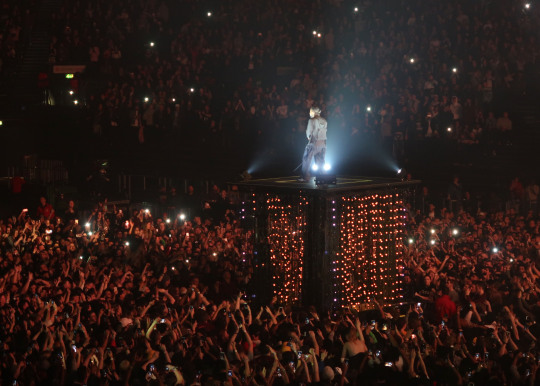
The short films and accompanying pyrotechnics serve to show that the social and political weight of the music makes its point more strongly if we are having a good time. We are - from the moment he rises through the trap door in the middle of the stage to spit out the incendiary opener, “DNA”, the sheer unrelenting quality of the music, the imaginative staging and the force of personality of the star make it an unforgettable performance. With the band placed in a small orchestra pit, Lamar prowls the stage with blocks of lights and back projections used to set each song. This gives a lose spontaneous feel despite the planning and rehearsal that would have gone in to get it right. For “LUST”, the dancer returns, an attempt to distract us as Lamar himself makes his way to a second stage in the middle of the audience, behind those paying the extra to secure a place in the golden circle. A sparkling cage contains him for a moment before he ascends to deliver a triumphant “Money Trees” from above. Back on the main stage, for “XXX” a bright white screen closes above him, perfectly capturing the intense claustrophobia of the song. Lying on his side, he levitates above the stage for “PRIDE”, a moment of self reflection where he questions whether he is up to and whether he wants the burden others have placed on him. The muted “Bitch Don’t Kill My Vibe” continues the uncertainty, an attempt to find the source of his creativity that he knows he will be unsuccessful but strengthening his resolve to protect it. Even the most subdued parts of the set are warmly and loudly received, certainly from the audience response it was one of the loudest concerts I can remember, but they also help to build up the anticipation for the stunning climax of the set, the celebration of “Alright” and communal rap of “HUMBLE”. Then, having been given the “Seven Nation Army” treatment a la Jeremy Corbyn, he returns to take it down again with a hauntingly restrained “GOD”.
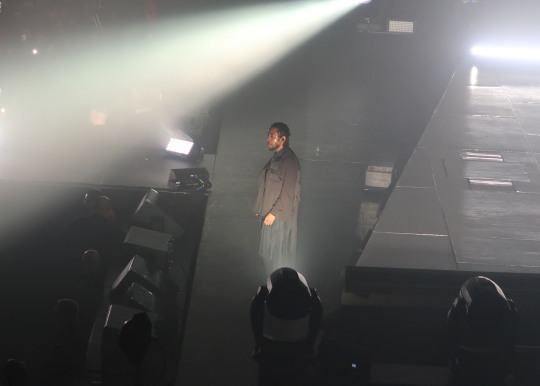
We like categories; compartments into which we can put things to help us make sense of the world, creating genres in music to guide us when we encounter something new. Like Bowie and Prince, however, Lamar is someone whose work is not easy to put into a box. Reviews, shops and on line sources such as Spotify would place him in the rap or hip-hop section but whilst he is undoubtedly a rapper of outstanding technique and agility, neither term fully does justice to the sound he creates. He avoids many of the trappings of other rappers, thankfully the twenty minute demonstration of the DJ’s turntable skills, surely the equivalent of a drum solo, is absent and whilst he is not averse to profanities, they are used to carry the rhythm and as a point of emphasis. In particular, his lyrics make their point clearly, recalling the early days of rap when the acts such as Grandmaster Flash and Public Enemy tackled issues such and poverty, oppression and the pimps and drug dealers who could hold such a poisonous influence over communities. The turbo charged masculinity that came to the music and that had such tragic consequences for some of its performers is absent, instead we get something that is more fragile, more open to self doubt and insecurity, something more in tune with the feelings of the young audience. What Lamar manages to pull off is to address these themes whilst being an incredibly confident and gifted performer. As we share our experiences, it is often tempting to fondly reminisce about the acts we caught in their infancy, where we could share an intimate moment with them and just a few others. Those who had seen his last show at the O2 Academy will no doubt have mixed feelings about now having to share the music with so many others but it can be the break through to arena and stadium gigs that can really define the artist, have they got what it takes to hold an audience of thousands rather than hundreds. With that in mind, therefore, it is a test that K Dot passed spectacularly. It will never be intimate again but the show more than makes up for that. In years to come, this could well become one of those “I was there” moments, even for an old git like me. Something was happening, and maybe even I am beginning to understand what it was.
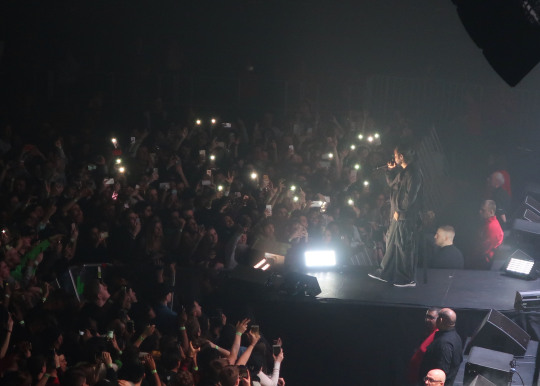
0 notes
Text
The Weather Station
The Hare and Hounds, Kings Heath Wednesday 31st January 2018

When is it that we start to see and hear everything in terms of the past. As a youngster, music, films, art can be taken at face value, it is something you either like or you don’t. Thus the energy and spectacle of T Rex was enjoyed without being aware of the fairly basic chord progressions that many would be able to pick up within a few months of first strumming a guitar. The glitter and flamboyance gave Bolan his star quality but musically he did little that had not been done before. It didn’t matter and even now hearing “Get It On” or “Jeepster” brings back the excitement of the time, place and innocence of when this magnificent pop first entered my world. This past, however, exerts itself over music we come to later, setting an impossibly high bar against which we judge what we hear. As we listen to new bands, singers, records and so on we hear their references, the influences that have shaped their music against which, to our ears at least, they seem little more than pale imitators. For a teenager growing up in the 90s, first hearing “Live Forever” must have given the same thrill as “Metal Guru” had done for me twenty years earlier. With years of music to draw on, however, it exists within a context shaped by its influences, dulling the thrill and preventing us being carried along by its compelling simplicity.

Whilst an awareness of how an artist uses their influences to shape their music can enhance our enjoyment of it, too often it makes us lazy; seeking simple comparisons that fail to see how they have been absorbed and developed and how the rules have been applied or broken to achieve the sound. Admittedly, sometimes the artist themselves joins the dots a little too obviously so that the comparisons become inevitable. Two years ago, Ryley Walker toured with Danny Thompson as if to draw attention to the jazz chords and rhythms of 70s British folk, in particular John Martyn, that he had used for his album “Primrose Green”. His music, however, showed that this only represented part of the story and he has combined a breadth of these influences to produce a sound that is entirely his own. Likewise, in introducing the song “I Mined”, Tamara Lindeman notes the importance in her music of another Canadian singer/songwriter, Neil Young. Lindeman’s song was written in response to hearing Young’s “Heart of Gold”, contrasting his assertion that at its deepest level the quest would lead to something spiritual and precious with her own experience of finding only deeper levels of darkness, “And all I’d see hidden underneath only served to make me lonely”. Its insightful but world weary lyrics are typical; her youthful features and the long blonde hair that falls down her back make her seem a lot younger than her 32 years but her words are those of someone who understands the difficulty of building and sustaining relationships with others and the complexity of her own emotions. Young’s influence can be seen in a set that meanders through delicate acoustic moments where the audience were spellbound into silence to loud screeching rock. Listening to the confidence of her playing and a voice that within the same line can progress from a deep and resonant contralto to a light wispy falsetto, the name of another Canadian pushed its way into my lazy mind; Joni Mitchell.

Since the early 70s almost every woman who has picked up a guitar and strummed a few chords has had to stand comparisons with Mitchell, not the first woman to make it in an overwhelmingly male world but certainly one off the first to do so on their own terms. For Lindeman, however, the comparison can withstand a little scrutiny. Her confessional lyrics show a self awareness and deprecation that can be painful, she is an acute observer of others and can identify their motives and failings with precision and her songs are structured to convey the poetry in her words. Unusual tunings create unexpected chords and song structures take surprising diversions with changes in rhythm and key used to unsettling effect. The sparse “Personal Eclipse” or the intricacy of “Free” do recall Mitchell’s 70s classics but Lindeman’s creativity is strong enough to take her beyond any lazy attempt to describe her as the next Joni. “You and I (On the Other Side of the World)” and “Kept It All to Myself`” both move along at a sprightly tempo, disguising the doubt and loss in the words with a sublime melody and a lively beat.

Lindeman returns to the hushed acoustic folk of her earlier work for a short interlude at about the mid point of the set while, with no where for them to hide, the band site awkwardly at the side of the stage. Returning, the grungy guitar quickly starts to raise the decibels showing just how much Lindeman has expanded and developed her sound from the sparse delicacy of those beginnings. The strings that provided such wonderfully rich textures on the most recent album could never be recreated in the confines of the Hare and Hounds but the power of “Impossible”, “Black Flies” and in particular “Thirty” mean that they are not missed. The jaunty rhythm of the latter brings the set its fiery conclusion with guitar stand off between Lindeman and Will Kidman. With little room at the side of the stage, the band make their way awkwardly through the audience before the singer calls them back, taking the energy levels down a little for the haunting encore of “Tapes”. The response was every bit as enthusiastic as the wonderfully varied set deserved.

With four albums behind her Tamara (pronounced as she tells us at the start to rhyme with camera) Lindeman is well into her career but it is in developing her music from the acoustic setting she used on her earlier albums that she has begun to find a larger audience. Admittedly The Hare and Hounds is not a large venue, there may have been a large proportion of elderly Uncut readers there and at £8 a ticket it is difficult to see how they make the tour pay but, as she says, this is her first visit to Birmingham and the enthusiasm of the audience should start to see the interest in her growing. A former child actor, she once appeared alongside Jennifer Lopez, Richard Gere and Susan Sarandon in the film “Shall We Dance”, she shows an innate grasp of how to present her music and she held the audience throughout the show. That, along with the craft and creativity in her songwriting, suggests that despite the quality of the music heard tonight she may only just be starting to tap into her full potential. It is likely that her next visit to Birmingham will be to somewhere larger making the intimacy of the show tonight one to remember. A presence in my mind in her own right no longer framed by those Canadian singer/songwriters who went before.

0 notes
Text
Fleet Foxes
Civic Hall, Wolverhampton
Friday 24th November 2017
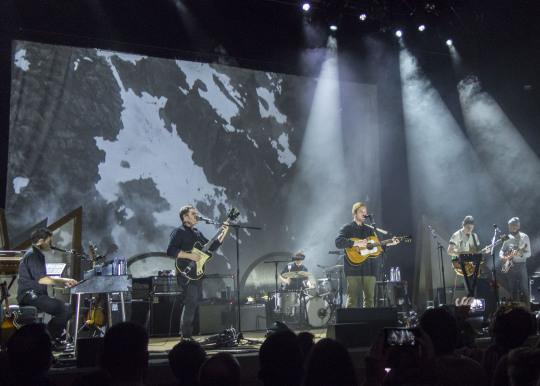
Robin Pecknold picks up the thermos that has been left underneath the table to his side. He unscrews the lid and pours some of the contents into a mug before carefully putting it back. It is a routine he repeats at least three more times and at the end of the set and with his guitar being left to the roadies to deal with, he carefully carries the thermos off with him. This is rock ‘n’ roll, the furtive behaviour should be a clue to the intoxicating and illicit substance that are the contents of the flask but Pecknold isn’t your typical rock star. Nearly a decade ago his debut album cut through all the noise with perfectly crafted songs showing a real emotional depth. Another album quickly followed, suffering a little from second album syndrome but still doing enough to show that despite still only being in his early 20s, he was an extraordinarily gifted artist with a bright future in front of him. Then nothing, as the world opened up in front of him with all the trappings and temptations that would offer, he did the most un-rock ‘n’ roll thing he could and went to university. As well as gaining his degree, this gave him plenty of time to plan his next move and tonight shows that he has not been idle. And that flask, most likely nothing stronger than a herbal tea to coax his voice through the songs that push him to the limits of his range.
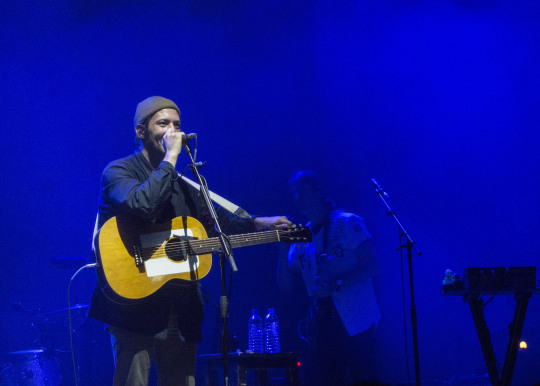
There are few songs that have such an impact that you can remember exactly the first time you heard them. For many years I have read Uncut magazine but mostly the accompanying CD has been played just once, the songs failing to register amongst all those others that compete for your attention everyday. Occasionally, however, one demands that you reach over and press the repeat button to check, was it really that remarkable. “White Winter Hymnal” was one such song, a beautifully sparse arrangement, exquisite harmonies, wistful lyrics that, even on that first listen, sounded as if it was a song you had known for years, something that should be as old as music itself. Surely, a song of such compelling melancholy must have been created by someone with a life time of experience to draw on, a snowscape half remembered from a childhood that was now receding into the distant past. The cover of the eponymous debut album from which it was taken displayed a busy medieval scene, emphasising that these romantic ballads were passed on through generations before being picked and recorded by a group of wizened old sages. There were no pictures of the band to challenge this impression but the voices singing those harmonies sounded pure and clear, the timbre showing little indication of the ravages of time. With the album having been played relentlessly and already forming a permanent musical imprint in my mind, I decided that I needed to hear it live and on a warm July evening I stood in almost the same place as I am tonight to see the Fleet Foxes for the first time. Even though most of the band wore heavy beards, there was no disguising the fresh faces beneath, young musicians barely in their 20s creating timeless music and appealing to an audience who mostly seemed old enough to be their parents. The music was, of course, exquisite but its complexity required that instruments were retuned in between every song making for a some what disjointed evening. A few days later I saw them again, this time supporting Neil Young in Hyde Park where their perfectionism made it difficult for them to hold the large festival audience, something that was made more prominent as they followed the brash showmanship of Seasick Steve.
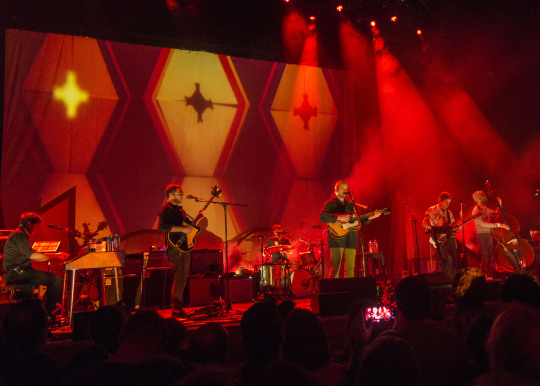
Robin Pecknold is someone who doesn’t appear to do anything by halves so it is likely that his diversion into academia was motivated by a passion for literature and a wish to complete his education. His time away, however, has also allowed him to reflect on his stage craft and he now seems a more confident and assured presence than he was during the last tour. In particular, stage hands are ready to change over guitars whenever retuning is needed, which inevitably he takes to moments within songs as well as in between them. He can’t resist the temptation to fiddle, however, and as the set nears its end, he finds the tension in the strings doesn’t meet his exacting standards leading to a pause as he makes the adjustments. Overall, however, the set is sharp and focused, something that it needed as in his time away, his musical vision has become grander. So many ideas are developed, so many alternative pathways explored that the self imposed dam could no longer contain the creativity and the release has been spectacular. A whole album worth of themes and moods are condensed into a single song, the titles such as the opener, “I Am All That I Need/Arroyo Seco/Thumbprint Scar” revealing the breadth in the vision behind it. Another guitar is brought on, a ripple of applause tries to force its way into a brief moment of silence but before it has a chance to build the next song has started. “Cassius”, “Naiads, Cassadies”, one medley subsumed into another medley to form an epic whole. The scale threatens to be overwhelming but so carefully is it constructed, so well do the parts merge that it the effect is thrilling.
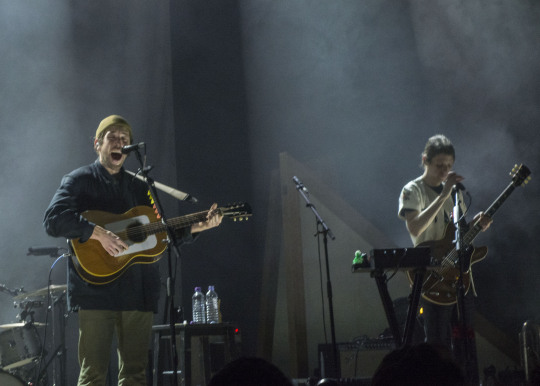
The meticulous construction of the sound could be seen as a reflection of Pecknold’s stint in academia, an application of theory that could be a PhD thesis rather than music to lose yourself in. Delving into the lyrics offers little respite, he is keen to show of the fruits of his studies and the title track of his latest opus, “Crack Up”, covers references to F Scott Fitzgerald, the American Civil War, ancient Egypt and a host of others I am insufficiently educated to pick up. For another song suite, “Third of May/Odaigahara”, Pecknold took to genius.com to explain what he was on about, it is tempting to suggest that the time would have been better spent making his thoughts a little clearer in the first place. Then, while some songs revel in their immediacy, others are slow burners that only reveal their mysteries slowly and after several listens. “Crack Up” certainly does just that and hearing it live helps to reveal a little more of the scope of Pecknold’s creativity. That said, however, the light melody and steady rhythm of “Fools Errand” felt like a clearing had been reached in the dense forest of much of the new album. Where he gets it right, however, the orchestrations add an intensity to create a mood that is simply breathtaking, particularly on the title track, where the different and competing musical ideas are forged to make a sound that is stunning.
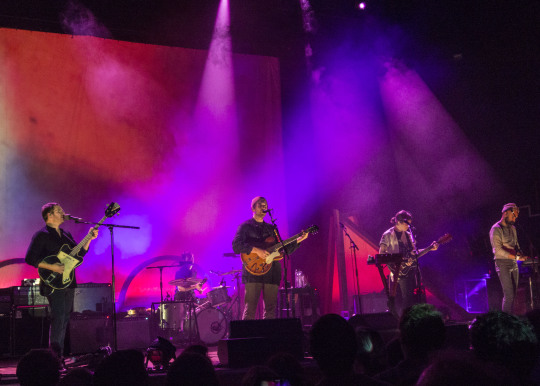
For all its qualities, however, the early appearance of “White Winter Hymnal” draws attention to what “Crack Up” lacks, that attention grabbing moment of pop clarity. The lush melody, sung in a round, and perfect harmonies create a dreamy feeling that is enhanced by the abstract winter scenes projected behind the band. It had made its point in July but a bitterly cold November night enhanced its wonder. The first album is filled with such moments, the haunting minor key of ”Your Protector”, the tuneful “He Doesn’t Know Why” and the delicate acoustic “Blue Ridge Mountains” all add familiar tones and moods. There are fewer such moments on the second album but “Battery Kinzie” disguises it’s bleak message with another enchanting melody and “The Shrine/An Argument” builds from the delicacy of its opening to a startling dramatic conclusion and a brilliantly atonal sax solo. The early “Mykonos” is as charming as ever, showing how much of Pecknold’s vision was there from the start. For both “Tiger Mountain Peasant Song” and the encore “Oliver James”, Pecknold is alone with just his guitar as accompaniment, adding an intimacy, that the complexity and scale of his recent music lacks, and pushing his voice to its limits. The lush arrangements may have been fascinating but here Pecknold shows that his songs can express their mood with the simplest of accompaniments.
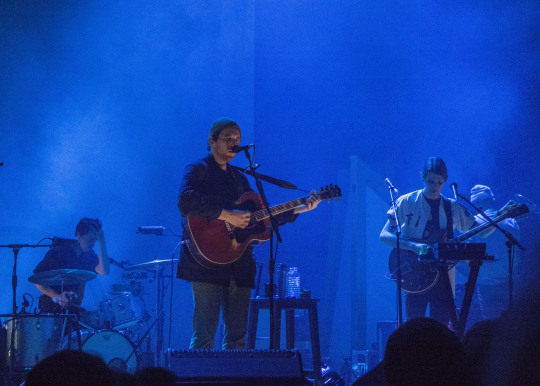
A break of over half a decade so early in a career is not usually something that leads to longevity but then again, many of the rules by which the business works, don’t seem to apply to Robin Pecknold. Certainly, the nearly full hall indicates that he has not been forgotten and the mastery of his intricate and complex folk music helped to raise the anticipation for his return. He acknowledges his previous show at the Civic but I didn’t come across anyone else who had been there so most, I suspect, have been waiting for this opportunity since discovering the brilliance of that debut album. The set carefully places the well known songs in between the brooding intensity of his new ones meaning that when it does get a little heavy going, there is always something familiar, and mostly lighter, to follow. He does seem intent on taking the band into new terrain, somewhere were meaning is hidden by obscure references and labyrinthine orchestrations, something less fleet. It will be interesting to see where he goes next.
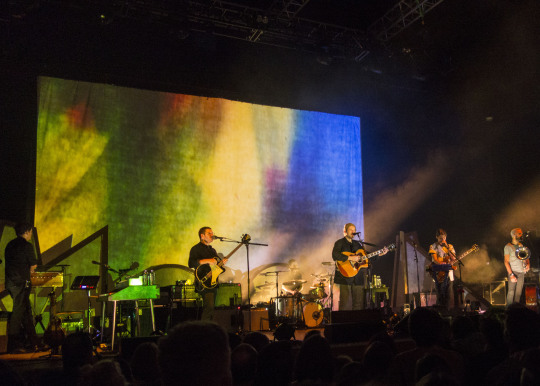
0 notes
Text
Robert Plant & The Sensational Space Shifters
Civic Hall, Wolverhampton
Monday 20th November 2017
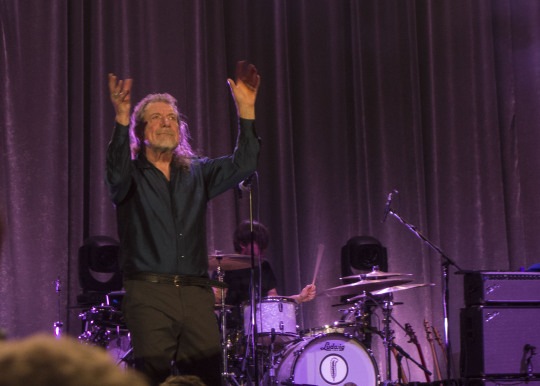
It is a dull and drizzly Monday evening and in Cardiff Deep Purple are about to take to the stage at the 7,500 capacity Motorpoint Arena as part of what we are told will be their farewell tour. With Jon Lord sadly passing away in 2012 and Richie Blackmore seemingly content to spend the rest of his days playing madrigals, this current incarnation of the band is as close as it is possible to get to the classic early 70s line-up and they even managed to get themselves into a studio to record a some new songs. Few, however, even amongst their most die-hard fans will want to hear them, instead they go for “Smoke on the Water”, “Speed King”, “Black Night”, the heavy rock based prog that became their signature. Despite forming earlier, sounding different and working their way through multiple line-ups, Deep Purple never seemed to escape from the shadow of the behemoth that was Led Zeppelin. Both had songs that helped to define their genre and era but Led Zeppelin’s were more memorable, both had the riffs but Page’s were the ones that were more instantly recognisable, both had charismatic singers but Plant’s bare chested image was always the more striking, both were bigger in America than in their homeland but Led Zeppelin were immense. Even now as the Purps take their last celebratory victory procession, the response is; yes, filling these arenas is impressive but just think what Zep would do.

That they don’t is down to Robert Plant. The journey that he has taken since the demise of Led Zeppelin is one of the most curious but ultimately most inspiring of any of the 70s rock legends and even as he approaches his 70th birthday there is little to indicate that his exploration is anywhere nearing its end. What that makes this all the more remarkable is that even during the final days of Zeppelin, Plant seemed to have lost his instincts, his feel for the music, his judgement, even his dress sense. I missed out on the opportunity to see Zeppelin during their reign, I was far to young to catch them in their early days and by the time my concert going had started, they were mostly absent as they preferred instead the huge money spinning American tours to those at home. I could have seen them at Knebworth but chose a family holiday instead, a decision I have long since regretted but Plant has always maintained that those concerts should have been cancelled due to how poorly prepared they were. Maybe then the thought of how good it could have been is better than the memories of how it actually was. With Page a junkie and Bonham drinking himself to his early death, the onus was on Plant to put together their final album, “In Through the Out Door”, which, smothered in synths as it was, gave an indiction of the direction in which he would be heading as a solo artist. This was the era of massive albums, the final throw before music became digitalised, and with the technology available to produce a bright clean pop sound many 70s veterans found a way to make the biggest selling album of their career. Bowie had “Let’s Dance”, Springsteen “Born in the USA”, Phil Collins “No Jacket Required” but despite respectable sales, particularly for the single “Big Log”, Plant never threatened to eclipse his former band.

Ironically, it may have been a brief reunion with Page that finally convinced Plant how misguided this had been. Together they had taken early Zeppelin away from being the purely heavy rock act that most of their pale imitators were by introducing at first the acoustic feel of English folk music and later African rhythms, Indian instrumentation and melodies and a host of other sounds that would later be referred to as World Music. This reunion led to “No Quarter”, an album that included a number of rearranged Zeppelin songs which would have convinced him of two things; firstly how shallow and undemanding much of his recent music had been and secondly that he could rework Zeppelin songs in a way that would still hold his interest. Thus began his restless musical exploration, taking in the North African sounds that he had explored with Page as well as journeys into the remotest backwaters of American folk. The sounds he created were often quieter, more delicate and intricate than the bombast of Zeppelin and required him to find new voices to tell their stories; the bravado and swagger would soon be a thing of the past, replaced by something more subtle and nuanced. He collaborated with people who would challenge him, Alison Krauss, Patty Griffin, producers T Bone Burnett and Buddy Miller and a host of crack American session players, even briefly relocating to Austin in the process. His musical quest, however, is built on a strong sense of place and returning home allowed him to reconnect with the band he first worked before his American sojourn. The Sensational Space Shifters have developed into a formidable outfit, allowing him to realise the songs that have come from such a disparate range of sources. While over 7000 filed into an arena in Cardiff, less than half that number made their way through the oppressive security at the Civic Hall and most, I am sure, wouldn’t have been too put out had he not included a single Zeppelin song; we understand what he is doing and we are here just as much for the new songs as the old ones.

There were, of course, some Zeppelin songs but these were mostly played without the deconstruction and reshaping that he has applied on previous tours. A gentle acoustic strumming accompanied “That’s The Way”, still magical, and “Gallows Pole” as on the album although the latter did gain a harder edge towards the end. “Whole Lotta Love”, as so often his final song, had its usual swagger which tonight was enhanced by the violin of Seth Lakeman who, as well as his support slot, had added some wonderful textures throughout the set. The first encore “What Is and What Should Never Be” built from its quiet and delicate verses to release the power of its chorus. The exception was “Misty Mountain Hop”, so different from the recorded version it it was only the words that gave it away. Plant added some context about how is was an attempt to recapture the collective spirit as the ideals of the Woodstock generation were fading but its reworking lacked the insight he has previously shown when he turns to his back catalogue. The best of the Zeppelin songs, however, was the wonderfully lyrical interpretation of “Babe I’m Going to Leave You” illuminated by Skin Tyson’s expressive acoustic guitar and Plant for once releasing the full power of his voice.

The last time I saw Plant was just after the release of his previous album, “Lullaby …. and the Ceaseless Roar”, a highly personal album made shortly after he returned from his exile in Texas. His sense of displacement is captured in the song, “Turn It Up”; “I'm lost inside America; I’m turning inside out; I’m turning into someone else” neatly expressing his disconnection from his surroundings. Appearing early, its stuttering rhythm gives a sense of someone struggling outside of their familiar surroundings. From this album he also includes “Rainbow”, a wonderful hymn to the rugged highlands of North Wales that inspired his excursion into traditional folk in his Zeppelin days, and his reworking of “Little Maggie”, illuminated as ever by Justin Adams’ exquisite finger picking. Where previously the disorientating drone of Juldeh Camara’s ritti had helped to create the mood of the songs, that is now done by Lakeman’s violin. In tone, his most recent album, “Carry Fire” shares many similarities with its predecessor suggesting his return home has also seen some tempering of his musical wanderlust. Whilst there may be a consistency in the sound, however, “Carry Fire” feels a lot less personal, being more settled has allowed him to observe the world around him and you get the feeling that he is not too impressed with what he sees. Opener “New World” sounds like a rebuke of the “Immigrant Song”, rather than heroic warriors, the destructive will of the settlers overwhelms the land, “The great white father’s word is law”. The theme of immigration also informs the title track, its wonderfully inventive arrangement and thoughtful lyrics providing a compelling highlight. Here he takes the perspective of the pressures that cause people to leave their homeland in search of a better, or more likely, safer life and their lack of comprehension of the hostility shown to them. It is rare for Plant to be this overtly political but the sincerity and emotion conveyed makes it incredibly moving. Similarly with “Bones of Saints”, performed as the middle of three encores, which covers how arms from Britain and other western nations are used in the atrocities carried out around the world, in particular at this moment in Yemen. It is a theme that Plant doesn’t shirk from in his introduction, overcoming his tendency to ramble to make his point clearly and directly. “The May Queen” is the lightest of the songs from “Carry Fire”, a repetitive, hypnotic trance whose folk origins are enhanced by Lakeman’s fiery violin. He also includes “All the Kings Horses” from “The Mighty Rearranger”, the first album to feature the musicians who were to become the Sensational Space Shifters, and a beautifully tender “Please Read the Letter” from his collaboration with Alison Krauss.
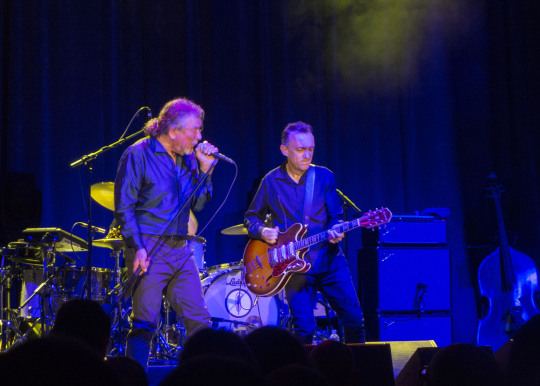
A dull, drizzly evening and in Wolverhampton the the audience are filing out through the limited number of exits that seem to be open. Filled to its capacity, the hall had been crowded leading to some tetchiness as people struggled to gain a view. The heat from all these bodies made it obsessively hot which, despite its recent refurbishment, the Civic’s air conditioning failed to moderate. Added to that a near septuagenarian rock star had decided that we really wanted to hear his new stuff. There were so many reasons, then, why it should have gone wrong but it didn’t and what we saw was a truly inspiring performance from an artist who is still at the very top of his game. One striking thing was just how quiet and receptive the audience were, the response to each song was as enthusiastic as Plant’s reputation requires but during the songs people were there to listen, quite something in a venue that is usually notable for the volume of its background chatter. The post gig euphoria is not the best time to make comparisons with previous shows but having had chance to reflect since, I have found few reasons to doubt my initial reaction as to this being one of the best shows I have seen him do. The template for how rock stars gracefully age is still in the process of being written but there are few who manage to do it whilst still remaining important and relevant. Plant’s travels, both physical and musical, may now be a little more limited in their scope but his music remains both intriguing and important.

3 notes
·
View notes
Text
Rhiannon Giddens
Town Hall, Birmingham
Sunday 19th November 2017
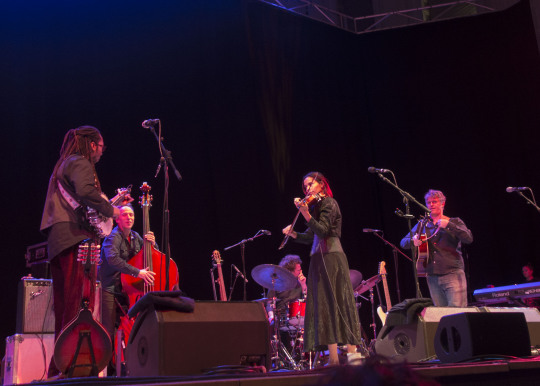
Kaia Kater peers nervously out at the audience. Two songs into her short support set and she pulls the banjo that provides her only accompaniment close to her, she feels she needs a barrier between her and the nearly full hall of people who have arrived early to hear her. It has been going well so far, a period of study in the Carolinas has helped this Canadian to become well versed in the American roots music and the precision of her playing is enhanced by the depth and quality of her voice, reminiscent in tone to Gillan Welch. The audience quickly warm to her and the songs have generated an enthusiastic response but she now feels that she has to face that awkward challenge over which so many artists from North America stumble; she has to mention the place she is visiting. She has obviously been warned and each syllable is formed slowly, carefully, deliberately; “Birm……ing….” then the final one, make or break time, they will either accept you as one of their own or the rest of the set will be spent winning them back - “ham”, with the emphasis on the “a” - damn - rehearsed to the point of tedium but it still wouldn’t come out right. She gazes at the faces in front of her; “was that right?”, silence, she didn’t have to ask, she knew it wasn’t. She makes another attempt, slower, the sounds being formed even more deliberately but this only served to make that final vowel even more prominent. With the confidence that she had shown so far starting to look increasingly fragile, she seeks reassurance and asks again “was that right?” It wasn’t but we like her and the word “yes” is heard from different parts of the hall. She smiles, the challenge may not have been met but we were all happy to move on.
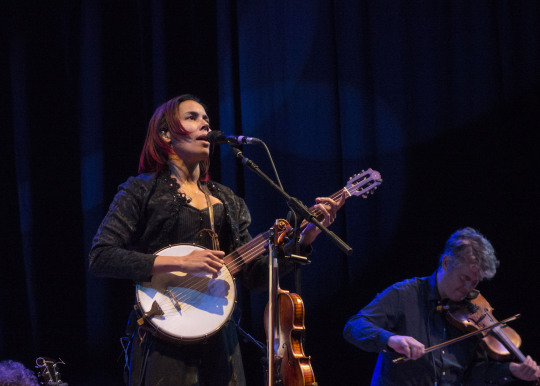
It is not just about phonetics, there is also the other Birmingham, the metropolis that forms the largest urban area in the state of Alabama, the place with the exaggerated vowel. Founded in the early 19th century, the shared name is no coincidence. Planned as a centre of industry, its founders wrapped up their vision by using the name of one of Britain’s and possibly even Europe’s first industrial centres, home to the furnaces and foundries that had built an empire. Despite this shared name and heritage, however, there is little that connects the two cities to the extent that when Birmingham England was looking to twin with a US city, its namesake was possibly never even considered. Clearly status was important and a provincial backwater would never be considered the equal to a major British city but there was also the problem that the American city along with the state in which is is situated often appears to embody all the worst aspects of the Deep South. Attempts to break down segregation following the war saw rising levels of Klan activity and the racially motivated bombing of the homes of black families in an attempt to force them out of areas of the city. The most callous and shocking of these was the bombing of the 16th Street Baptist Church in 1963 which led to the death of four girls but despite those responsible being known to the police, none were prosecuted until over a decade later. This was because support for the Klan and its activities was to be found throughout the state legislature up to the Governor, George Wallace, who through the 60s and 70s made Alabama his own fiefdom. Ironically he first ran for office as an opponent of the Klan but after losing heavily, he adopted a hard-line segregationist stance which allowed him to remain in office until 1979. In the years that have followed, it is easy to think that little has changed; Trump carried the state comfortably and the current race to be the state Senator could be won by a man facing multiple accusations of predatory sexual behaviour, assault and harassment of women, some of whom were as young as 14 when the incidents occurred. That he is completely unfit for office should be beyond question but whilst being gay or seeking an abortion will result in hellfire and damnation, using a shopping mall to prey on young girls is something bible belt Christians find easy to forgive.
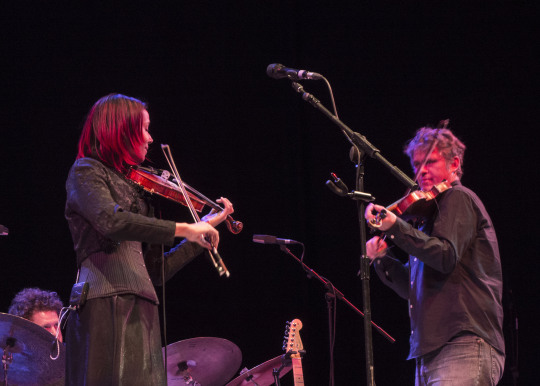
All this plays to the stereotype of the bigoted, white supremacism of the the south, a place proud of statues of slave owners and rebel generals where cars carry bumper stickers of the confederate flag, the people mocked by Neil Young in the song “Southern Man”. It is part of the story but not the whole one. The greater the suppression, the more determined the attempts to resist and some of the most significant events in the Civil Rights Movement were to take place in the state. It was in Alabama that Rosa Parks refused to give up her seat to a white passenger and also where the Selma to Montgomery marches took place to demand equal voting rights. Whilst politics and structures suppressed their voice, music provided a means through which black people could make themselves heard and tell their stories; the creativity of the southern states being expressed through blues, jazz, gospel, soul and rock ’n’ roll. One of the most distinctive of these voices was that of Odetta, a singer of extraordinary range and power born in Birmingham in 1930 who was often referred to as "The Voice of the Civil Rights Movement”. There were many remarkable things about Odetta, one of which was her operatic training, something she received whilst she was also working as a cleaner at the college she attended. Realising that her opportunities were limited, she found her training was better suited to the folk scene; in the words of Martin Luther King, she was “the Queen of American Folk” and in the film “No Direction Home”, Dylan cites her as one of his key influences. Admired as she was, however, there were few who were willing to take on the same songs and invite comparisons between their voice and hers, there would only ever be one winner.
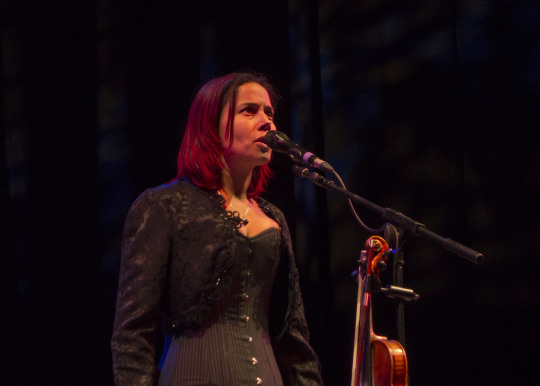
At about the midpoint of her set, Rhiannon Giddens explains the inspiration Odetta has provided for her own music. Giddens also received a classical training, at the Oberlin Conservatory in Ohio although she was able to take advantage of this without having to also scrub the floors, before finding that she was better able to express herself through folk. Giddens mentions this as she introduces her interpretation of the song “Waterboy”, a traditional folk song that Odetta frequently included in her live shows and the one she is seen performing in “No Direction Home”. It is quite simply stunning. With the accompaniment limited to a series of thuds on the bass drum and sharply strummed chords, the emphasis is very much on Giddens voice and she is able to unleash the fearsome power that the song demands. To a person, the audience sit in silence, mesmerised by the Giddens absolute mastery of the song, the silence held for a moment at the end before the richly deserved ovation. Inviting comparisons with some of the greatest American voices is something that Giddens is not daunted by, the set also includes an Aretha Franklin song, “Do Right Woman, Do Right Man” and as an encore she honours Sister Rosetta Tharpe with joyous interpretations of “Lonesome Road” and “Up Above My Head”.
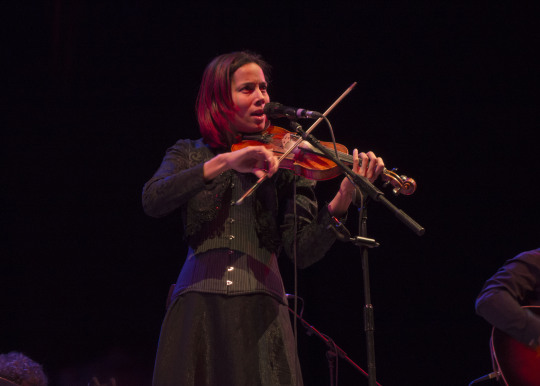
“Waterboy” was undoubtedly included as a spectacular tour de force but its subject shows that there is way more there than empty technique. Built around a cry for water from a gang of labouring men working as slaves on the plantations or possibly in a chain gang, its desperation shows how power is maintained through the deprivation of even the most basic human needs. “History in my teacher”, Giddens explains and through traditional songs and her own writing she shows an impeccable grasp of how people hold onto their dignity and spirit in the face of barbaric oppression as well as how they find the strength to fight against it. The harrowing “At The Purchases Option” is based on advert from the 1830s announcing the sale of a “smart healthy negro wench” who had a child of about nine months. When even the youngest children could be sold, the child was advertised as being at the purchases option. Whilst there is no escaping the pain, the song is a fierce cry of defiance, “you can take my body but not my soul”; she may have been abused and humiliated but there is still something there that they are unable to touch, regardless of the cruelty. “We Could Fly” is a tender song about a mother explaining to her daughter how she uses her imagination to escape the drudgery and degradation of her life and see a better future. The traditional “Pretty Saro” is sung completely a cappella whilst the song “Better Get It Right the First Time” takes a more contemporary theme in addressing a gangland killing and also features a burst of rap.
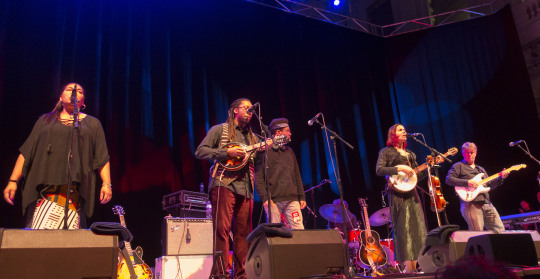
For someone who is such a charismatic and engaging performer, Giddens has seemed surprisingly reluctant to front her own band. Her recordings have often been as part of a group, whether with her her sister, who provided occasional backing vocals, in the band the Carolina Chocolate Drops, where she first worked with guitarist Hubby Jenkins, or as part of the “New Basement Tapes” that added music to lyrics Dylan had abandoned in the late 60s. Her most recent visits to the UK have been part of the transatlantic sessions that also included those who form her backing band. This, however, is her first solo tour and she seems genuinely surprised that she has sold out a venue the size of the Town Hall. Her set, however, still includes excursions into the roots music covered in the sessions featuring some bluegrass banjo and a cajun waltz. The light jazz swing of “The Love We Almost Had” lightens the tone a little and shows that she can also deal with personal themes in the challenges of trying to share your life with another. The set concludes with a rousing interpretation of the civil rights anthem, “Freedom Highway”, the song written by Pops Staples for the Selma to Montgomery marches. The themes covered in have been drawn together in one last moment of defiance.
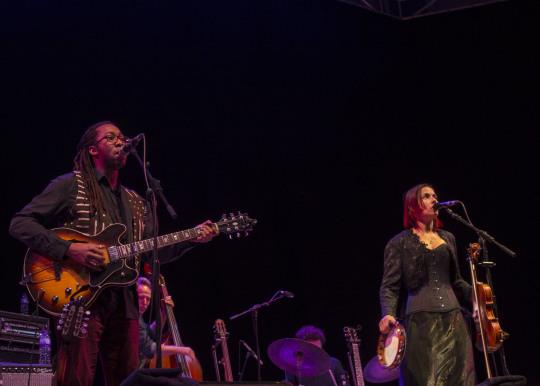
The subject matter may sound as if this was a worthy but solemn show, stories it may be important to know but hardly the stuff of great entertainment. The civil rights battles of the 50s and 60s should be part of the past but with white supremacism once again on the rise and receiving official endorsement it is important that the stories in these songs are kept alive. What lifts it, however, is Giddens impeccable musical instincts and the contagious sense of joy that she can bring to even the darkest songs. In some way, Giddens may be a custodian and curator of the rich heritage of black folk music from the deep south but she is also a mesmerising and gifted performer who is able to bring this to life. Her voice stands comparison with the greatest and there were several moments where she used it to spine tingling effect. Alongside this is an instinct for arrangement that the band had were able to rise to. It may have taken her a while to step out to the front but now she has, it seems unlikely that she will settle for the anonymity of the collective and her next visit may well be to a venue larger than the Town Hall. It was therefore a privilege to see her at this moment, the intimacy of a small venue but on the verge of something special. She sang, “We Can Fly”, perhaps she is about to.
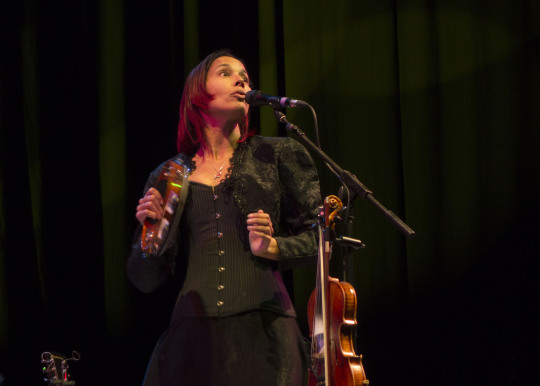
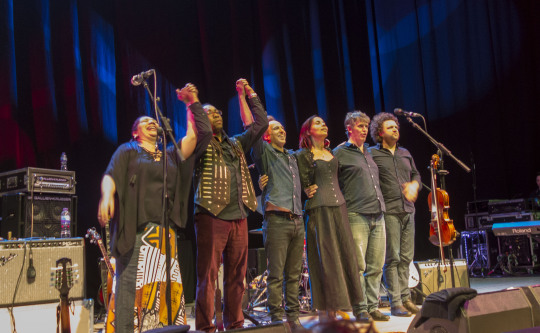
0 notes
Text
Van Morrison
Symphony Hall, Birmingham
Monday 13th November 2017
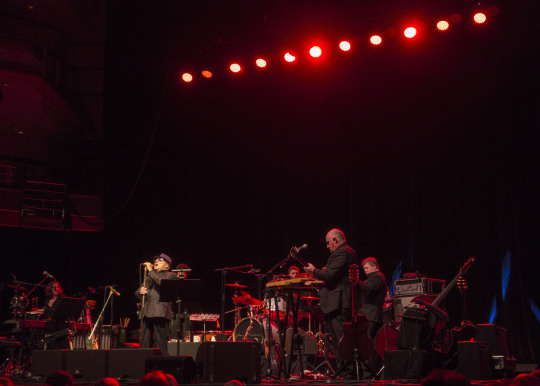
It has been a busy evening. Whilst being a multi-instrumentalist was taken as a given for everyone in the band, most could at least relax and play just one during the course of each song. Adding the percussion, however, required dexterity and alertness, one moment tapping out the rhythm on bongos, then a short solo on the vibraphone before a tingling of bells at the precise moment to illustrate the lyrics. If that wasn’t enough, two microphones placed either side of the instruments that all needed to be hit indicate that whatever else is going on, backing vocals are also required to provide an interesting harmony with another backing singer standing to the left. Amongst all this, however, the percussionist can still turn to her fellow singer and smile, she is having a good time, as are everyone else. Now I have never seen Van Morrison before but I have talked to many who have and the one thing they tend to agree on is that having a good time is something that can’t be taken as a given, either for the audience or those who share the stage with him. Many years ago, shortly after introducing myself to his music through a copy of “Astral Weeks” that I managed to pick up for £1 in a Nottingham record shop, I was dissuaded from hearing him live when a friend shared his experience of waiting for hours for him to appear only for him to disappear about twenty minutes later. More recently, I found myself relieved that I hadn’t taken the plunge at Symphony Hall a few years ago due to him spending the entire concert with his back to the audience. With time for both of us running out, however, there are only so many times that it can be put off and as I take my seat amongst the Van veterans around me I start to hear of mesmerising and spellbinding concerts along with those where he clearly couldn’t be arsed. I am confident that this will be one of the good ones.
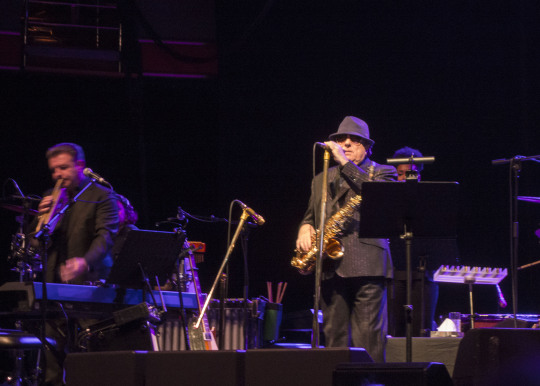
At precisely 8:00pm with the hall still fully illuminated and many still finding their seat, the band take to the stage. The star, however, waits for his introduction; musical legend and knight of the realm, Sir George Ivan Morrison walks purposefully to the microphone as the band form a semi circle around him. Dressed in a black suit with the jacket buttoned tightly, dark glasses and a small hat obscure much of his face; there is still little that he is prepared to share with us. In his arms he cradles an alto saxophone to which he will turn frequently to add stabs of brass, with an often muted trumpet played to his side, as well as a few restrained solos. It is the instrument he clearly prefers now but one that he has perhaps yet to fully master. A light swing rhythm sets the mood and forms the background as each of the band introduce themselves through a short solo; precise, exquisitely played and none outstaying their welcome. Without skipping a beat, the pace quickens, a familiar baseline emerges and a few chords on the piano appear on the off-beat. Morrison begins, “Well, it's a marvellous night for a Moondance”; the articulation may not be as precise as it was, a few words are slurred particularly as he pushes his voice to the limit of its range but the joy in its warm familiarity offers reassurance; he is here to give us a show.
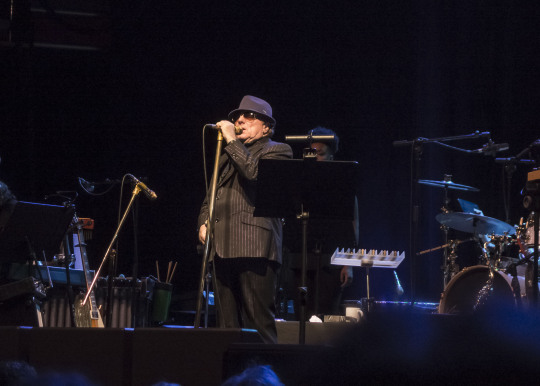
There is, however, little time to wallow in its nostalgia; “Moondance” forms part of a short medley where it is fused with a later song, “Look Beyond the Hill”, an approach he will use to present other familiar songs, in particular those he recorded with Them at the beginning of his career. Starting with “Baby Please Don’t Go”, he takes us through some of the blues standards the Ulster boys would have cut their teeth on, “Don’t Start Crying Now”, “Parchman Farm”, “Custard Pie” before “Here Comes the Night” rounds off this excursion into his distant past. Even where a return to the home key indicates that the song has reached its conclusion, the next is being counted in before the applause has started, the appreciation that we want to express is not expected nor it appears even wanted. The set may run to a generous twenty plus songs lasting nearly two hours but the star remains intent on spending as little time on stage as he can get away with. Needless to say, there are no introductions and other than a couple of muttered thank yous the only spoken words are when a technician was attempting to set a microphone to the correct height on the one occasion he played the piano, the song continuing even as the adjustments are being made.
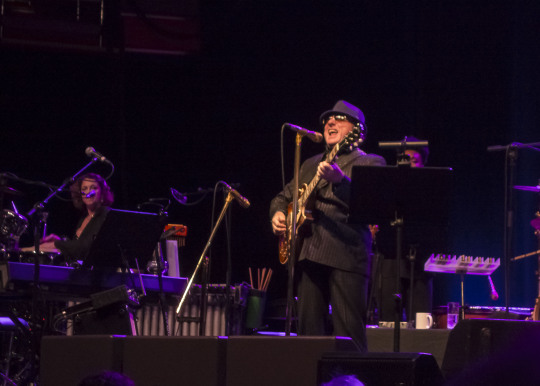
With 37 albums already to his name, number 38 is expected in a few weeks, even though its predecessor was only released in September, the breadth of Morrison’s output is staggering and in drawing on different parts of his career, he showcases the sheer quality of his music and the consistency of his writing. With so much great music, there are the inevitable disappointments about what is left out, particularly the absence of any songs from “Astral Weeks”, but alongside the familiar and expected, there were a few obscure gems that it was a pleasure to hear him return to. Throughout the playing was immaculate, the band effortlessly moving from a rolling jazz swing to blues to soft west coast rock and even to country for a cover of “I Can’t Stop Loving You”. The pace was gentle allowing space for each of the musicians the chance to adorn the songs with well judged solos, held together by Paul Moran’s carefully structured musical direction. With the band remaining on stage at the end of the show, it does become more indulgent emphasising just how meticulously the arrangements have been put together prior to that. So smoothy and seamlessly does this work that it is noticeable on the one occasion it doesn’t; as Morrison completes the first verse of “Did Ye Get Healed”, he is momentarily frozen as he waits for the refrain to be picked up, the rest of the band looking helplessly at each other before Moran points to the guitarist to get things moving. The stutter was for no longer that a couple of seconds but the moment of tension stood as a contrast to the easy feel of the remainder of the set.
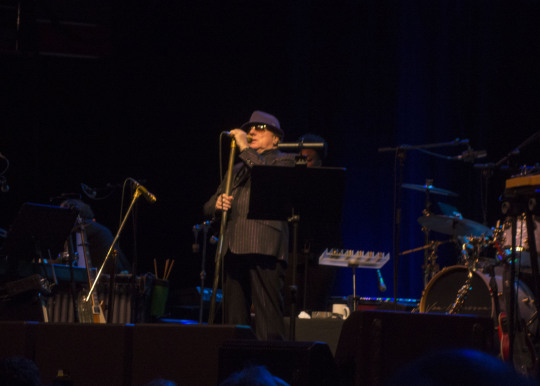
The In his early work, Morrison tended to reflect on his youth in Belfast, often from the perspective of an exile remembering the places and people as they were then. “Brown Eyed Girl”, possibly his best known song which makes it a surprise inclusion given his contrary nature, recalls a romantic encounter with a sense of joy that can either be infectious or irritating depending on your point of view. It is a song that over familiarity has not been kind to, particularly given the hamfisted way in which it is often covered, but Morrison did manage to remind us why we did, at one time, love it. For someone who has revelled in his role as a curmudgeon for the best part of his life, love and companionship are themes that occur with a surprising frequency in his lyrics. “Warm Love” shares a tender moment of intimacy, something that “Vanlose Stairway” tries to recapture despite the despite the distance that now separates him from the other person. Through this search for personal fulfilment his songs are united by an underlying spiritual quest. This was rarely overtly religious, although he wasn’t averse to this as on “Whenever God Shines His Light”, originally performed with Cliff Richard although his female backing singers now provide a more intriguing contrast to his own voice. Mostly, however, his interest is in how the resolve to carry on can be found within, of how we are strengthened by the way in which we respond to adversity and the terrible things that life can throw at us. “Days Like This” is typical in this respect, whilst there is nothing in particular to face up to, “When you don't get betrayed by that old Judas kiss”; the struggle to carry on can still be very real. In “Little Village”, his quest is to ”Hear the voice of the silence, in the evening; In the long cool summer nights”, a rural idyll where “Everything’s going to be alright”. This sense of optimism, that deep though the well may be, there will be another day and that within us we have the strength and courage to face it, is what makes Morrison’s work so uplifting and is what, despite his gruff exterior, gives an emotional heart and warmth to the show.
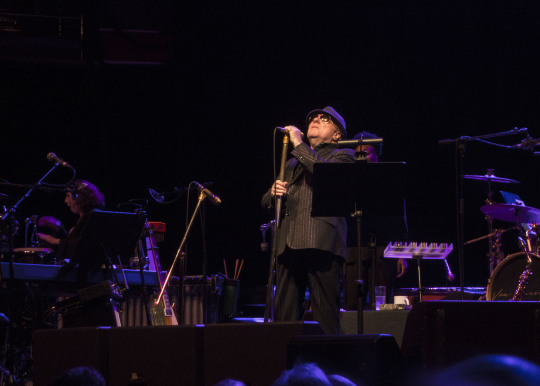
Morrison returns to the early days once more for “Gloria” for which the audience are on their feet and chanting back the letters as he spells out the name, the only time deliberately looks for a response. “Thanks to the band” is his final comment before he leaves them to indulge themselves more than us as he makes his escape before the audience fully realise it is over. Morrison’s reputations as an awkward live performer has always put me off seeing him before but tonight showed the passion that he has always had for his music, and probably explains why when it isn’t happening he can’t fake it. With a superb backing band, it was a show of warmth and sincerity, a legendary act who I am glad I finally managed to get around to seeing. “A marvellous night for a Moondance?” - you bet.
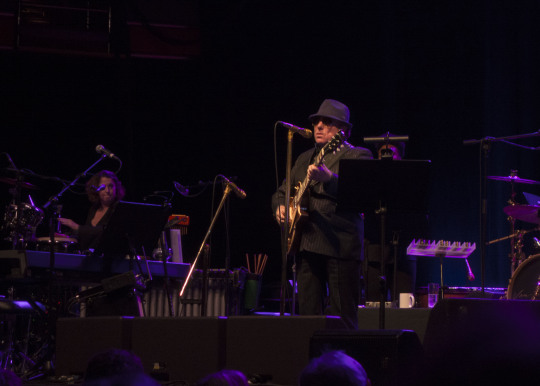
0 notes
Text
Nick Cave and the Bad Seeds
Motorpoint Arena, Nottingham
Thursday 28th September 2017
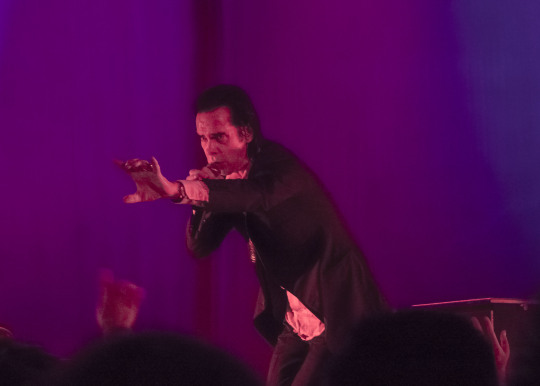
The train was waiting as I made my way down the stairs and onto the platform. I had checked the display in the concourse and the man in the hi-vis orange jacket standing by the ticket barrier had even given me directions as I went through but stepping through that open door still felt like a leap of faith. I couldn’t see the board on the platform, there was nothing on the train to indicate its destination and the display in the carriage was blank, as was the one above my seat that should have confirmed my reservation. I took my place and shuffled uncomfortably, desperately awaiting confirmation that the journey I was taking was the one I had booked. Taking out my book, I tried to read, my eyes scanning across the words but their meaning was obscured by uncertainty. I gave up and putting the book down, I noticed that the lady next to me was shuffling through her tickets whilst staring at the same blank board that offered me no reassurance. I never used to have a problem striking up a conversation on a train; I quite enjoyed the forced intimacy of spending a few hours next to or opposite a complete stranger and I had usually at least exchanged pleasantries before the journey had started. Now, however, I use the time to listen to the music that is demanding my attention; the headphones inserted into my ears isolating me from my fellow passengers. I am not alone; the carriage is in silence, each person bringing along their entertainment or happy spend the time with their own thoughts. With both of us in a similar state of agitation, however, I decide there is enough common ground to broach the subject of our destination. Having offered each other some reassurance, the conversation quickly moves onto the reason for our journey before we share a few things about ourselves. It quickly becomes apparent that life has dealt my companion a tough hand. She has had to acquaint herself with public transport following a recent diagnosis of MS, her sister had suffered a brain haemorrhage about a year ago leading to her untimely death at the age of 48 and her daughter’s first two children both died in infancy. Despite the grief that she carries with her, however, she was a remarkably uplifting person to talk to; determined not to let these shattering events define her, she presents them as a statement of fact. She is neither looking for sympathy nor to place some of her burden onto the shoulders of the of the stranger next to her. Her life will go on, she is proud to talk of her daughter’s recent wedding and excited that at the third attempt, she now has a healthy grandchild on which she can dote.
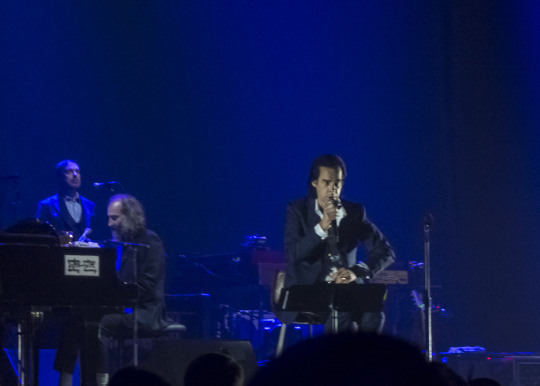
At one time, the loss of two children would not have been unusual. In the late 19th century, infant mortality was a staggering 15%, young bodies with limited immunity no match for the bacteria that lurked in the insanitary conditions and contaminated water. Now, however, we expect things to be different, mothers are regularly monitored during pregnancy and even if things do go wrong, the expectation is that the care is there to make it alright; pushing the very boundaries of life as premature babies weighing just over a pound and born two-thirds of the way through the normal term have a very good chance surviving. The death of children, therefore, is the one thing most parents will feel that they will never have to prepare for which makes the grief harder on the rare occasions that it has to be faced. For an artist, the grief will be absorbed into their creativity, showing itself in what are often uncompromising or harrowing pieces of work. Following the death of his two children from scarlet fever, the writer Friedrich Rückert frantically wrote a series of poems called “Kindertotenlieder”. Never intended for publication, they only came to light many years after his death where they attracted the attention of Gustav Mahler who decided to score them. It seems a strange decision; Mahler, whose own children were very much alive at the time, had more than a passing acquaintance with the hammer blows of fate, his sixth symphony ends with three, and his wife pleaded with him not to tempt providence so brazenly. He remained resolute; he was no stranger to the death of children having lost eight siblings of his own and there was certainly a practical reason for finishing the work in providing songs to soothe the passing of so many infants. Needless to say, his wife’s fears proved all too prophetic and four years after completing the work, his daughter, Maria, died, again of scarlet fever. As an artist he wrote the songs by placing himself in the position of a parent who had lost a child, as a father who had lived through it, however, he reasoned that he would not have been able to write them.
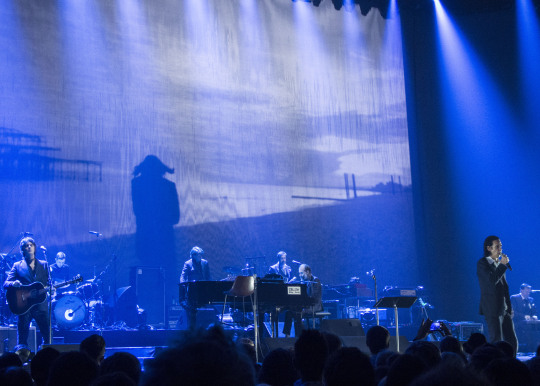
Nick Cave is certainly no stranger to oppressive cruelty of fate. As far back The Birthday Party, his music has shown an unhinged emotional intensity with his lyrics built on Old Testament imagery of sin, debauchery and the inevitable damnation; there was always a violent price to be paid for the few pleasures in life. Skeletal thin, jet black hair against pale white skin and always dressed in a black suit, he became the embodiment of gothic rock, although unlike those who slavishly followed, he was never confined by the ridiculous conventions of this. Darkness, therefore, has always enveloped his work and death his companion on this road. No stranger to loss, his mother informed him of his father’s death in a car accident while she was bailing him out of jail following his arrest for burglary, there was little that could prepare him for when fate decided to deliver him the cruelest blow of all. His son, Arthur, had taken LSD for the first time and during the hallucination had wandered too close to the edge of the cliff, falling to his death; he was just 15. Cave describes the after effects of this trauma in the film “One More Time With Feeling” and the sadness that pervades the album that followed sees the separation between his art and reality at the narrowest it has ever been. The songs from “Skeleton Tree” all but one feature in the set and the tragedy of their origin could make this a bleak and harrowing evening; in fact the opposite happens, building on the raw emotion of the music, Cave delivers a show that is uplifting and life affirming.

"All the things we love, we lose” Cave sings on “Anthrocene”, the sparse jazzy rumination on loss with which he opens. Seated at the front of the stage, he quietly half sings, half speaks the lyrics, the clarity of his voice and the emotional honesty of the words startling in an artist who is accustomed to disguising his meaning. Cave has been keen to distance his work from his grief but it is difficult to view “Jesus Alone” as anything other than highly personal and direct; how else to interpret "You fell from the sky and crash landed in a field” and the harrowing cry of grief “With my voice I am calling you”. Delicate percussion flits beneath the words, a few notes from the piano search for a melody and there is the odd hint of scratchy guitar but the main accompaniment is from the deep swells of bass, unnerving and desolate. With “Magneto” the sound is at its most stark adding a frightening intensity to the anger he feels when words of condolence from a well-wisher make him consider whether he has become a figure of pity. There is only so long, however, that this brooding intensity can keep the fury in check and with “Higgs Boson Blues” it is finally unleashed, Cave prowling very front of the stage, staring at the audience so that arms reach upwards and hands stretch out towards him. He teases, staying just out of reach until, with arms below him stretched to the limit, he leans forward and lets them bear him, half crowd surfing, words directed straight at the person standing just behind those supporting him. From Robert Johnson’s encounter with the devil via the motel room where Martin Luther King was assassinated to Miley Cyrus floating in a swimming pool, high and low culture, significant and insignificant events, entwined in their fate, a God particle to determine their path. Once released, The Bad Seeds, are formidable, “From Her to Eternity”, is frightening; sharp, irregular and discordant whilst the ferocity of “Tupelo” is suitably apocalyptic.

The storm subsides; wonderful harmonies enhance the beautiful melody of “The Ship Song” which is followed by a sublime “Into My Arms”, a simple ode to love done, it appears, without a hint of irony. The pain, however, returns, unbearable on the repeated plaintive cry of “nothing really matters any more” from “I Need You” whilst “Girl in Amber” again shows that the consoling words of others offer no respite. Having once again taken us to the depths, the single bell that introduces “Red Right Hand” provides the relief and is magnificent. Seeing a girl sitting on the shoulders of the person with her, Cave approaches her, raising his hand but keeping a small gap between the ends of his fingers and hers. For a while they look at each other, the words of the song directed straight at her and adapted to take into account the person bearing her weight. Then another ferocious outbreak of noise breaks the moment before the story can continue, a incredible and magnetic stage presence impeccably controlled. The vicious urgency of “The Mercy Seat” is similarly stunning but the final two songs manage to find their way into even the hardest of hearts. The soothing organ gives “Distant Sky” a weightlessness, enhanced by the celestial voice of Else Torp whose image appears on the backdrop. “They told us our gods would outlive us; But they lied”; the moment at which all hope has been lost but Torp’s calming voice begins to offer reassurance; “See the sun, see it rising; See it rising, rising in your eyes”. With “Skeleton Tree” there is finally a path forward, the grief may not be over, there is no set time beyond which you emerge fully recovered but the darkness has gained some definition, an acceptance of the different way in which life will go on, “And it's alright now”.
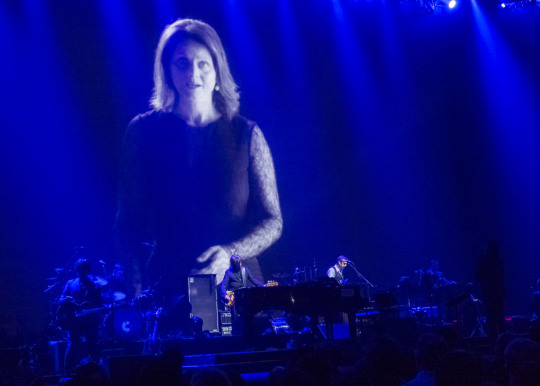
The stage invasion started during “The Weeping Song”; hordes clambering to find somewhere to stand obscuring the band for most of the encores. Cave himself, however, had left, heading out into the audience and climbing the aisles in the tiered seating at the side. “Stagger Lee” saw him move to the other side, stopping about half way along the hall to deliver the savage vocal. Finishing with “Push the Sky Away”’ he gets those on the stage to crouch so that he can introduce the Bad Seeds who have been in blistering form all night, an extraordinary end to what had been an extraordinary concert. Whilst Cave’s music is something I have listened to since he was in The Birthday Party and I have several of his albums sitting at home, I have never seen him live before which has always made me more of an admirer than a fan. Talking to a couple before the concert, they remarked that now in their late fifties they are making up for lost time, taking the opportunity to see the acts that have been there through their life while they still can. I nodded in agreement with this, I have certainly had the opportunity to see Cave before but for one reason or another have never taken it. Part of the reason for this is that he rarely seems to venture into the West Midlands so when the Nottingham date was announced it was right to take the plunge. Having do so, I made the transition to fan, the songs are intelligent, emotional and thought provoking whilst remaining hugely entertaining, the Bad Seeds provide tight and inventive backing and Cave can command a huge arena with the the same magnetic charisma as Springsteen or Bowie. If my first concert had been back in the eighties then I could have become completely obsessive, a fan the like of which Cave already seems to possess in abundance. Maybe then, both for my sake and for his, it was right to bide my time.
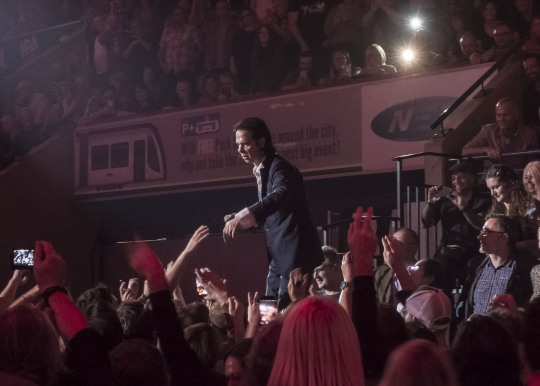
0 notes
Text
Sparks
O2 Institute, Birmingham
Sunday 24th September 2017
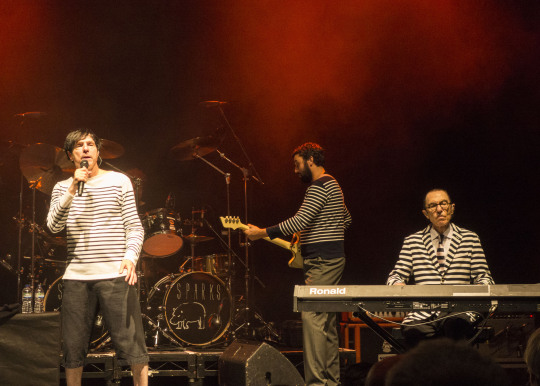
Friday morning - throughout the rest of the week, the topic of conversation was open. True, during the season, Monday would gain structure as we reflected on the football from the previous weekend, analysing how what seemed like a home banker against Queens Park Rangers had gone so horribly wrong. From the beginning of May, however, Monday would be like any other day, open to the ebbs and flows of the big wide world outside the small one in which we lived. Friday was different, winter, summer there was only ever one topic of conversation and that was Top of the Pops. It seems incredible now to think that a 30 minute programme of either promotional films or artists miming to their records could be so influential but for its prime time slot on a Thursday evening, the whole family would sit around the telly and absorb what was generally youth culture. With the only criteria for an appearance being to have sold a lot of records, there was the occasional act that our parents would appreciate, Englebert Humperdinck, Lena Martell, the Band of the Royal Dragoon Scots Guards, but mostly it was ours and we were indulged this weekly fix so that we could sound knowledgeable the following morning. The late nights desperately trying coax something listenable from Radio Luxembourg may have given us the music but TOTP added the visuals and our discussions were as much about what we had seen as heard.
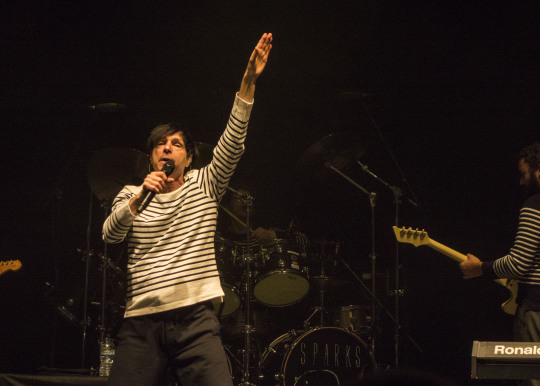
For the artists, TOTP was a huge break; massively increasing their potential audience such that a successful appearance would lead to a surge in sales that drove the record further up the charts. The pressure was on, in just two or three minutes they had to make a big enough impact to be the subject of those Friday morning discussions. Many were young, very young in some cases and in the days before they were all stage school graduates, knew little about how to project themselves through a lens. Performing directly to the camera made you look desperate, trying to ignore it made it look as if you didn’t care and soon lost those potential sales. The ones remembered now are those who managed to get it right but the repeats of full shows shown on BBC4 show how many didn’t, excruciatingly bad performances that meant the chance had been lost and the audience would remain selective.
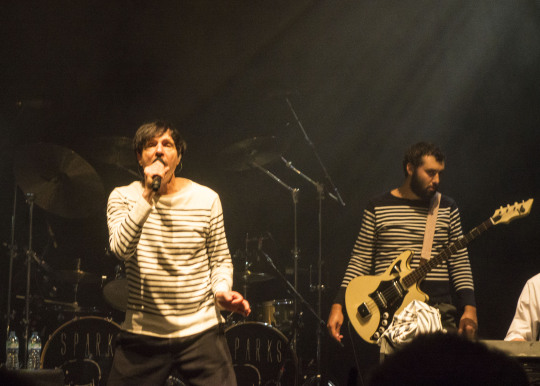
Occasionally, an act so out there would appear that it was difficult to quite believe what you were seeing. “Did you watch Top of the Pops?” we would excitedly ask each other the following morning as we sought confirmation that we had actually seen what we thought we had. These would often draw the most negative comments from our parents which, of course, made them all the more appealing to us. The appearance of Sparks on the show was one of those transformative experiences; once you had entered their world there was no way of leaving it. The singer, full on gender blurring glam rock with a thick main of black curly hair and a gold scarf tied loosely round his neck, was a whirl of hyperactivity even within the tight constraints of the stage. Peering through the camera rather than at it, his penetrating gaze drew you into the weird falsetto of his voice. Even his flamboyant charisma, however, was upstaged by the figure sitting alongside him. His fingers moved over the keys as his eyes darted from one side to the other, seemingly in continuous disapproval of the exuberance at his side. The most provocative part, however, was the small moustache that rested on his upper lip, the thing that, apparently led John Lennon to phone up Ringo Star to exclaim, “It’s Hitler with Marc Bolan”. The parts had been rehearsed and developed for years but now they had also had a killer song. Even though the impression made by “This Town Ain’t Big Enough for Both of Us” has lasted for over forty years, it remains a song that is remarkably difficult to sing along to. The rollercoaster changes in pitch, awkward tonal variations and verses stuffed with words make it difficult to grasp, however many times you hear it. Despite the number of times I have listened to it, I still get little further than “Zoo time is she and you time” before my stuttering karaoke ends.
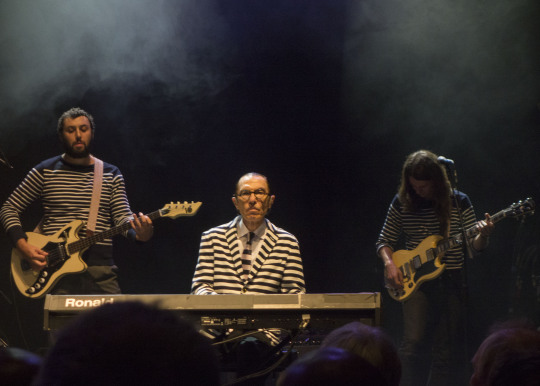
Russell Mael has no such problems. He will celebrate his 69th during this tour but he retains both the energy and the voice of his younger self. As he sings “I ain’t going to leave”, he raises his right arm in a gesture of defiance; the skin may hang a little more loosely from his frame, the lines on his face are harder to conceal but towards the end of a set in which he has worked harder than many less than half his age, he still has enough left for this intoxicating anthem to youthful swagger. One of the many remarkable things is that unlike many of his peers, his hold on those dense, complex and idiosyncratic lyrics is so secure he manages the whole set without the need of a single prompt. We last saw the Mael brothers about five years ago on the “Two Hands, One Mouth” tour where Ron’s keyboards provided the only accompaniment to his brother’s vocals. This time they have arrived with a five piece backing band so that they can recreate the glam rock stomp of their early years. They fizz through the strange vocal variations of “Propaganda” before unleashing a fearsome “At Home, At Work, At Play”, louder and with an intensity that it has rarely seen before. Shimmering strings and a steady disco beat gave a wondrous setting for the regret of “When Do I Get to Sing My Way” and for artists so seeped in irony, “Never Turn Your Back on Mother Earth”, makes its point clearly and directly, its relevance now sadly greater than when it was recorded. The irony returns for “Dick Around”, a compellingly arranged and dramatic overture to indolence and the disco thrill of “The Number 1 Song in Heaven” is as infectious as ever, also providing the opportunity for Ron to step out from behind his keyboards, roll up his sleeves and indulge in his one moment of what I suppose we now ought to call grandad dancing. After throwing everything at “This Town Ain’t Big Enough for Both of Us”, they take things down a little for “Hospitality on Parade” and the first encore “Johnny Delusional”, a product of their recent collaboration with Franz Ferdinand. The wild glam rock nostalgia returns, however, for “Amateur Hour”, a final moment of clever infectious pop where the thrill is as great as ever.
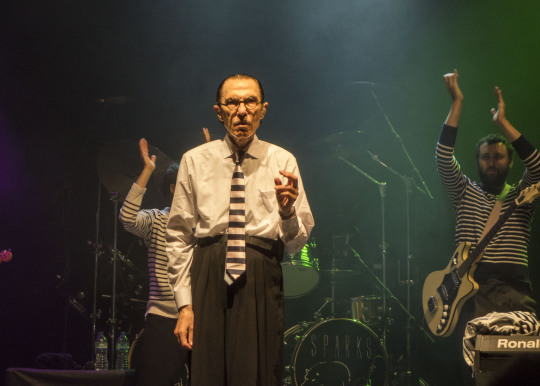
The point of the “Two Hands, One Mouth” tour was to reflect on their long career; it began with an overture that consisted of their signature melodies and the only new song included formed the title for the enterprise. This time, however, there is a new album, their 23rd, and with arch, witty lyrics, stomping beats and Russell’s still haunting falsetto, “Hippopotamus” is one of their best. The songs have already made their mark; despite its recent release, they are already familiar and are greeted by the audience with the same wild enthusiasm as the hits from all those years ago. Starting with “What the Hell is it This Time”, the urgent synthesised strings take us immediately into the mind of God, not the omnipotent and vengeful God of the Bible but one who in old age can no longer disguise his irritation at the petty things people bother him with; “My girl has left; My dog has left; I’ve cracked up my car” and “His plate is filled with famine and with clean wholesome air; If Arsenal wins; He really don’t care” which is rapidly becoming one of my favourite lines in any song. Russell’s energetic performance may be his way of arresting his own drift towards becoming an elderly pop statesman but age forms the theme that unites many of the songs on “Hippopotamus”. Even the apparently random word association of the title track, the first song as far as I know to mention “Titus Andronicus”, can be seen as a reflection on the confusion and declining short term memory of age; “How did it get there? How did it get there? How did it get there? I don't know”. “Missionary Position” covers how the thrill of making love is lost through routine and familiarity whilst the playful “I Wish You Were Fun” takes this further to explore how even those things we once liked about another person can be lost over the years. With “Édith Piaf (Said It Better Than Me)” they return to the same theme as “When Do I Get to Sing My Way” but whilst then the singer could still aspire to become the torch singer, now he knows that he will never achieve that level of emotional clarity; “Live fast and die young, live fast and die young, live fast and die young; Too late for that, too late for that”. The most haunting song, however, is the one that at first seems the most throwaway. Introducing the song, Russell sets the scene by starting a story that he is unable to finish as he can’t remember what he was saying. For once, the band are left in the shadows at the back of the stage and Russel’s tender vocal is accompanied only by Ron’s piano. The effect is to focus the attention onto the words, an insightful account into the onset of dementia, a gradual withdraw of the person from the world around the. It emphasises that their unorthodox and at times just plain weird approach to songwriting always had a serious intent.
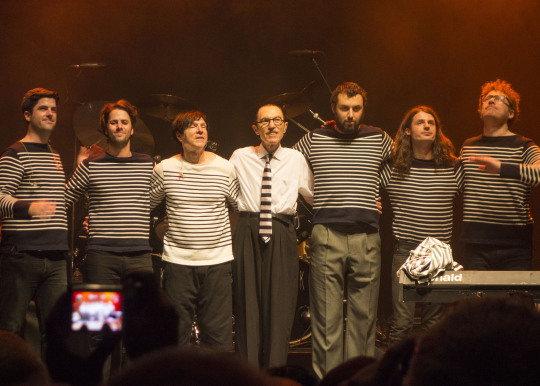
The last time we saw Sparks was at the same venue and arriving just after the doors had opened, there were few others around so that we were able to find a place close to the stage. This time was different; walking through Digbeth at about 6:30 we could see that a lengthy queue had already formed, the interest and excitement palpable as we took our places. Whilst there are a few younger people around us, the majority of the audience are of an age and a recent appearance on Newsnight together with the release of a new album has both helped to remind people that they still exist and also that they still make fascinating music. A repeated “Home; My Baby’s Taking Me Home”’ forms one of the songs heard towards the end of the set but whilst it is stretching things to view this as some sort of homecoming, the time they spent in the UK in the early 70s did help to shape their music and introduce them to an audience that understood it. Early on, Russell mentions that Birmingham was the home of Muff Winwood, the producer who helped to create the sound that was so startling on that ToTP appearance all those years ago. If this was to help him engage with the audience, however, he didn’t really need to, they were there from the moment they walked on stage leaving the brothers both surprised and moved by the warmth of the reaction. There is really no one else quite like them, a masterclass that shows that they remain as intriguing and relevant as ever.
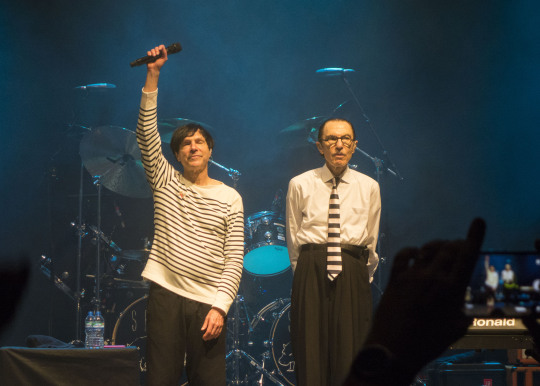
0 notes
Text
Beyond The Tracks
Eastside Park, Birmingham
Friday 15th September 2017

I had arrived early. This is not unusual, when it says on the tickets that the doors open at a particular time, I interpret that as meaning that if I arrive later I will have missed something. Experience has taught me that the only thing I will miss is the opportunity to get a drink from the bar without queuing but that never brings me to my senses. To make matters worse, and much to the annoyance of my wife, I also completely overestimate the time it will take me to get there meaning that I mostly arrive at least 15 minutes before I can get in. I am not alone in this, there are always a few others standing around kicking their heals outside before they are able to enter and do the same thing inside. I therefore made sure that the train I caught arrived in Birmingham about an hour and a half before the 2:00pm start, it could have been late or cancelled, best to avoid the risk, and after having some lunch, even I wouldn’t stand around for that length of time, I arrive at Eastside Park at 1:45. The open space that forms the park has been enclosed by a solid fence through which there is a single access point around which a small group of people have started to gather. The purple pyramid of the stage can be seen above the fence and alongside this stands the once proud facade of Curzon Street Station, soon to find a new life as the terminus for HS2. From the entrance, a walkway leads to Millennium Point and this provides some shelter for those few waiting as the rain starts to fall from the grey clouds overhead. Despite the rain, a small queue forms at the scheduled time but with what sounds like a last minute soundcheck still taking place, there is still more waiting before we eventually pass through the security check and onto the site.

With these moments to spare, I spend my time gazing at my phone, following a story unfolding over a billion kilometres away. As I pulled my coat around me for a little extra warmth, a small probe is passing inside the orbit of the icy moon of Enceladus and making a final precarious traverse through the rings of Saturn. It is a journey from which it will never return; unlike Voyager that will spend its life drifting through the vast emptiness of interstellar space, Cassini’s fate is much more violent. Its final image shows the blurred mass of clouds into which it will soon plunge, Saturn’s haze gives the impression of a smooth benign world in contrast to the storms that are written onto the face of Jupiter but this is but a thin disguise. Careering into the atmosphere at a speed of tens of thousands of metres every second, any of it that survives the temperature will be thrown around by winds that reach over 500 miles per hour circling around planet sized cyclones. The once proud space ship reduced to particles little bigger than a few atoms and remaining a part of the planet until that itself is brutally destroyed.

Saturn’s thin atmosphere would carry the final cries of the probe as it is ripped apart but Cassini has spent most of its twenty years in the silent vacuum of space. In our imagination, however, there is a music to this emptiness, the strange other worldliness of the theremin in 50s sci-fi, the serene majesty of “The Blue Danube” to accompany a gracefully revolving space station in “2001 A Space Odyssey" and the resplendent anthems John Williams wrote for “Star Wars”. The maelstrom into which Cassini has descended however, requires something more terrifying, something like the big beats and wild electronic sound of Orbital and in particular the awesome “Satan”. The repeated title sets the tone, the thumping beat is relentless and carefully assembled sounds and samples build to drive the music through its nightmare journey. Images flash on the screen, symbols, faces, the soundtrack to destruction. A thrilling moment of utter desolation fitting for Cassini’s violent grande finale.

Standing on a raised platform behind the screens, for most the set you are aware of the presence of Paul and Phil Hartnoll through the lights that sit on the side of their head. There may be an entirely practical reason for these, allowing them to see what they are doing, but its gives them an identity whilst also providing a hauntingly strange image. As they prowl the stage in preparation, like many in their field, they are quiet, sober and look slightly awkward when someone in the audience yells out to them. With the lights in place, however, they become wild mad scientists creating the trance inducing sounds that vibrate through every muscle and encouraging the audience to ever greater levels of energy sapping movement. The repetitive beats are ever present but the intensity varies, moments of calm in between the peaks that unleash a frenzy of wild headbanging. The open sky and muddy ground recalled their early guerrilla raves in fields around the M25 but Orbital’s designs were always more inventive, more intricate and more melodic than many of their contemporaries. The setting is safer now; warnings outside, searches as we enter and high profile security make it clear that a drug induced daze is no longer part of the experience and aside from a few whiffs of cannabis, no one seems to be on anything stronger than Mad Goose and the music itself. Little else is needed and in any case, the average age of the crowd would indicate that youthful recklessness is something that was long ago left one of those home counties fields; it is rave nostalgia we are here for.

This short tour of European festivals comes after a break of five years during which time the two brothers have worked on separate projects. Their most recent album, “Wonky” appeared five years ago but they haven’t been entirely idle and whilst much of the set is familiar, it has been reimagined and adapted so that the sounds from different parts of their career can merge into one unyielding whole. “Halcyon” gains the singalong sample of “Heaven is a Place on Earth” whilst “Wonky”, despite its recent origin, has gained extra, well, wonkiness. The remorseless Acid House rush of “Chime” sounds as fresh as it did over a quarter of a century ago but a city centre means that rather than an all nighter, there is a strictly enforced curfew. As the bleeps and grind of “Where Is It Going” bring the set to a close, it all seems as if we are only just getting started. As we move away from the stage, the ghostly imprint of those four white lights is retained as we make our way into the darkness of the park.

Many years ago I was directing a production of “Measure for Measure” which I chose to set in a bleak and polluted post industrial landscape overseen by a military dictatorship, it seemed like a good idea at the time. Music was an important part of setting this scene and to achieve this I used snippets of tracks by The KFL, Nine Inch Nails and Can. Alongside these, I also used music from an album that I had bought about a month or so earlier and fitted what I wanted perfectly. About a couple of years later, I was acting in a production of “Closer” and as a background for the scene in the lap dancing club, the director had chose the same album unaware of my previous use of the music. In both cases, it worked perfectly, creating an unsettling mood to underpin the complexities in the drama. The album was, of course, “Leftism” and to hear it performed in its entirety was a reminder of just how breathtaking an album it is. “Release the Pressure”, the first track and one I had used all those years ago, is magnificent, building relentlessly from its quiet opening, increasing the tension until the full force of the thunderous beats can be unleashed. It does exactly what it says it will do and as MC Earl Sixteen, one of several original contributors, adds his plea for “peace and unity”, the thrill of starting the journey is as great as ever. The ferocious and dizzying chant of “Afro Beat” is spectacularly delivered by vocalist Djum Djum who also adding the freakish sound of a theremin, there had to be one around, towards the end. It is the dynamics of “Leftism” that makes it such a flawless album and after the unrestrained rush of the first two tracks, “Melt” provides an opportunity to become lost in its serene beauty.

The sole original member of Leftfield is Neil Barnes who, until the end when he moves to the front to thank us and tell us how emotional it has been, spends most of the set hidden away behind banks of keyboards at the back of the stage. To his right another band member adds additional keyboards but it is interesting to note that, unlike Orbital, he does not rely entirely on electronics to create the sound. A drummer is there to provide most of the heavy beats and during the set, Barnes uses a melodica and what looks like a home made single string percussive instrument to add some acoustic textures. Despite the thumping beats that underpin it, “Original” offers a little more respite but is let down a little by the limited vocal abilities of the singer. The unstoppable force of “Black Flute” and “Space Shanty” leads to an incredible “Inspection Check One”, two MCs prowling the stage repeating the title as the rhythms pound out of the speakers. It was an incredible moment but topped by the unbelievable “Open Up”, the mighty presence of John Lydon’s still potent despite only appearing as a back projection of the original video recorded over twenty years ago. Extended well beyond its original length, its remarkable energy allied to Lydon’s sneer captures one last ecstatic moment before the solemn come down of “21st Century Poem”. Then, abruptly, it was over, Barnes makes his rare foray to the front of the stage humbly accepting the applause, the reluctant driving force behind the astonishing creativity.

Whilst we were keen to seen both of the main acts this evening, for us it was Leftfield that were the main draw. It only takes one thing to affect the best laid plans, however, and today we had several. Firstly, Claire was summoned to a meeting in London, secondly a fire in Milton Keynes closed the line back to Birmingham and thirdly an “incident” at Princes Risborough also closed the main alternative route back. The result was that she only made it back in time to see Lydon leering “burn Hollywood burn” from the screen at the back of the stage, missing most of Leftfield and the two bands that preceded them. Of these Jagwar Ma’s indie dance was perfect for a festival of 90s nostalgia. Guitar and nimble bass are pretty standard but it is the keyboards and programmed drum from the third member of the band that provide the rhythm and add a distinctive quality to their sound. Appropriately the sun decided to put in an appearance for the sunshine psychedelia of “Come Save Me”, prompting the singer to comment that it is the first time he has seen it since their arrival in the UK; they are from Sydney. Needless to say it is soon raining again. Arriving first, the audience for Pixx is sparse but they do well to overcome this and draw those who have arrived early to the stage. They have a rather more conventional line-up, including both drums and bass to lay down the rhythm, but above this airy electronic textures help to create wonderfully atmospheric textures for the sombre lyrics. The distorted time signature of “Romance” forms a compelling highlight and she also includes an excellent cover of Joe Jackson’s “It’s Different for Girls”. A late DJ slot from Sister Bliss gives a reminder of the sheer exuberance of Faithless, culminating in the infectious groove of “Insomnia”.

The festival runs for another two days but from now on electronic dance music makes was for indie show gazing. There was something quite special about the inner city setting, with trains passing on one side and apartments overlooking the park on the other, there was a definite feeling of the city carrying on as normal while the party was going on. The organisation seemed good, the site seemed to clear quickly although the queues for the bar and toilets did seem to be quite long at times. The park seemed full although I suspect short of the 5000 sales they were aiming for, emails offering weekend passes and reduced price tickets for the Sunday suggested that sales had been a little slower than predicted. The strong line-up, however, did bring people in from further afield, the man we chatted to as we waited for Orbital had travelled down from York and I even heard of a couple who had flown over from the New one. It seems unlikely that the festival will be repeated next year but the hope is that an inner city festival will soon become a regular feature in Birmingham. Earlier this year Orbital played the Bluedot Festival at Jodrell Bank where they were able to start their set with the rhythmic signal of a collapsing star picked up by the Lovell telescope. Whether they were aware of the final signals picked up from Cassini today I cannot say but in their audience there was one who briefly raised a glass.

0 notes
Text
Moseley Folk Festival
Moseley Park, Birmingham
Sunday 3rd September 2017
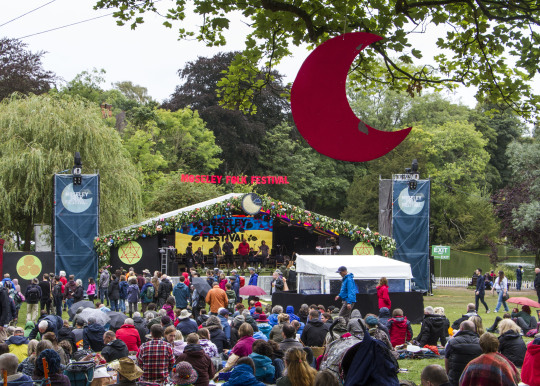
For two glorious days, Moseley Park has been bathed in warm sunshine making it possible to believe that this was the start of glorious extended summer, or possibly a better one to compensate for the one we didn’t get in August. The vibrant greens, however, are now duller and flecked with yellow or brown, the paths are strewn with leaves and the earlier sunset brings a chill to the dark nights. By Sunday morning the pretence was over, grey clouds replaced blue skies discharging their content over the dry ground. The warmth of the sun was now hidden and the shorts and t-shirt I had worn for the first two days would no longer keep me warm; needless to say the shades were left at home. The chill of autumn, however, seems appropriate. Sunny optimism was right for Amy Macdonald, the warm glow of nostalgia for Fairport Convention but today we have the icy cold of Laura Marling, just the time for autumn to announce itself.
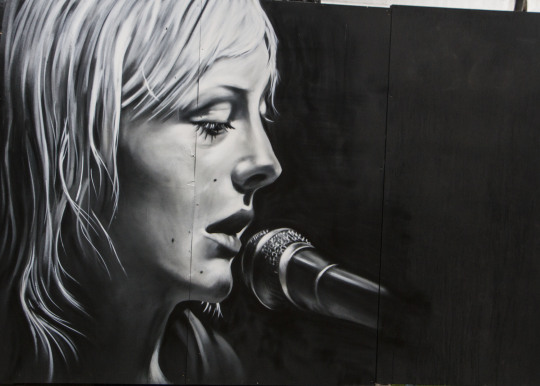
There are a number reasons why I shouldn’t like Laura Marling. From her aloof detached manner as she takes to the stage she makes it clear we are here on her terms and we should be grateful for the hour or so we spend in her presence. Her one comment as is to say we all look nice in our “macs”, the mocking tone contrasting our soaked and bedraggled selves with the immaculate figure in front of us. She runs through about half a dozen songs from her latest album, “Semper Fermina”, before she says another word. She is momentarily distracted when a member of the audience shouts out a song request but the girl next to me yelling out “you’re a genius” is ignored, and coming when everything else was silent, there is no way she wouldn’t have heard it. The detached manner seems to apply to her band as well, each works in their own space and there is little sense of camaraderie; as it is the last night of the tour she asks them to share something with the audience but it all seems a little forced and inevitably Marling’s own contribution was the least revealing. The long solo acoustic middle part of the set makes the point that whilst it was nice to have them around, they weren’t essential. The rest of the band had left the stage for this and when they return she asks them what they had been up to back there, a little chink perhaps in the armour, without her domineering presence they may actually have had a pretty good time. This aloof manner may well be due to her being very posh; I’m not just talking Genesis public school posh, Marling is the daughter of a Baronet, aristocracy, the gentry that the music of the people has always been against.
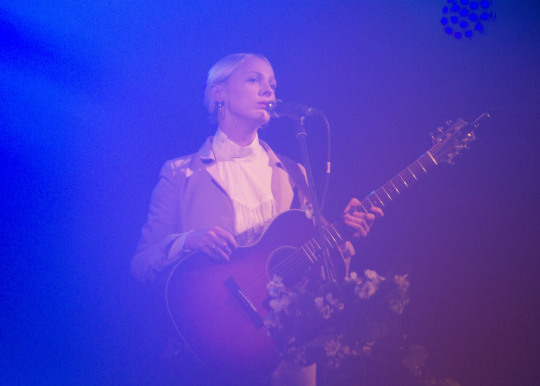
For all this, however, I can’t dislike her. The icy cool detachment gives her a presence that is magnetic and she effortlessly holds the attention of the audience. As the applause dies down after each song, there is silence, no background chatter, everyone held in rapt attention as they wait for the next song. The intricate percussion and fluid baseline of “Soothing” immediately grabs the attention and the subtle textures of the music are so absorbing that she doesn’t let go. The latin title of the album, which means “always woman”, is a phrase she picked up from the Roman poet Virgil and she has had it in her mind for about six years until she felt she had the songs to do it justice. These deal with women’s perspectives of women, as close or more distant friends or as rivals. They may or may not be highly personal, Marling’s doesn’t do emotive and the distance between the songs and their emotional context remains a mystery. The “hopeless wanderer” of “Soothing” therefore could refer to her ex Marcus Mumford finding someone else to give him the security he craved and that she was unable to provide. Alternatively, the song could be entirely fictional, the dying friendship approached as a theoretical exercise to discover what it would feel like to be there, real life and music compartmentalised so that the two do not cross.

In less skilled hands, this could be a weakness but Marling makes the ambiguity work and the songs emotional content displays an impressive lived in maturity, particularly so given that she is still only in her mid twenties. There is an underlying sadness in the songs, the friendships were once close but are now over, the good times remembered fondly but the pain of separation means that they will never be found again. The story in “Wild Fire” is of a friend who “Keeps a pen behind her ear; Because she's got something she really really needs to say”; something that one day will be written into a book. Her own self centred nature, however, means that she is only interested what she will say about the “her time spent with me”. Her negligence also informs “Don’t Pass Me By”; a plea for a closeness she knows she cannot give in return. The highlight is “The Valley”; for once showing vulnerability in that she retains the feelings she once had but wonders why the other person wants to keep their friendship in the past; “I know she stayed in town last night; Didn't get in touch; I know she has my number right; She can't face seeing us”. Her calm dispassionate voice serves to bring out the raw emotion of the words and the effect is magical.
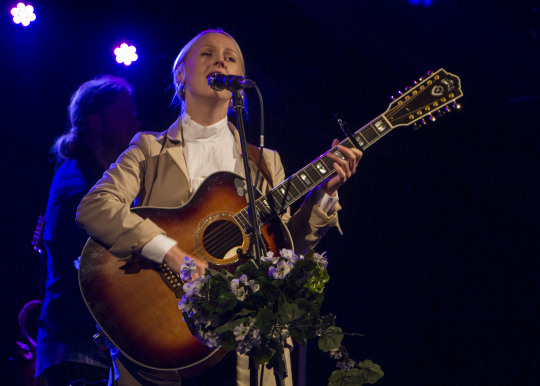
Alone with just her guitar, Marling returns to her earlier work with a delicate “What He Wrote”; another almost unbearably sad song illuminated by her delicate playing and a voice that barely rises above a whisper. Her one cover is Townes Van Zandt’s “For The Sake of the Song”, immaculately played and as dark as her own work, but before the band return, she does allow in some light in with the beautiful “Daisy”. Despite the loss and regret in the lyrics, the pace quicker is a little for “How Can I?” but the mood of quiet reflection returns for other songs from previous albums until she concludes with “Rambling Man”, for once the rhythm in the song being allowed to assert itself without being constrained. There was no encore, but then there didn’t need to be, the set had been pretty well perfect as it was and her songs wouldn’t lend themselves to one anyway. Seeing her at Latitude three years ago, she didn’t quite manage to overcome the scale of the largest stage and fond it difficult to draw the audience in. Now, her stage presence is more assured, her oblique and intense songs are some of the best she has written and in front of a smaller audience who were there to listen, she was mesmerising. A wonderful end to the festival.

As a performer, Kate Rusby is pretty much the opposite of the headline; with her roots in Barnsley, she retains a strong Yorkshire accent despite her years in the business and this gives a down to earth demeanour for the story telling that intersperses the songs. As a mother of two children, her husband Damien O’Keane leads the backing band, she is keen to share her experiences of the joys and challenges of parenthood as well as setting the context for the songs. With the late arrival of their bass player, he gets there just as they make their way onto the stage, she sings the first of these unaccompanied as he sets up. “Yorkshire Couple” is the funny and twisted story of Martha and Amos; approaching retirement Amos learns of the unexpected consequences of his repeated infidelities. Rusby encourages the audience to participate in the final repeated line of each verse, something that she will do throughout the set. With the full band in place, the tardy bass player is immediately called upon to provide the percussive introduction to “Benjamin Bowmaneer”’, a traditional song about how the trivial start to a war can eventually consume the whole country. The subtle accompaniment gives a beautifully sparse setting for Rusby’s wonderfully expressive voice which draws out the tender sadness of the song. The sensitivity of her voice is perfect for the longing in songs such as “The Hunter Moon” and “The Ardent Shepherdess” whilst adding a haunting intimacy to “Life in a Paper Boat”, her response to seemingly endless images of refugees crowded onto the boats that they hope will take them to a better life. Searching for answers, she knows that there aren’t any and as a writer with disarming honesty she acknowledges that “all I have is a song”. The highlight, however, is “Who Will Sing Me Lullabies”; a song written a few years ago that works as a heartbreaking response to mothers carrying what look like bundles of rags that turn out to be their dead children. A rich and varied set where her gift for humour faultlessly counters the often harrowing stories in her songs.
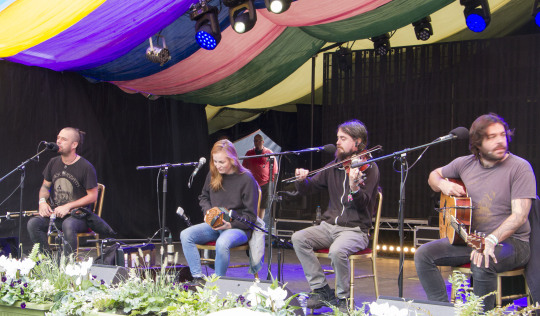
With his band Idlewild, Roddy Woomble headlined the festival two years ago where the enthusiasm of the response to their anthems led to the spectacle of a mosh pit at a folk festival. With the band paying the bills, Woomble is now over a decade into a solo career that has seen him recently release his third album. On a dreary late evening with the audience recovering from the hoedown that is always a feature of the Sunday afternoon, this was never going to generate that level of excitement but he does cope with the weather and the distractions to hold a sizeable audience around the stage. With a light country rock setting, his solo work seems more personal than the widescreen anthems of Idlewild although after a while it does all start to sound very similar. Earlier in the day, the line-up included various forms of more traditional folk from the angry punk of Lankum to the soft harmonies of The Furrow Collective. The Destroyers anarchic sound is described in the programme as Balkan Brass but that doesn’t really begin to cover the array of influences they draw on. Their punk infused jazz polka even brings in those waiting by the other stage for the quiet restraint of Laura Marling and the randomly choreographed moves are just about contained by the small Lunar Stage. Earlier in the day, Nifeco Costa was the one of the few African acts this year and his intricate finger picking and melodious jazz formed a bright groove that deserved a sunnier setting.
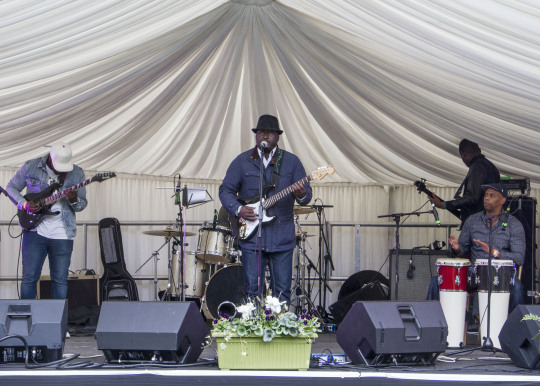
In the short gap between acts, the organisers took the opportunity to advertise the Beyond the Tracks event that is happening in about two weeks. This seems to have drawn some of the indie pop acts that sometimes find their way onto the Folk Festival line-up, The Coral who played here last year feature on the Saturday, and the effect of this seems to have been to return Moseley more strongly to its folk roots. The result of this was that at first the line-up seemed a little underwhelming, I remember having a conversation with someone on twitter along these lines at the time . In truth, some of this did remain, the Sunday afternoon in particular did drag a little, but the festival still managed to achieve what it always does, reminding me how good the acts are I already knew and introducing me to some new ones. That list then; the five best of the weekend:
John Moreland Courtney Marie Andrews Michael Chapman Laura Marling and in their 50th year it was a privilege to finally see Fairport Convention.
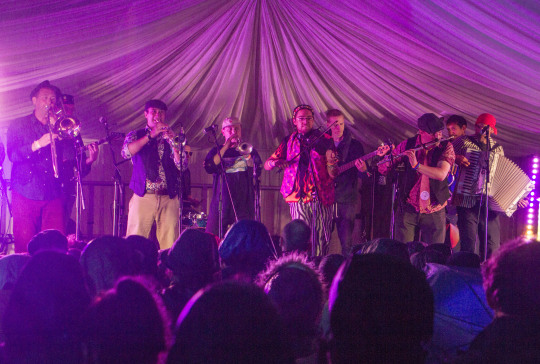
0 notes